
© 2017 The Association for Water and Rural Development
RESILIM-O: Resilience in the Limpopo Basin
Program–Olifants
FINAL REPORT
Agricultural Support Initiative- Lower Olifants; November 2016-
October 2019
30/10/2019

RESILIM-O: RESILIENCE IN THE LIMPOPO BASIN PROGRAM–OLIFANTS
| 2
Acknowledgements
MDF is extremely grateful for this opportunity provided by USAID and AWARD to explore and implement
models, processes and practices in community level climate change adaptation and to build a body of
knowledge on the impact of climate resilient agriculture on the livelihoods of the rural poor.
Authors
Erna Kruger, Betty Thobeka Maimela and Derick du Toit
Association for Water and Rural Development (AWARD)
P O Box 1919
Hoedspruit 1380
Limpopo, South Africa
T 015-793 0503
W award.org.za
Company Reg. No. 98/03011/08
Non-profit org. Reg. No. 006 –821

RESILIM-O: RESILIENCE IN THE LIMPOPO BASIN PROGRAM–OLIFANTS
| 3
About USAID: RESILIM
USAID’s Resilience in the Limpopo River Basin (RESILIM) program addresses ongoing degradation in the
Limpopo River Basin in southern Africa, where people face water shortages, increased floods, and declines
in crop productivity as climate change further stresses an already water limited region.
There are two components to the program; one operating at a basin-scale (RESILIM-B, which is
implemented by USA-based Chemonix and addresses similar issues at the scale of the four SADC member
states that share the Limpopo Basin (South Africa, Botswana, Zimbabwe and Mozambique) and a
catchment-scale project (RESILIM-O) that is being implemented by the Association for Water and Rural
Development (AWARD). Both projects share the same overall objectives. You can find out more
information on the RESILIM projects on www.usaid.gov website and www.award.org.za.
The USAID’s RESILIM-O focusses on the Olifants catchment. The program aims to reduce the vulnerability
of people and ecosystems in the Olifants Catchment specifically, by improving how transboundary natural
resources are managed. By understanding the systemic causes of vulnerability, including climate
vulnerability, it is promoting new ways of thinking and acting to promote integrated water and
biodiversity management.
About AWARD
At AWARD, we recognize that the natural world’s resources are limited, andundergoing rapid depletion
and transformation. We know current practices of use and management are inadequate to deal with the
changes and challenges we are facing. We design practical interventions to address the vulnerability of
people and ecosystems, and merge considerations from both environmental and social perspectives. Our
approach involves thinking across disciplines, boundaries and systems.
We are working with diverse people and institutions in the water and biodiversity sectors in the Olifants
River Catchment to understand the multiple vulnerabilities to change, including climate change. Along
with quality scientific contributions, our engagement in the socio-political context of the Olifants River
Catchment allows us begin to begin to institutionalize integrated, resilience-based practices, providing a
foundation for robust development policy and practice in the in this river catchment, and beyond.

RESILIM-O: RESILIENCE IN THE LIMPOPO BASIN PROGRAM–OLIFANTS
| 4
The Olifants Catchment: An Overview
The Olifants River Catchment falls within the Limpopo RiverBasin, which is part of an international
drainage basin that stretches across South Africa, Mozambique, Zimbabwe and Botswana. In fact, the
Olifants River contributes nearly 40% of the water that flows in the Limpopo River making it an important
catchment in the system as a whole.
At the heart of this catchment is the Olifants River, a vital artery that flows for 560 kilometres through
South Africa and into Mozambique, where it is known as the Rio dos Elefantes in Mozambique.
This mighty river originatesin South Africa’s Mpumalanga Highveld, flowing northwards before curving in
an easterly direction through the Kruger National Park and into Mozambique, finally finding rest in the
salty water of the Indian Ocean near Xai Xai, just north of Maputo.
The main tributaries of the Olifants River are the Wilge, Elands, Ga-Selati, Klein Olifants, Steelpoort,
Blyde, Klaserie and Timbavati Rivers.
Along with its tributaries, it is one of the six major Lowveld river systems, occupying an area just short of
55 000 sqaure kilometres. It traverses three provinces in South Africa; Gauteng, Mpumalanga and Limpopo.
About 3.5 million people live on the South African side of the catchment. In Mozambique, it flows through
Gaza Province, which is home to about 700 000 people.

RESILIM-O: RESILIENCE IN THE LIMPOPO BASIN PROGRAM–OLIFANTS
| 5
A system under change
Our catchment is the foundation of our livelihoods and development. Yet the river and associated natural
resources in the Olifants Catchment are under threat...
Unchecked pollution, inappropriate land resource use, weak and poorly enforced policies and regulations
and poor protection of habitats and biodiversity are degrading the Olifants at an alarming rate. What’s
more, the area is however under threat from factors such as mining for heavy metals, inappropriate land
management, rural sprawl and unsustainable use of natural resources. This affects the level of goods and
services provided by the ecosystem.
The diverse population groups living in the Olifants Catchment all have one thing in common; they rely on
the river and the catchment’s natural biodiversity for their livelihoods. This reliance can be direct or
indirect. Rural communities rely on it for things such as traditional medicine, grazing and browse, fuel,
food and housing materials. Some people in river-side communities harvest reeds, collect water from the
river for washing and drinking and use it for recreational and spiritual practices. Subsistence farmers in
Mozambique rely heaving on the catchment’s flood plains. There are also large mines and associated
industries, large scale agriculture and the wildlife economy, which all rely on a healthy, functioning river
system. Often people forget that what they do upstream affects people down stream, sometimes with dire
consequences.
The catchment is our home and it is worth investing in its future. The work reported here is part of the
activities of the RESILIM- O project under the grant from USAID: Southern Africa.
Project partners
Mahlatini Development Foundation (MDF) is a small public benefit non-profit organization consisting of rural
development practitioners who specialize in participatory learning and action processes, sustainable natural
resource management and low external input farming systems, including a focus on rain water harvesting,
conservation agriculture,intensive homestead food production, food security,climate change adaptation,
micro finance and enterprise development.
MDF designs and implements rural development programs and training processes providing learning
processes for adults all the way from semi-literate farmers to post graduate university level. We work in
partnership with government and non-government organisations alike. We are sensitive to and mainstream
where possible gender, disability and people living with HIV/AIDs.

RESILIM-O: RESILIENCE IN THE LIMPOPO BASIN PROGRAM–OLIFANTS
| 6
Contents
1 Executive Summary......................................................................................................7
2 Project Objectives.......................................................................................................7
2.1 RESILIM-O KRA objective......................................................................................... 10
2.2 Project objectives................................................................................................ 10
3 Approach/ Process/ Activities ....................................................................................... 11
3.1 Project theory of change........................................................................................ 11
3.2 Summary of activities.......................................................... Error! Bookmark not defined.
4 Results................................................................................. Error! Bookmark not defined.
4.1 Project outcomes and impact................................................. Error! Bookmark not defined.
4.2 Sustainability of impact....................................................... Error! Bookmark not defined.
4.3 Indicator data................................................................... Error! Bookmark not defined.
4.4 Successes and challenges...................................................... Error! Bookmark not defined.
4.5 Key learnings.................................................................... Error! Bookmark not defined.
4.6 Communication materials..................................................... Error! Bookmark not defined.
4.7 Other outputs ................................................................... Error! Bookmark not defined.
5 Conclusions and Recommendations ............................................... Error! Bookmark not defined.
6 Appendices........................................................................... Error! Bookmark not defined.

RESILIM-O: RESILIENCE IN THE LIMPOPO BASIN PROGRAM–OLIFANTS
| 7
Acronyms and Abbreviations
AgriSIAgricultural Support Initiative
CC Climate change
CCA Climate change adaptation
CRAClimate resilient agriculture
CSAConservation South Africa
CWP Community Work Program
DICLADDialogues in Climate Change and Adaptation
DKA German Catholic Church Fund
K2CKruger to CanyonProgram
hh household
LIMA Lima Rural Development Foundation (NGO)
LF local facilitator
MDF Mahlathini Development Foundation (NGO)
NTTNational Toyota Trust
RIEngRural Integrated Engineering (Company)
RWHRainwater harvesting
SESSocioeconomic system
SOL Seeds of Light (NGO)
S&WCsoil and water conservation
1Executive Summary
The Agricultural Support Initiative (AgriSI) was implemented as a sub-grant process within the larger
RESILM-O programbetween 2017 and 2019.
The aim of this support was to enhance the resilience of the people and ecosystems in selected villages
(5-7) in the Lower Olifants River basin, using a systemic social learning approach, providing support for
increased adaptive capacity and resilience to the effects of climate change for households involved in
agriculture in selected communities of the Lower Olifants River Catchment through:
-Improved soil and water conservation and agroecologicalpractices for increased food security,
-Livelihood diversification and supplementation through alternative climate resistant production
-and Increased community empowerment as a result of self-organisation and collective action.
The expected Outcomes outlined in our theory of change are summarised as:
➢Community level analysis and increased understanding of climate change, CC impacts and
adaptive measures (Baselines, planning and reviews)
➢Capacity building for learning groups and Local Facilitators (learning workshops)

RESILIM-O: RESILIENCE IN THE LIMPOPO BASIN PROGRAM–OLIFANTS
| 8
➢Increased awareness and community level organisation; collective action and collaborative
activities (collaborative activities)
➢Improved, diversified production. Soil and water conservation practices implemented. (Improved
productivity and livelihoods)
➢Monitoring of implementation of best practices at household level. Identification and awareness
raising around local and new best practice options (review sessions and open days).
The activities related to these outcomes (indicated in italics)are somewhat cyclical in nature and
depended on the focus, interest and motivation of the membersof each learning group.
Climate change impacts of increased heat (throughout the year) and increased variability in rainfall
patterns with associated decrease in water availability, crop failures, livestock mortality and increased
pest and disease incidence as well as the decrease in natural resources, were strongly perceived by the
participants. The negative impact on participants’livelihoods and the social fabric of their communities
was also emphasised.
Baselines indicated a high level of vulnerability of these households with a high dependency on social
grants, low incomes (averaging around R2300/ household of 5 members), decreased production and
productivity, with little to no livelihood diversification.
Local adaptive measures were grouped around the simple heuristic of ‘5 fingers (see diagram below). This
means that agroecology practices could be grouped into 5 key categories of water management, soil
fertility, crop and seed choices, erosion control and indigenous plant incorporation. Specifically,
adaptation practices included the use of compost basins for planting bananas, planting of indigenous
trees, change for dryland cropping patterns, small dams and greywater use.

RESILIM-O: RESILIENCE IN THE LIMPOPO BASIN PROGRAM–OLIFANTS
| 9
The five fingers approach categories agroecological practices into 5 main groups.
Adaptive measures suggested and explored included; shade cloth tunnels, drip irrigation, mulching, mixed
cropping, trench beds and other beds with increased organic matter and water holding capacity, crop
diversification, conservation agriculture (including legumes and cover crops), seed saving, cropping
calendars, livestock fodder production, poultry and organic fruitproduction, soil and water conservation
practices, rainwater harvesting, small dams and greywater management and use.
Practices were implemented by individuals and small groups through local level experimentation. Of the
new interventions, the highest uptake of practices was for trench beds (86%) and mixed cropping (82%);
followed by stone bunds (61%), planting from seed (50%) and liquid manure (43%). Mulching levels were
low (32%), due to lack of mulching material in the environment. The extended drought, heat and lack of
agricultural water supply led to very little natural vegetation being at hand for this practice.
A few practices did not “stick” despite our efforts of introduction and re-introduction of these ideas.
These include making eco-circles, which use a bottle drip system and soil and water conservation
practices such as swales, diversion ditches, contours, furrows and ditches and checkdams . The use of
natural pest and disease control and conservation agriculture for field crops can also stillbe improved.
These practices are all considered knowledge intensive, as farmers need to internalise a number of
different concepts to work well with these practices and additionally have to use their own analysis and
judgement in the implementation.
The new innovations; shade cloth tunnels (35%), bucket drip kits (35%),rain water harvesting (RWH)
storage (underground RWH tanks, surface reservoirs and small dams)(24%) and small dams lined with
bentonite, were limited to participants who received some financial assistance and those who could afford
to try out these practices themselves. It was however considered important to introduce these ideas, due
to their potential for impact on resilience.
Local good practice options, show that all the participants have tried some version of RWH, around 76%
do seed saving and around 64% engage in propagation of multi-purpose plants, with fewer engaging in
greywater management (46%), planting of legumes (38%), construction of furrows and ridges for planting
(31%), and construction of basins filled with organic matter to plant bananas (18%).
Livelihoods diversification has been noted as the following activities, directly related to this intervention:
➢Increased diversity of cropping for food production and local sales; 66% of participants.
Participants have included a wider range of vegetable types for both summer and winter cropping,
have expanded their field cropping options and have been growing a range of culinary herbs.
➢Organic marketing of herbs and vegetables; 21% of participants.
With the assistance of Hoedspruit Hub (HH) participants have engaged in an “organic box
scheme”, managed through a Facebook page at HH. They have also been selling independently to
a few lodges, restaurants and farmers markets.
➢Processing; drying, milling, juice and bottling; 9% of participants.
This activity, although considered a good idea, has been quite limited in implementation. Only a
few of the inherently more innovative participants have undertaken these activities.
➢Diversification into small livestock; 16% of participants
Two groups of participants linked to learning groups have undertaken poultry initiatives; one for
layers and one for broilers –assisted through increased incomes through their vegetable
production as well as increased confidence in farming activities derived from their participation in
the AgriSi program.

RESILIM-O: RESILIENCE IN THE LIMPOPO BASIN PROGRAM–OLIFANTS
| 10
A significant step in improved social agency has been the initiation of water committees within three of
the seven learning groups (including 98 participants) to explore and implement water provision systems for
agricultural activities.
Learning has been substantial and ongoing and was further supported through cross visits, networking and
stakeholder engagement at local and regional levels. A total of around 150 participants have been
involved over the project period across 9 village-based learning groups.
Improved resilience has been achieved using the following indicators:
➢86% (N=120) of participants implemented more than 3 climate change (CC) adaptation responses,
➢44% show increased knowledge (using farmer experimentation as a proxy),
➢41% have engaged in collaborative activities,
➢77% have indicated an increased availability of food,
➢56% have indicated an increase in income and
➢30% have indicated an increase in livelihood diversification.
Food production through gardening has increased by 120%, field cropping by 15% and livestock production
by 9%. Water use efficiency (access, availability, water holding, water saving) has increased by 45% and
participants have indicated a strong sense of improved decision-making capacity and a positive mindset
towards their future.
In summary participants have managed to improve and diversify their livelihoods through implementation
of CCA practices, collaborativeactivities and building social agency. They have significantly improved
their resilience to climate change.
2Project Objectives
2.1RESILIM-O objectives
USAID: RESILIM-O is a large multi-faceted, multi-stakeholder, cross-boundary program to reduce
vulnerability to climate change through building improved transboundary water and biodiversity
governance and management of the Olifants Basin through the adoption of science-based strategies that
enhance the resilience of its people and ecosystems through systemic and social learning approaches. The
program has been running for seven years and is being implemented by AWARD (The Association for Water
and Rural Development) with fundingfrom USAID.
The Agricultural Support Initiative (AgriSI) was implemented as a sub-grant within the larger program
towards the end of 2016. This initiative works specifically with climate change adaptation processes with
smallholder communities in the lower Olifants River basin. It is being implemented jointly by Mahlathini
Development Foundation and AWARD.
The Agricultural Support Initiative (AgriSI) addresses two of the USAID:RESILIM-O program objectives
directly:
i. To institutionalize systemic, collaborative planning and action for resilience of ecosystems and
associated livelihoods through enhancing the capacity of stakeholders to sustainably manage natural
resources of the Olifants River Basin under different scenarios
ii. To reduce vulnerability to climate change and other factors by supporting collective action, informed
adaptation strategies and practices and tenable institutional arrangements.

RESILIM-O: RESILIENCE IN THE LIMPOPO BASIN PROGRAM–OLIFANTS
| 11
2.2Project objectives
The overarching goal of the program is to support marginalised communities in the preparation for climate
change. This means that communities need to be able to adapt and respond to local contextual factors. In
the context of this project sound agroecological practices for soil and water conservation (SWC) and the
ability to self-organise and act collectively are regarded as fundamental for building adaptive capacity and
resilience to climate change. Not only do agroecological farming approaches require minimum external
inputs –which may be expensive and increase dependency if subsidized – but they foster farmers’ sense
that they can build sustainable futures from local inputs and efforts. With knowledge about the potential
impacts of climate change included in the learning journey, farmers can make purposeful decisions around
a spectrum of practices such water management, soil fertility and choice of seed and crop-type. This
approach also supports livelihood diversification through the provision of additional sources of income –
also fundamental for increased resilience.
The overall aim of the Agricultural Support Initiative is to enhance the resilience of the people and
ecosystems in selected villages (8) in the Lower Olifants River basin, using a systemic social learning
approach, exploring the question:What are you learning about the socio-economic and biophysical
characteristics of your environment, how these are changing and how are you able to respond to that?
The overarching objective of this work is to provide support for increased adaptive capacity and resilience
to the effects of climate change for households involved in agriculture in selected communities of the
Olifants River Catchment through:
-Improved soil and water conservation and agroecological practices for increased food security;
-Livelihood diversification and supplementation through alternative climate resistant production;
-And increased community empowerment as a result of self-organisation and collective action.
The expected Outcomes outlined in our theory of change are summarised as:
➢Community level analysis and increased understanding of climate change, CC impacts and
adaptive measures (Baselines, planning and reviews)
➢Capacity building for learning groups and Local Facilitators (learning workshops)
➢Increased awareness and community level organisation; collective action and collaborative
activities (collaborative activities)
➢Improved, diversified production. Soil and water conservation practices implemented. (Improved
productivity and livelihoods)
➢Monitoring of implementation of best practices at household level. Identification and awareness
raising around local and new best practice options (review sessions and open days).
The activities related to these outcomes (indicated in italics) are somewhat cyclical in nature and
depended on the focus, interest and motivation of the membersof each learning group.
3Approach/ Process/ Activities
3.1Project theory of change

RESILIM-O: RESILIENCE IN THE LIMPOPO BASIN PROGRAM–OLIFANTS
| 12
The Theory of Change (Figure 1) captures the key pathways to the intended outcomes. More detail is
provided in Table 1 regarding the chronology of activities, outcomes, indicators and targets for each
objective.
Table 1: Theory of change for the AgriSI Lower Olifants project (November 2016-October 2019), including outcomes,
indicators and targets linked to the objectives
Although water security was not emphasised at the onset of the process, it was a central theme, without
which increased food security in these land-based livelihoods systems is all but impossible. A substantial
focus on water security thus developed within the program implementation process.
Figure 1: Project Theory of Change
Increased resilience to the effects of
climate change at the household
level in target communities
Increased food
security at
household level
Family livelihoods
diversified and
supplemented through
alternative climate
resistant production
Increased community
empowerment
through self-
organisation and
collective action
Training
Skills transfer
Demonstration Plots
Climate-change literacy
Agro-ecological processes and inputs
Group Formation and action
Climate Smart Agriculture Champions
Climate change
Literacy and adaptation
enhanced

RESILIM-O: RESILIENCE IN THE LIMPOPO BASIN PROGRAM–OLIFANTS
| 13
THEORY OF CHANGE:
Overall
Objectives
To institutionalize systemic, collaborative planning and action for resilience of ecosystems and associated livelihoods through
enhancing the capacity of stakeholders to sustainably manage natural resources of the Olifants River Basin under different
scenarios
To reduce vulnerability to climate change and other factors by supporting collective action, informed adaptation strategies and
practices and tenable institutional arrangements
AgriSI Objective
To provide support for increased adaptive capacity and resilience to the effects of climate change for households involved in
agriculture in select communities of the Lower Olifants River Catchment
Objectives
Key
activities
Activities
Outputs/
milestones
Outcomes/
deliverables
Verifiable
indicators
Climate
change
indicators
Targets
Increased
community
empowerment as
a result of self-
organisation and
collective action.
Visioning and
decision
support
Initial introductions,
baseline information,
climate, soil and water
mapping (past, present,
future),
Community
participation
profiles. Baselines for
all participating
households.
Community level analysis
and increased
understanding of climate
change. Linkages with
local stakeholders
Baseline reports
for all villages
2:4.8.2-14: Using
CC information or
vulnerability
assessments to
inform decisions
and actions.
Developing a plan
of action to
respond to and
build resilience to
climate change
impacts.
120participants
Visioning and scenario
development
Climate change maps
for participating
villages
Exploration of the SES
under different future
scenarios, collaborative
understanding of climate
change impacts.
2-3 Scenarios
developed at a
local level with
baskets of
options for best
practice
Climate change
adaptation
scenarios and
decision -making
reports -x 3
Learning group and Local
facilitator (LF)
mentoring and support
Learning groups and
local
facilitators/champion
s identified,
functioning and
agency developed
Capacity building for
learning groups and LFs;
including savings, group
activities, water
committees, community
awareness
Progress reports
6-7 learning groups
6 CC champions
(LFs)
Networking
and cross
visits
Seasonal review and
planning sessions for
each learning group.
Open days for
showcasing activities and
creating awareness in
the broader community.
Seasonal review and
planning sessions.
Open day programs
and events.
Increased awareness and
community level
organisation; collective
action
Seasonal review
and planning
reports (x6).
Open day
programs and
summary
reports (4)
3:4.8.2-26. Number
of stakeholders
with increased
capacity: use
climate information
in decision making;
With increased
35% of participants
show increased
knowledge and
response

RESILIM-O: RESILIENCE IN THE LIMPOPO BASIN PROGRAM–OLIFANTS
| 14
Cross visits between
learning groups in the
lower and middle ORB
and linking to and taking
part in other stakeholder
networking activities
Cross visits
conducted inside the
ORB (2-4)
Cross visit
summary
reports (2-4)
knowledge of
climate change
impacts and
response options.
Improved soil
and water
conservation and
agroecological
farming
practices for
increased food
security
Learning and
mentoring
7x day practical
homestead -based
learning sessions (in soil
and water conservation,
intensive homestead
food production and
conservation agriculture)
for each of 5-7 learning
groups.
Training outlines,
handouts, materials
and reports (6 groups
x 6 trainings)
Improved, diversified
production. Soil and
water conservation
practices implemented.
Training
reports.
Gardening
monitoring
reports.
Attendance
registers.
45% of participants
implement at least
1 CC adaptation
response, 25% of
participants
implement 2-3
responses and 5-10%
implement >3. Final
training manual by
April 2017
Ongoing mentoring and
monitoring with further
learning and support
activities as required
and requested (1
day/month x 32
months).
Introduction,
demonstration and
piloting of best
practice options (new
and local ideas)
Monitoring of
implementation of best
practices at household
level. Identification and
awareness raising around
local and new best
practice options (at least
4 identified and
introduced)
Photo diaries,
case studies,
B2O reports
3:4.8.2-26. Number
of stakeholders
with increased
capacity: use
climate information
in decision making;
With increased
knowledge of
climate change
impacts and
response options;
Stakeholders
implementing
water saving
strategies;
Individuals
diversifying
incomes towards
6 case studies
developed
Livelihood
diversification
and
supplementation
through
alternative
climate resistant
production and
alternative
income
production
options
Focus sessions on
climate change aspects
and considerations to be
included here (3/year).
Reports on 6
focus sessions,
that include at
least 4 new and
or local best
practice
options.
6 CC w/s impact
summaries

RESILIM-O: RESILIENCE IN THE LIMPOPO BASIN PROGRAM–OLIFANTS
| 15
Experimentati
on and
introduction
to innovations
Individuals undertake
experiments with
qualitative and
quantitative monitoring.
S&WC and
agroecological
practices
implemented and
monitored for at
least 100 individuals
Monitoring of
implementation of best
practices at household
level. Final review and
reporting of the
experimentation and
implementation process.
Individual
experimentation
plans, and
garden
monitoring
reports
less climate
sensitive activities
Best practice
booklet (including
cropping calendars)
by July 2018
Visits from local
facilitators/champions
and ongoing homestead
food production
monitoring (monthly for
each participant).
Local facilitator
monthly
timesheets,
photos
Collaborative
work
Learning groups
undertake joint soil and
water conservation
works in teams and
implement planned
activities for all
households (3
days/month). Provision
of technical and limited
infrastructural support
and incentives for these
activities.
S&WC and practices
implemented and
monitored for
learning group teams
Collaborative work
strengthens local
organisational and
facilitation capacity
Collaborative
S&WC works
catalogued and
reported on.
(Min of 3 sites)
35% of participants
engage in
collaborative work
at least once.

RESILIM-O: RESILIENCE IN THE LIMPOPO BASIN PROGRAM–OLIFANTS
| 16
3.2Summary of activities
The overall structure of activities was based on the following:
➢Conduct climate change and adaptation exploration with voluntary groups in 8 villages, linked to
the development of baselines (household visits and individual interviews) as well as adaptive
strategies and practices for each of the groups;
➢Set up learning groups, identify local facilitators and conduct a minimum of 7 learning workshops
with each group in agroecological and soil and water conservation practices;
➢Set up collaborative activities and individual farmer level experimentation processes (linked to the
adaptive strategies for each village and the learning workshops);
➢Provide mentoring and monitoring for the individual and group activities and undertake seasonal
review and re-planning processes for each group, building in new activities and learning along the
way (inclusive of livelihoods diversification) and
➢Build social agency through cross-visits, open days networking, stakeholder engagement and
learning group actions.
These activities are somewhat cyclical in nature and depended on the focus, interest and motivation of
the learning group members.
The table below provides a brief summary of activities for each of the village learning groups.
Table 2: Summary of activities for the AgrSI Lower Olifants program; 2017-2019
Activity
Description
Village Learning
Groups
Climate change and
adaptive strategy
development
workshops and
individual baselines
*2 Day workshops; CC understanding and concepts,
impacts, past, present and future farming scenarios,
adaptive strategies and prioritization of practices (initial
round)
*Individual interviews and hh visits for development of
baselines
*DICLAD workshops 1-3 for all villages
Sedawa, Botshabelo,
Mametja Willows, The
Oaks, Lepelle,Fenale
Turkey 1 and 2, Loraine
(Sekororo)
Learning workshops
*Soil management: Nutrients, composting, liming trench
beds, shallow trenches, eco-circles,furrows and ridges,
banana basins,mulching, run-on ditches, contours, line-
levels, A-frames, check-dams, swales, stone lines,
*Water management: Greywater (filtration, use, tower
gardens), rain water harvesting, small dams,
*Microclimate management and irrigation: Building of
small shade cloth tunnels and bucket drip kits, irrigation
scheduling
*Crop management: Mixed cropping, new crops (total of
21 introduced), herbproduction, natural pest and
disease control,conservation agriculture (intercropping,
legumes, cover crops), fruit production, organic mango
production, cropping calendars, seed saving,
Sedawa (Chirstina
Thobejane, Alex
Magopa), Botshabelo
(Mariam Malepe),
Mametja (Magdelina
Malepe) Willows (Melida
Shaai, The Oaks
Florence Lewelle),
Fenale, Lepelle (Josias
Sebuyane,Patricia
Ngobeni), Turkey 1 and
2(IsaacMalatji,
Matshego Shaai)

RESILIM-O: RESILIENCE IN THE LIMPOPO BASIN PROGRAM–OLIFANTS
| 17
*Natural resource management: Propagation of
indigenous trees and plants (fruit, shade, medicinal),
management of burning and chopping of trees for
firewood
*Livestock management: Poultry production, chicken
tractors, production of poultry feed, livestock fodder
production, agroforestry options
Collaborative
activities and
individual farmer
level
experimentation
*Experimentation by around 75 individuals
*Shade cloth tunnels for 36 individuals, bucket drip kits
for 46 individuals
*3 Underground RWH tanks built with DKA assistance
*Organic marketing initiative with Hoedspruit Hub (28
participating farmers) including vegetables, herbs and
mangoes
Sedawa, Botshabelo,
Mametja Willows,
Fenale, Lepelle, Turkey
1 and 2
Sedawa, Mametja,
Botshabelo
Sedawa, Mametja,
Turkey, Willows
Mentoring and
monitoring
*Garden monitoring forms-filled in for 100 individuals
over time, by LFs and field workers
*Resilience snapshots–for impact of practices for 30
individuals
*Seasonal review and re-planning sessions; x 15
Sedawa, Botshabelo,
Mametja Willows, the
Oaks, Fenale Lepelle,
Turkey 1 and 2
Social Agency
*Cross visits between Lower Olifants villages x 8
*Cross visits between Sekhukhune and Lower Olifants x 2
*Open days x 2
*Networking; Agroecology network meetings x 3
*Stakeholder engagement: K2C, CWP, SOL, Limpopo Dept
of Agriculture, CSA
*Water committees; local supply and management of
agricultural water supply
Sedawa, Botshabelo,
Mametja Willows,
FenaleLepelle, Turkey 1
and 2
Lepelle, Sedawa and
Turkey
Below are photographs of the above-mentioned activities
3.2.1Climate change adaptation workshops and baselines

RESILIM-O: RESILIENCE IN THE LIMPOPO BASIN PROGRAM–OLIFANTS
| 18
Botshableo CC workshop and joint group review of five fingers indicator framework
DICLAD workshop CC impacts (Sedawa), Turkey CC workshop, Sekororo rainfall and temperature
calendar
Baseline visits; local best practice; Banana basins, small dams and indigenous fruit trees (Dikgogoma)

RESILIM-O: RESILIENCE IN THE LIMPOPO BASIN PROGRAM–OLIFANTS
| 19
3.2.2Learning workshops
Tower garden (Fenale) and check dams (Turkey 1)
CA planter Mametja, drip kits Mametja
Small Dams (Turkey 2), Organic Mango Production (Lepelle), cropping calendars (Turkey 1
Run-on ditches (Botshabelo), trench beds (Willows), stone lines (Lepelle)

RESILIM-O: RESILIENCE IN THE LIMPOPO BASIN PROGRAM–OLIFANTS
| 20
3.2.3Collaborative activities
3.2.4Social agency
Construction of tunnels (Willows), Underground RWH tanks (Sedawa), Organic marketing
(Hoedspruit Hub)
Water committee and learning group mapping out water supply options and doing a scouting
exploration for water sources in the mountain
Village level cross visit to Turkey, Seasonal group review session and Alex Makgopa reporting back
to the learning group form a cross visit to Sekhukhune

RESILIM-O: RESILIENCE IN THE LIMPOPO BASIN PROGRAM–OLIFANTS
| 21
4 Results
4.1Project outcomes and impact
The Agri SI process was designed as a sequence of activities involving farmer participants, facilitators and
resource persons. Activities followed the chronology outlined below:
➢Understanding current practices,
➢Develop a vision of what could be,
➢Discuss innovations and agree to try; sometimes with collaborative work,
➢Develop a farm design and plan that includes experimentation with new ideas,
➢Ongoing mentoring of implementation and experimentation
➢Periodic cluster sessions,
➢Periodic monitoring and self-assessment
➢And networking and cross visits (1 of each per year)
Outcomes suggested in our theory of change are summarised again here, for purposes of clarity:
➢Community level analysis and increased understanding of climate change, CC impacts and
adaptive measures(Baselines, planning and reviews)
➢Capacity building for learning groups and Local Facilitators (learning workshops)
➢Increased awareness and community level organisation; collective actionand collaborative
activities (collaborative activities)
➢Improved, diversified production. Soil and water conservation practices implemented.(Improved
productivity and livelihoods)
➢Monitoring of implementation of best practices at household level. Identification and awareness
raising around local and new best practice options(review sessions and open days).
4.1.1Community level analysis and increased understanding of climate
change
Baselines were constructed for each of the 8 villages through focus group discussions, individual interviews
and household ‘walkabouts’; starting with an exploration of climate change impacts and adaptive
strategies and past, present and future farming activities as seen by the participants.The outlines of
processes and interviews are provided in Attachment 1.
4.1.1.1FOCUS GROUP DISCUSSIONS (CLIMATE CHANGE ADAPATATION DIALOGUES)
Facilitation steps used in the focus group discussions were:
1. Contextualization: Natural resources; need to look at climate change projectionsfor
KZN/EC/Limpopo, and discuss with people how these will affect them Tools; A4 impact pictures or a
Power Point presentation –of floods, droughts, erosion, declining natural resource base, declining
yields, …)
2. Look at the difference between variability in weather and climate change. There is variability in
weather and there is also a major change in that variability in weather, predictions and certainty
(Tools; role play- Phone call; weekend visit vs moving to an area)
3. Exploration of temperature and rainfall and participants’ understanding of how these are changing
(Tool: Seasonal diagrams on temperature and rainfall –normal and how these are changing)
4. Timeline in terms of agriculture (Tool: livelihoods and farming timelines -assessment of past,
present and future)

RESILIM-O: RESILIENCE IN THE LIMPOPO BASIN PROGRAM–OLIFANTS
| 22
5. Reality Map: Changes (in natural resources), impacts (of changes), practices (past, present, future),
challenges/responses (Tool: Mind mapping of impacts)
6. Current practices and responses (effectiveness of responses) (Tool: outlining adaptive measures on
mind map)
Below is a summary of climate change impacts as mentioned in these discussions, across the 8 villages in
the Lower Olifants Basin.
Table 3: Climate change impacts summarised from baseline workshops for 8 Lower Olifants Basin villages (2017-2018)
Impacts of climate change on livelihoods and farming in the Limpopo Basin
Water
Less water in the landscape; streams and springs dry up, boreholes run dry, soils
dry out quickly after rain and dams dry up
Municipal water supply becoming more unreliable;
Need to buy water for household use –now sometimes for more than 6 months
of the year
RWH storage only enough for household use and for short periods
Soil
More erosion
Soils becoming more compacted and infertile
Soils too hot to sustain plant growth
Cropping
Can no longer plant dryland maize
All cropping now requires irrigation –even crops such as sweet potato
Drought tolerant crops such as sorghum and millet grow; but severe bird damage
Heat damage to crops
Reduced germination and growth
Seeding of legumes becoming unreliable
Lower yields
Winter vegetables don’t do well; stress induced bolting and lack of growth
More pests and diseases
Loss of indigenous seed stocks
Livestock
Less grazing; not enough to see cattle through winter
More diseases in cattle and heat stress symptoms
Fewer calves
More deaths
Natural resources
Fewer trees; too much cutting for firewood
Decrease in wild animals and indigenous plants
Increased crop damage from wild animals such as birds and monkeys
No longer able to harvest any resources due to scarcity
Increased population puts pressure on resources
Social
More diseases
Increased poverty and hunger
Increased crime and reduced job opportunities
Increased food prices
Increased conflict
Inability to survive
The severity of these changes is obvious in these villages and have been exacerbated by an extended
drought; where comments like “we will all die”, “we will need to move from here to the cities” and “it
feels like the end of the world is coming” were not uncommon.
People felt that they are being punished by God for the disintegration of their social fabric. They
mentioned that people no longer follow the old rules or keep to their traditional beliefs and taboos,
people do not care properly for their families and immorality, violence and theft are all too common.

RESILIM-O: RESILIENCE IN THE LIMPOPO BASIN PROGRAM–OLIFANTS
| 23
There is thus a tacit understanding that these social problems exacerbate their ability to survive well into
the future.
Potential adaptive measureswere discussed as an outcome of the impact mind map and participants
discussed in small groups possible practices and ideas which could help them adapt to the changes and
reduce the negative impacts of these changes.
Being practically minded, most of the participants moved straight from impacts to practices –so strategies
were not really discussed. Some of the groups had many ideas, some of which weregleaned from working
with support organisations and NGOs. Those groups where no external support is available, did not have
many ‘new” ideas, but focussed more on doing what they are currently doing, better.
Below is an example of this discussion for Turkey in Limpopo (with limited external support)
Table 4: An example of potential adaptive measures from the Turkey (Limpopo) climate change dialogue process
Turkey CC workshop; December 2017
Impacts
Description and
linkages
Outcomes
Potential adaptive measure
GROUP 1
Reduced
water
availability
Dams dry out,
boreholes provide less
water, rivers dry out,
less rain
Reduced
production,
hunger,
diseases, no
jobs, poverty,
crime, death
More boreholes, more dams, water
management, irrigation in evenings and
early morning, mulching, trench beds
(keep moisture in and soil cool)
Drying of
environment
Soils are hotter and
drier, drought, plants
wilt, increased pests
Save plant residues for animals, buy
fodder, control pests on animals
Reduction of
resources
Deforestation, Fruit
trees die, livestock,
wild animals die
Planting of trees after they have been cut
down; make use of paraffin stoves and
electricity, government involvement in
solving the problem,
GROUP 2
Extreme heat
Early fruiting, trees
wilt
Poor crop
health
Shade netting
Shortage of
water
Rivers dry out,
municipal supply only
once per week.
Boreholes dry out
Lack of
education
towards saving
water
NGOs and government to assist
Trench beds, mulching, save water in
dams, drip irrigation, irrigate in evening,
boreholes, greywater
Reduction of
resources
Less grazing, seed
shortage, trees are
removed, indigenous
animals are no longer
there
Donations for/of seed
Rather use paraffin stoves than firewood.
Only chop down mature trees to allow
others to grow, planting trees, government
intervention
Taking care of indigenous plants
Plant fodder for livestock
Soils
Poor cultivation
practices, soil erosion,
dry soils, sandy soils
Using crop residues and manure, practice
minimum tillage options
Social
repercussions
Less or no food, health
problems, no jobs
Burning of
buses, divorce,
separation of
families,
poverty, crime
Getting access to health care, parents
must work
Shortage of
implements
Setting up cooperatives for government
support, use animal drawn traction- oxen
and donkeys, improvise, make our own
tools, make use of hand hoes

RESILIM-O: RESILIENCE IN THE LIMPOPO BASIN PROGRAM–OLIFANTS
| 24
Based on the adaptive measures suggested and some input on potential implementation ideas, practices
were then divided into five themes (known as the five fingers analysis) and prioritized for action, using
community generated criteria
Table 5: Suggested practices for farmers, categorised into the 5 primary themes.
PRACTICES
Natural
Resource
Management
Soil
Water
Crops
Livestock
Tunnels/ shade cloth
Bed design
Mulching
Natural pest and diseases
Rainwater harvesting
Trench bed
Composting
Fodder crops
Underground water tanks, sand
dams
Mixed cropping
Conservation of wetlands and
streams
Burying of disposable pampers
Reducing burning of grazing veld
and cutting grass
Greywater Harvesting
4.1.1.2INDIVIDUAL INTERVIEWS AND HOUSEHOLD VISITS/ WALKABOUTS
The responses to these questionnaires were coded and analysed in excel sheets, to be able to summarise
information from a number of different participants and get an indication of the ‘profile’ of the
participants involved.Below is an example for Turkey 1 and 2.
4.1.1.2.1 Baseline information for Turkey (1 and 2)
Participants were visited in their homesteads and interviewed to glean information about their basic
socio-economic situations and their farming resources and practices. The small charts below outline the
summarised information.
Table 6: Socio-Economic information for turkey (N=20)
Household Information
Gender (F)
15
Average age
53
Disabilities
3
Household head (respondent who is a head
of their household)
18
Social organisation
Burial societies
20
Stokvels
7
No of Household members
Average numberof adults in household
3
Average numberof children
2
Income source (per household)
Grants (Type; pension, child)
20
Grants (averagenumber of grants per
household)
2
Remittances
6

RESILIM-O: RESILIENCE IN THE LIMPOPO BASIN PROGRAM–OLIFANTS
| 25
Salaries
5
Income from livestock
3
Income from fruit & veg sales
7
The table above indicates that most of the participants are mature women and quite a number of the
participants are the heads of their households. None of the participants in this program are employed. All
the households receive state grants, either child grants or pensions or both. Participants all belong to
burial societies and a smaller number are also saving in local groups (stokvels) for buying food. A few
participants make a small income from farming activities.
Table 7: Incomes and expenditure in Turkey, May 2018
From the above table it can be seen that 15 of the 20 households interviewed rely on grants and
remittances to survive and make an average monthly income of R2889/month. For the households where
adult members have some employment, that average income is R5900/ month. Participants spend
between 20-50% of their income on food and an almost similar amount on repaying debts.
Table 8: Infrastructure and farming resources, Turkey, May 2018
01000 2000 3000 4000 5000 6000 7000
Income - unemployed
Income - employed
Food and groceries
Utilities (water & electricity)
Transportation
Savings
Medical
Education
Insurance (burial)
Debt service/repayment
Income -
unemploy
ed
Income -
employed
Food and
groceries
Utilities
(water &
electricity
)
Transport
ation SavingsMedicalEducation Insurance
(burial)
Debt
service/re
payment
Series1 22895900943 251 176 270 285 489 324 939
Incomesandexpenditure(inRands):TurkeyBaselineMay2018
(N=20)

RESILIM-O: RESILIENCE IN THE LIMPOPO BASIN PROGRAM–OLIFANTS
| 26
This table points towards the severe lack of municipal water provision in the village. All of the households
that have taps (in the survey only 50%), mentioned that there has been no water for some time.This
varies from village to village and also across time, but people estimated that they generally have water
less than 50% of the time. As the drought has worsened, this situation has also become more dire and
there are sections of these villages that have had no municipal water supply from more than 6 months. In
these cases people “buy” water form neighbours in the village who have individual boreholes,or they
belong to groups that provide private water provision arrangements (pipes in the mountain), for which
they also pay. All participants collect some rainwater- but mostly this is in 210 l drums- so is not enough
for household use. Around 45% of these participants have Jo-Jo tanks (5 000-10 000l) in their homesteads.
Household visits were conducted as part of day 2 of the 1st workshop. The idea was to do a transect walk
through the village or area to broadly ascertain from visual observation;
-General environmental conditions in the area,
-Access to resources and infrastructure and
-Vulnerability of the people.
The household visits also provided an opportunity to conduct the baseline interviews. In
addition, these household visits were set up to showcase practices and local innovations that
participants are already undertaking.
EXAMPLE OF A WALKABOUT WITH HOUSEHOLD VISITS, LIMPOPO (2017)
PRACTICES WE ARE ALREADY FAMILIAR WITH: mulching, trench beds, furrows and ridges,
intercropping, planting herbs, diversification (or different kinds of crops planted together), small
dams, compost.
Further comments made by the group include:
•Mulching is done, but is not so popular, because of lack of materials
•Earth dams are dangerous for children
•Jo-Jos are expensive - we are using drip irrigation (2nd hand from commercial farms)
•Hybrid seeds are expensive and difficult to access,even though they have given very
positive results
PRACTICES GLEANED FROM COMMUNITY WALKABOUT: small earth dams, planting grass in eroded
areas, planting and keeping seed of old and traditional crops such as shallots, cowpeas, as well as
indigenous greenssuch as cleome, using kitchen scraps in shallow trenches, compost pits, banana
circles, management of mango trees by some pruning, planting green beans under shade of trees
rather than sugar beans as the latter does not pod well in the shade., protectinglitchis from birds
05 10 15 20 25
0,1 - 1 ha
Gardens
Field size (0,1-1ha)
Livestock,
Fruit trees
Indigenous plants
Tap water
Standpipe
Borehole
RWH storage
Electricity
Infrastructure and Farming Resources; Turkey Baseline May 2018.
(N=20)

RESILIM-O: RESILIENCE IN THE LIMPOPO BASIN PROGRAM–OLIFANTS
| 27
using netting. Participants learnt about pollination processes for mangoes. They did not know
about male and female flowers. They also commented that ‘normally when we see brown patches
on the mango leaves, “we did not think that this can affect the fruiting’. With the age of the
trees, quality and quantity of fruit deteriorates.
Above left to right: Local innovations: small dam, shallots grown and seed kept, banana circles
with compost and furrows and ridges for planting beans
A selection of the CSA practices was then introduced through the learning workshops, farmer
experimentation and collaborative activities processes, taking the priorities of each village learning
group into account
4.1.2Learning workshops
Below is a summary of the workshops that were conducted foreach of the learning groups. A total of 109
participants have received training over the lifespan of this project. The learning manual and farmer level
handouts (in sePedi) are appended separately.
Table 9: Learning workshops conducted during the AgriSI program; 2017-2019
Workshop theme
Summary of topics/practices covered
Soil and water conservation
Contours, swales, diversion ditches, check dams, stone lines,
mulching, furrows and ridges
Water management
Grey water management-bucket filtration, tower gardens, irrigation
scheduling
Soil fertility
Soil types, structure, plant nutrients, composting, liquid manures
Bed design
Trench beds, shallow trenches, eco-circles,
Mixed cropping and crop
diversification
Intercropping, crop rotation, multipurpose plants (moringa, lemon
grass, Bulbinella, wormwood, aloes, garlic chives) vegetable crop
diversification (turnips, leeks, open headed and leaf cabbages, rape,
kale, kohlrabies, mustard spinach, chinese cabbage, broccoli,
cauliflower, peas, green beansokra, brinjals, baby marrows, cherry
tomatoes, spring onions, orange fleshed sweet potatoes, certified
potaotes), herbs (parsley, coriander, thyme, rosemary, lavender,
fennel, marigolds, comfrey)
Natural pest and disease control
Garden management, sanitation, pest repellent crops, natural
brews, dangers from use of chemicals,

RESILIM-O: RESILIENCE IN THE LIMPOPO BASIN PROGRAM–OLIFANTS
| 28
Fruit production
Indigenous and other fruit tree propagation techniques,
management (composting, watering, pruning, organic production for
marketing, sale of trees, introduction of new types (mango,
avocado, banana, citrus[oranges, naartjies, grapefruit] nut trees),
pest and disease control
Conservation Agriculture
Hand and animal drawn planters, basins, crops (maize, dry beans,
cowpeas, bird resistant sorghum, millet, Sun hemp, sunflower,
fodder oats, fodder rye, fodder radish), intercropping and crop
rotation
Seed saving and cropping
calendars
Cropping calendars for different types of season (dry, normal and
wet) indicating changing planting times and crops, saving different
types of vegetable, herb and fruit seed, open pollinated varieties
and hybrids, cross pollination, bagging, isolation distances,
preparation and storage of seed.
Farmer experimentation
Analysis of problems, possible solutions, ideas to try, what to
observe and measure, experimental controls
Below, is a selection of photographs from learning workshops.

RESILIM-O: RESILIENCE IN THE LIMPOPO BASIN PROGRAM–OLIFANTS
| 29
Demonstration of concepts in learning workshops; Soil type using bottle test in Willows and Using A 4 diagrams and photos
for discussing seed formation in flowers in Mametja
Learning to construct and read line levels for making contours in Lepelle and the Local Facilitator providing advice the
local school CWP gardening team in Sedawa
Sharing lemon grass between participants in Lepelle, The Sedawa LF (Chritina Thobjeane), cofacilitating a CA workshop in
Turkey and providing inputs of experimentation and LFs from The Oaks, Finale and Lepelle assisting each other in learning
to fill in the garden monitoring forms
Multipurpose trees and plants for distribution during a learning workshop in Sedawa, participants designing their water
flow diagram for S&W conservation workshop in Turkey 2 and participant sharing her farm planning layout in Willows

RESILIM-O: RESILIENCE IN THE LIMPOPO BASIN PROGRAM–OLIFANTS
| 30
4.1.3Collaborative activities
These activities have been taken on by the learning group, where individuals have worked collaboratively
to effect these outcomes. Agency and organisational capacity for the learning groups have increased
substantially. For five of the eight communities; Sedawa, Mametja, Botshabelo and Turkey 1 and 2 the
learning group have become a local community structure, where participants meet independently of the
service providers and have worked together to write funding proposals and plan activities.
Table 10: Summary of collaborative activities for the Lower Olifants AgriSI program 2017-2019
Collaborative
activities
Description
Villages
Tunnels
36 tunnels constructed locally for individuals over a
period of time, from multiple funding sources
(including NTT and Lima RDF)
Botshabelo, Mametja,
Sedawa, The Oaks,
Willows, Finale, Turkey 1
and 2
Drip kits
46 drip kits distributed and used by participants in
trench beds in and outside shade netting tunnels. The
bucket drips are also designed to filter greywater as a
water source.
Botshabelo, Mametja,
Sedawa, The Oaks,
Willows, Finale, Turkey 1
and 2
Underground RWH
tanks
3 pilot tanks (22 000l) constructed with support from
DKA
Botshabelo, Sedawa,
Mametja
Small dams
4 workshops, (including Chris Stimie from RIEng), to
construct dams and line them with bentonite to
increase water holding
Mametja, Turkey
Organic Marketing
process
23 Participants: 2 workshops at Hoedspruit Hub –
quality control, pricing, harvesting, packaging and
transport; 1 workshop at Hlokomela –growing herbs,
harvesting and packaging; 8 village based workshops
to outline process, transport and logistical
arrangements and 1 combined review session. A total
income of ~R22000 was made by participants (Aug-
Nov 2018)
Sedawa, Mametja,
Turkey, Willows
Water committees
40 Participants Turkey, 23 participants Sedawa, 35
participants Lepelle. Analysis of water sources and
demand using Participatory video, scouting for new
options and design of interventions (support from
RIEng and Raymond Vonk-Geophysical Survey
Consultant). Funding proposals for support in
agricultural water provision, written by water
committees (US Embassy,Joyce Meyer Ministries)
Sedawa, Lepelle, Turkey
Learning to use a video camera for the participatory video in water issues, group construction of shade netting tunnels
(Botshabelo) and group construction of bucket drip irrigation kit (Willows)
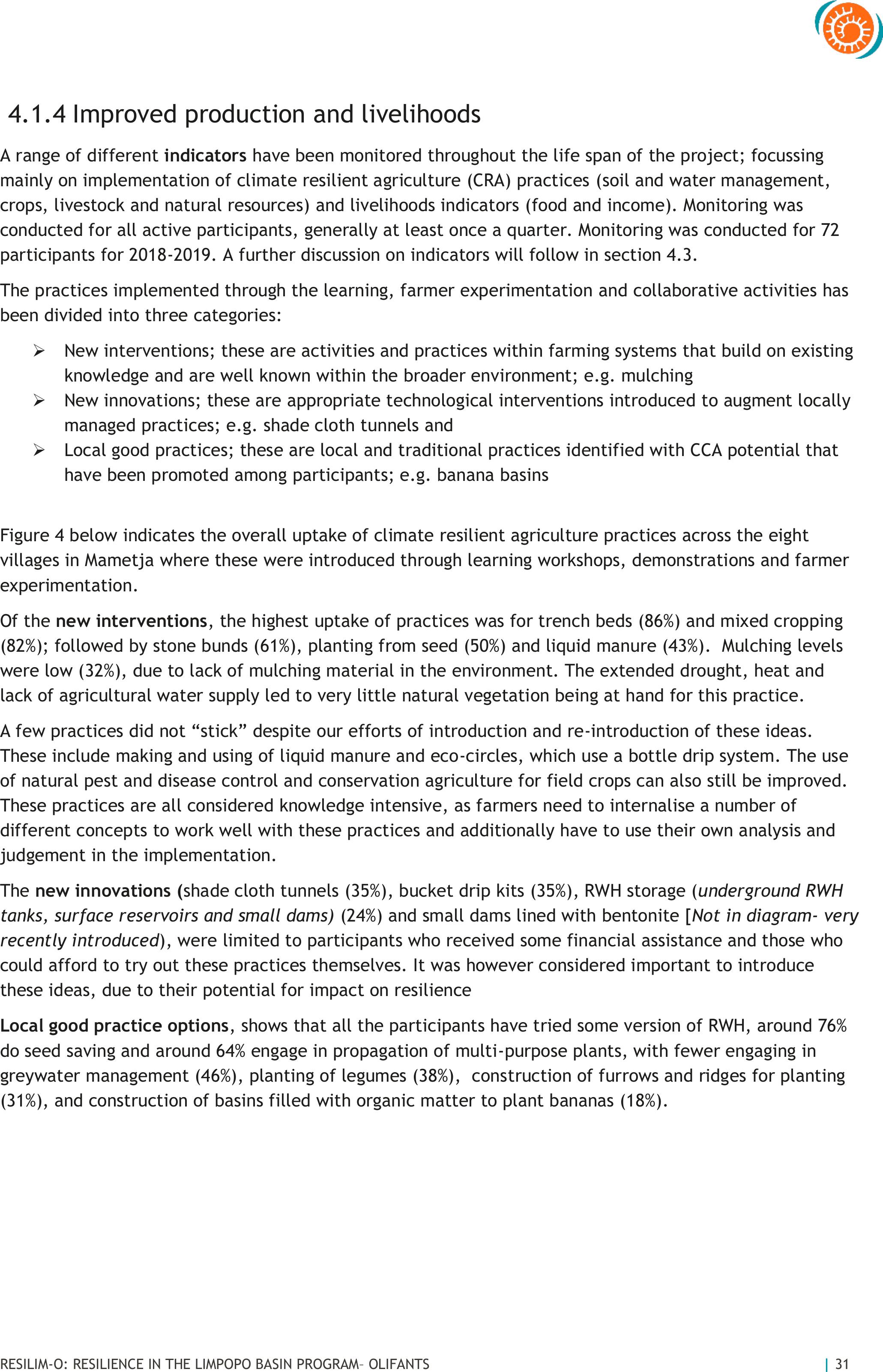
RESILIM-O: RESILIENCE IN THE LIMPOPO BASIN PROGRAM–OLIFANTS
| 31
4.1.4Improved production and livelihoods
A range of different indicators have been monitored throughout the life span of the project; focussing
mainly on implementation of climate resilient agriculture (CRA) practices(soil and water management,
crops, livestock and natural resources)and livelihoods indicators (food and income). Monitoring was
conducted for all active participants, generally at least once a quarter. Monitoring was conducted for 72
participants for 2018-2019. A further discussion on indicators will follow in section 4.3.
The practices implemented through the learning, farmer experimentationand collaborative activities has
been divided into three categories:
➢New interventions; these are activities and practices within farming systems that build on existing
knowledge and are well known within the broader environment; e.g. mulching
➢New innovations; these are appropriate technological interventions introduced to augment locally
managed practices; e.g. shade cloth tunnels and
➢Local good practices; these are local and traditional practices identified with CCA potential that
have been promoted among participants; e.g. banana basins
Figure 4 below indicates the overall uptake of climate resilient agriculture practices across the eight
villages in Mametja where these were introduced through learning workshops, demonstrations and farmer
experimentation.
Of the new interventions, the highest uptake of practices was for trench beds (86%) and mixed cropping
(82%); followed by stone bunds (61%), planting from seed (50%) and liquid manure (43%). Mulching levels
were low (32%), due to lack of mulching material in the environment. The extended drought, heat and
lack of agricultural water supply led to very little natural vegetation being at hand for this practice.
A few practices did not “stick” despite our efforts of introduction and re-introduction of these ideas.
These include making and using of liquid manure and eco-circles, which use a bottle drip system. The use
of natural pest and disease control and conservation agriculture for field crops can also still be improved.
These practices are all considered knowledge intensive, as farmers need to internalise a number of
different concepts to work well with these practices and additionally have to use their own analysis and
judgement in the implementation.
The new innovations (shade cloth tunnels (35%), bucket drip kits (35%), RWH storage (underground RWH
tanks, surface reservoirs and small dams)(24%) and small dams lined with bentonite [Not in diagram- very
recently introduced), were limited to participants who received some financial assistance and those who
could afford to try out these practices themselves. It was however considered important to introduce
these ideas, due to their potential for impact on resilience
Local good practice options, shows that all the participants have tried some version of RWH, around 76%
do seed saving and around 64% engage in propagation of multi-purpose plants, with fewer engaging in
greywater management (46%), planting of legumes (38%), construction of furrows and ridges for planting
(31%), and construction of basins filled with organic matter to plant bananas (18%).
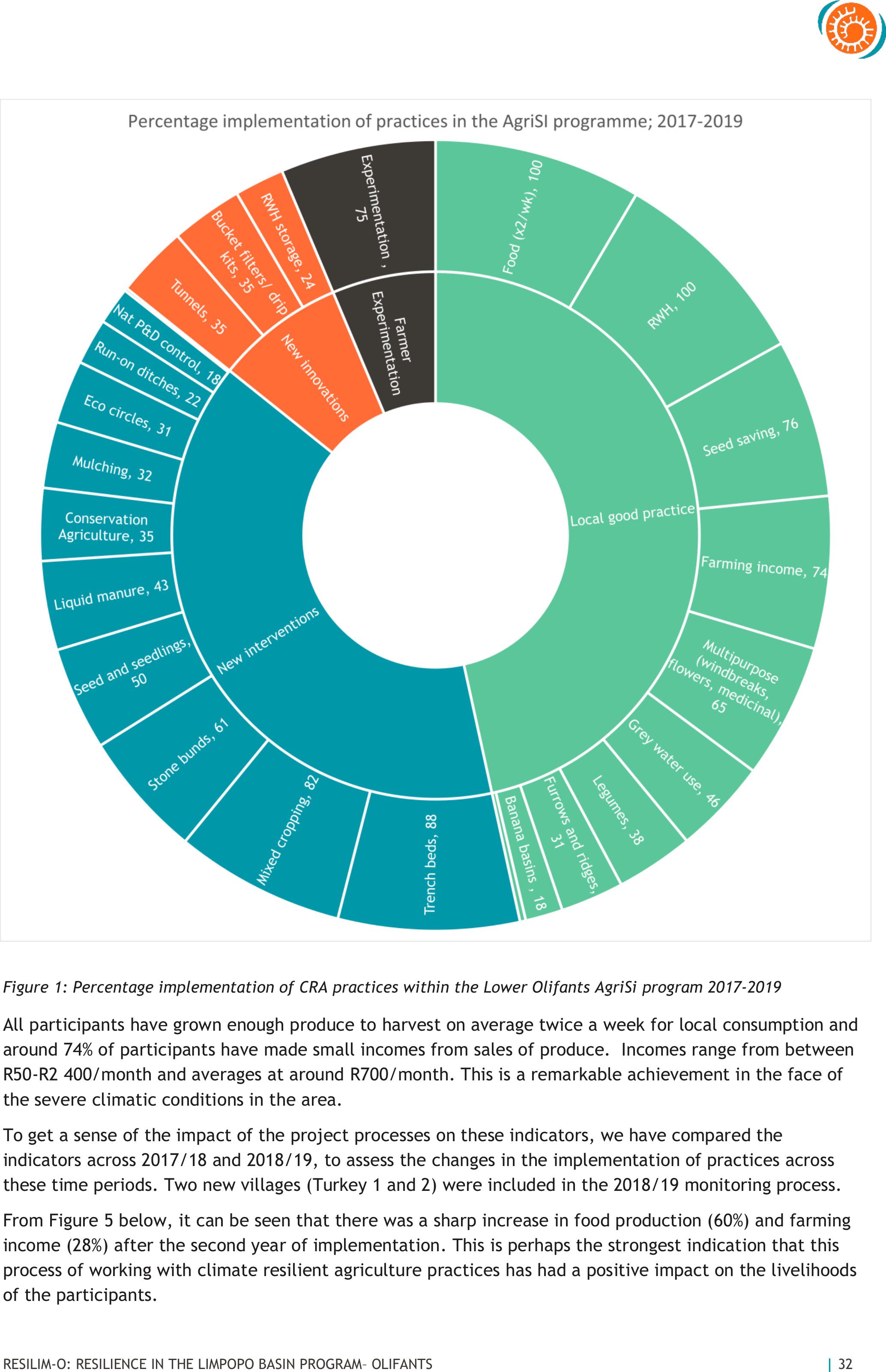
RESILIM-O: RESILIENCE IN THE LIMPOPO BASIN PROGRAM–OLIFANTS
| 32
Figure 1: Percentage implementation of CRA practices within the Lower Olifants AgriSi program 2017-2019
All participants have grown enough produce to harvest on average twice a week for local consumption and
around 74% of participants have made small incomes from sales of produce. Incomes range from between
R50-R2 400/month and averages at around R700/month. This is a remarkable achievement in the face of
the severe climatic conditions in the area.
To get a sense of the impact of the project processes on these indicators, we have compared the
indicators across 2017/18 and 2018/19, to assess the changes in the implementation of practices across
these time periods. Two new villages (Turkey 1 and 2) were included in the 2018/19 monitoring process.
From Figure 5 below, it can be seen that there was a sharp increase in food production (60%) and farming
income (28%) after the second year of implementation. This is perhaps the strongest indication that this
process of working with climate resilient agriculture practices has had a positive impact on the livelihoods
of the participants.

RESILIM-O: RESILIENCE IN THE LIMPOPO BASIN PROGRAM–OLIFANTS
| 33
The increase in local use of RWH practices (basins, drums and Jo-Jo tanks) is an indication of both
increased awareness of this practice, but also increased need, as access to water for household purposes
and farming has been decreasing.
There have also been significant increases in the use of liquid manure (31%), eco-circles (22%), mixed
cropping (21%), conservation agriculture (19%) trench beds (12%), and stone bunds (10%) and some
increase in greywater use, seed saving and banana basins.
Decreases in the implementation of soil and water conservation practices such as run-on ditches,
contours, mulching, and furrows and ridges are indicative of the lack of rain, reducing the urgency in
implementation and participants’ pre-occupation with only focusing on practices directly related to the
production of food.
The level of participation in farmer experimentation,increased by 14%; indicating an ongoing and slowly
growing interest in this method of learning by the participants.
Although only by inference, these comparisons over time also give an indication of the sustainability of
uptake of these practices –as increases indicate a continuation of practices, while a decrease points
towards discontinuation. If participants have used a practice for 2-3 seasons, we would assume that they
would continue to do so in the future
Figure 2: Changes in implementation of practices between 2017/18 and 2018/19
The photographs below provide a visual snapshot of the implementation of some of the practices
mentioned above.
55
51
51
76
9
61
72
72
12
37
16
13
12
20
61
58
66
39
45
37
37
68
5
46
40
22
1
61
88
31
82
50
32
43
18
35
35
35
24
75
31
65
38
100
46
3
76
18
74
100
020 40 60 80100 120
Run-on ditches
Contours, line levels
Stone bunds
Trench beds
Eco circles
Mixed cropping
Seed and seedlings
Mulching
Liquid manure
Nat P&D control
Conservation Agriculture
Bucket filters/ drip kits
Tunnels
RWH storage
Experimentation
Furrows and ridges
Multipurpose (windbreaks, flowers, medicinal)
Legumes
RWH
Grey water use
Nursery
Seed saving
Banana basins
Farming income
Food (x2/wk)
Changes in implementation of practices for 2017/18 and 2018/19
2018/19 2017/18

RESILIM-O: RESILIENCE IN THE LIMPOPO BASIN PROGRAM–OLIFANTS
| 34
Coriander and spinach production in tunnels with drip irrigation, mulching and mixed cropping (including
marigolds and thyme) in tunnels, trench beds with mixture of kale and mustard spinach (new crops grown
from seed kept).
Improved local practices; Small dams with bentonite lining to hold water and composting implemented after
training at Hoedspruit Hub
Conservation agriculture; bird resistant sorghum (introduced) and intercropping of maize with cowpeas
Livestock fodder (black oats), underground RWH tank, mixed cropping and furrows and ridges with mulching
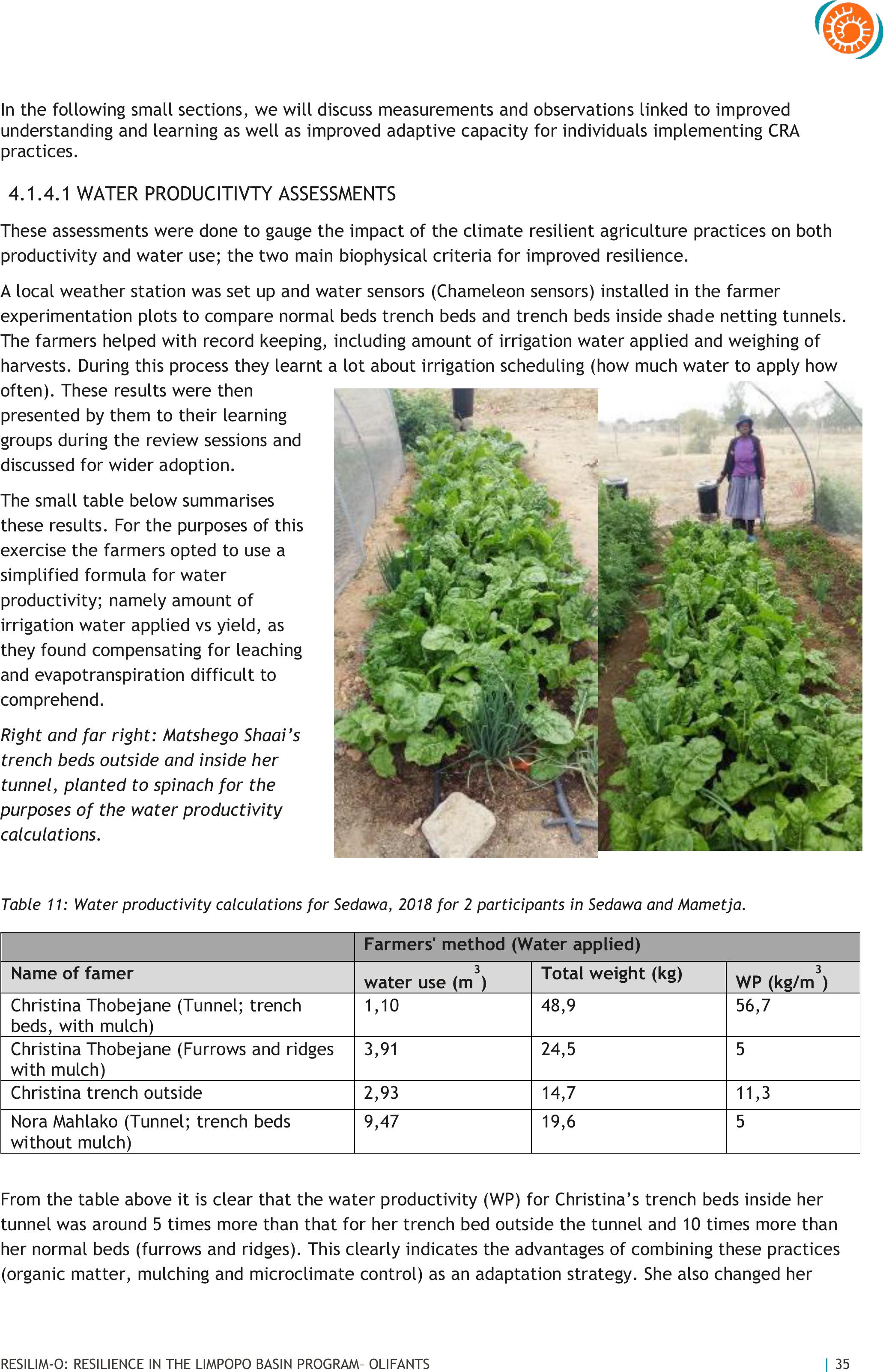
RESILIM-O: RESILIENCE IN THE LIMPOPO BASIN PROGRAM–OLIFANTS
| 35
In the following small sections, we will discuss measurements and observations linked to improved
understanding and learning as well as improved adaptive capacity for individuals implementing CRA
practices.
4.1.4.1WATER PRODUCITIVTY ASSESSMENTS
These assessments were done to gauge the impact of the climate resilient agriculture practices on both
productivity and water use; the twomain biophysical criteria for improved resilience.
A local weather station was set up and water sensors (Chameleon sensors) installed in the farmer
experimentation plots to compare normal beds trench beds and trench beds inside shade netting tunnels.
The farmers helped with record keeping, including amount of irrigation water applied and weighing of
harvests. During this process they learnt a lot about irrigation scheduling (how much water to apply how
often). These results were then
presented by them to their learning
groups during the review sessions and
discussed for wider adoption.
The small table below summarises
these results. For the purposes of this
exercise the farmers opted to use a
simplified formula for water
productivity; namely amount of
irrigation water applied vs yield, as
they found compensating for leaching
and evapotranspiration difficult to
comprehend.
Right and far right: Matshego Shaai’s
trench beds outside and inside her
tunnel, planted to spinach for the
purposes of the water productivity
calculations.
Table 11: Water productivity calculations for Sedawa, 2018 for 2 participants in Sedawa and Mametja.
Farmers' method (Water applied)
Name of famer
water use (m3)
Total weight (kg)
WP (kg/m3)
Christina Thobejane (Tunnel; trench
beds, with mulch)
1,10
48,9
56,7
Christina Thobejane (Furrows and ridges
with mulch)
3,91
24,5
5
Christina trench outside
2,93
14,7
11,3
Nora Mahlako (Tunnel; trench beds
without mulch)
9,47
19,6
5
From the table above it is clear that the water productivity (WP) for Christina’s trench beds inside her
tunnel was around 5 times more than that for her trench bed outside the tunnel and 10 times more than
her normal beds (furrows and ridges). This clearly indicates the advantages of combining these practices
(organic matter, mulching and microclimate control) as an adaptation strategy. She also changed her
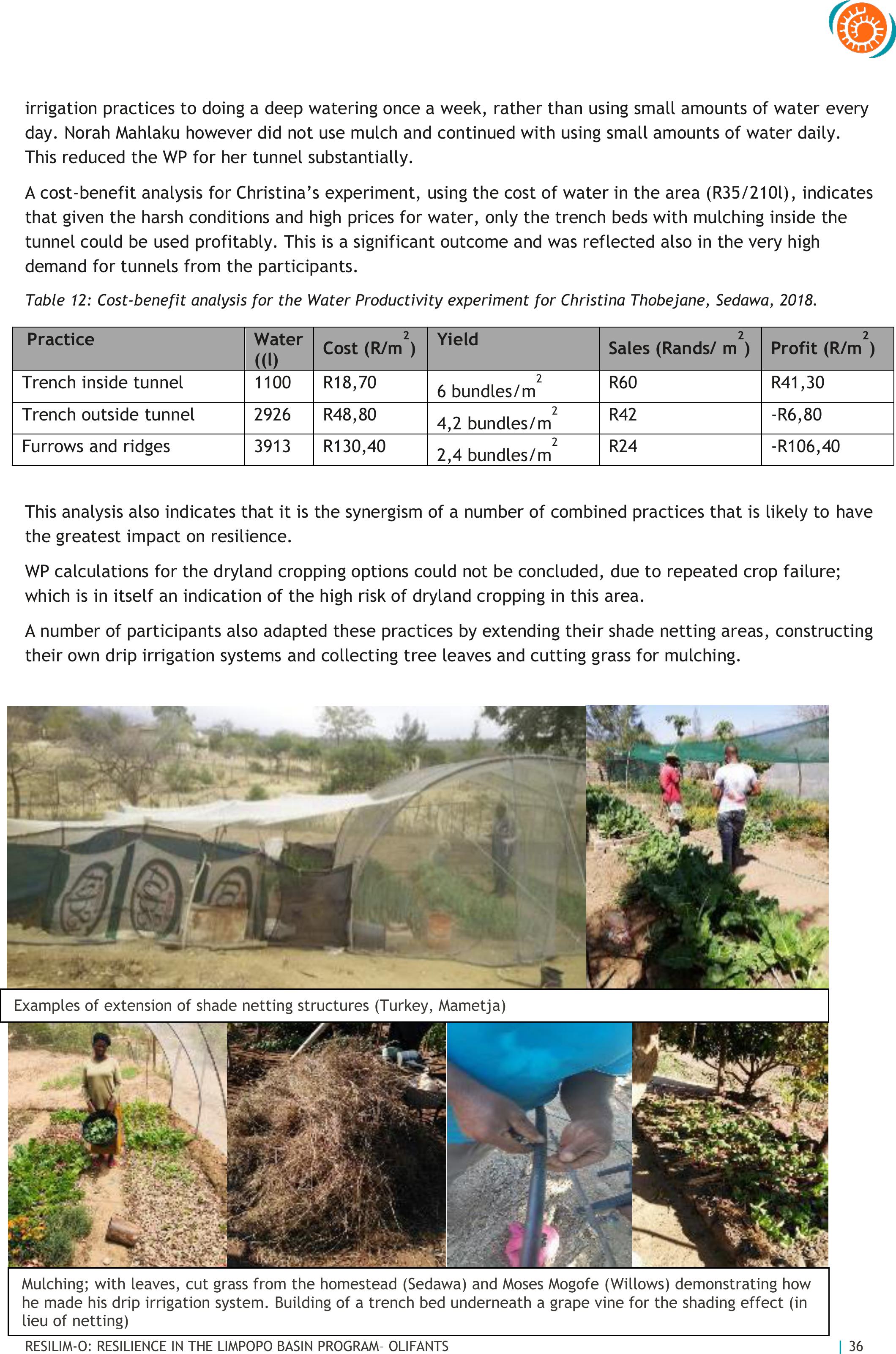
RESILIM-O: RESILIENCE IN THE LIMPOPO BASIN PROGRAM–OLIFANTS
| 36
irrigation practices to doing a deep watering once a week, rather than using small amounts of water every
day. Norah Mahlaku however did not use mulch and continued with using small amounts of water daily.
This reduced the WP for her tunnel substantially.
A cost-benefit analysis for Christina’s experiment, using the cost of water in the area (R35/210l), indicates
that given the harsh conditions and high prices for water, only the trench beds with mulching inside the
tunnel could be used profitably. This is a significant outcome and was reflected also in the very high
demand for tunnels from the participants.
Table 12: Cost-benefit analysis for the Water Productivity experiment for Christina Thobejane, Sedawa, 2018.
Practice
Water
((l)
Cost (R/m2)
Yield
Sales (Rands/ m2)
Profit (R/m2)
Trench inside tunnel
1100
R18,70
6 bundles/m2
R60
R41,30
Trench outside tunnel
2926
R48,80
4,2 bundles/m2
R42
-R6,80
Furrows and ridges
3913
R130,40
2,4 bundles/m2
R24
-R106,40
This analysis also indicates that it is the synergism of a number of combined practices that is likely to have
the greatest impact on resilience.
WP calculations for the dryland cropping options could not be concluded, due to repeated crop failure;
which is in itself an indication of the high risk of dryland cropping in this area.
A number of participants alsoadapted these practices by extending their shade netting areas, constructing
their own drip irrigation systemsand collecting tree leaves and cutting grass for mulching.
Examples of extension of shade netting structures (Turkey, Mametja)
Mulching; with leaves, cut grass from the homestead (Sedawa) and Moses Mogofe (Willows) demonstrating how
he made his drip irrigation system. Building of a trench bed underneath a grape vine for the shading effect (in
lieu of netting)
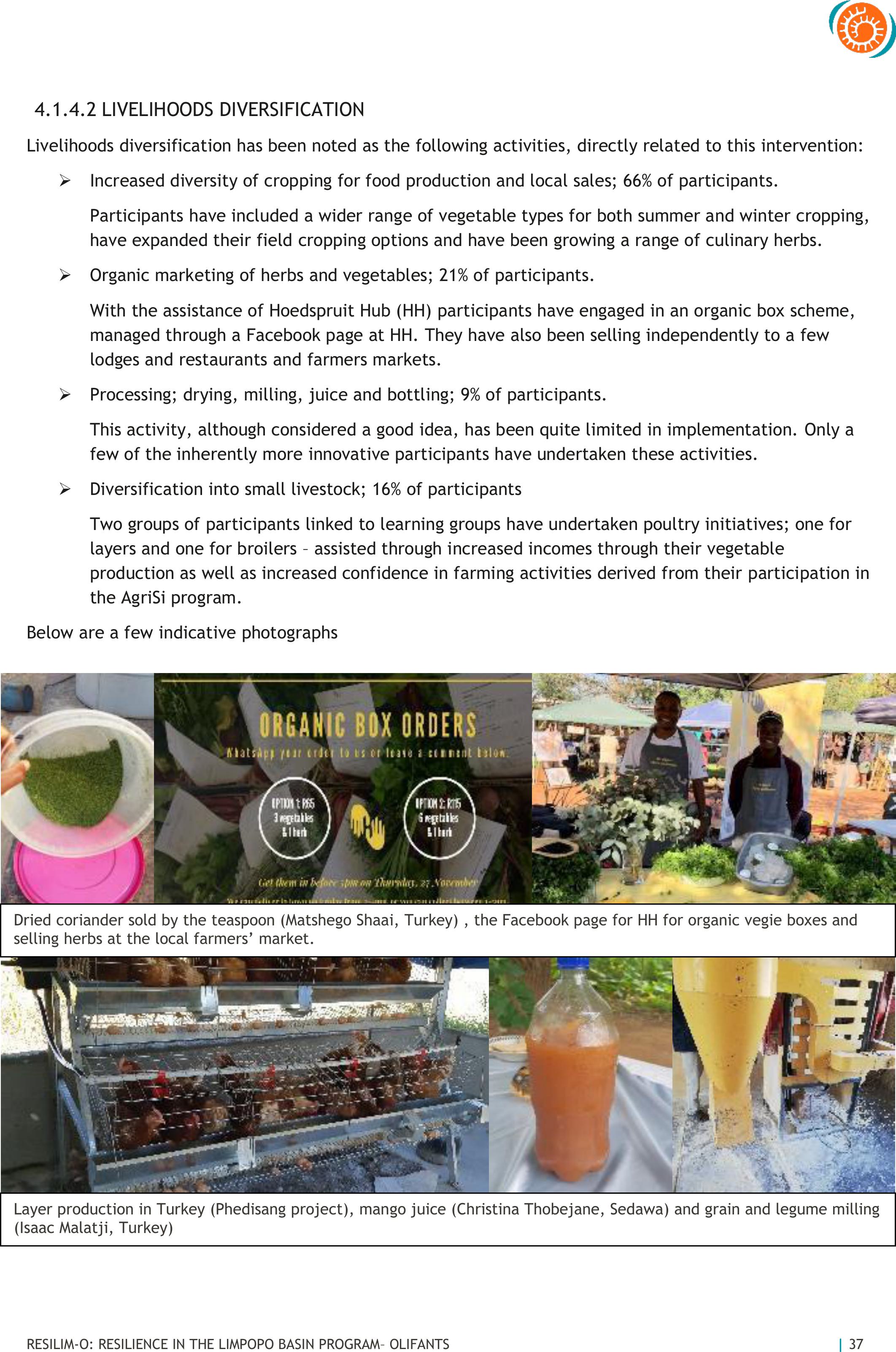
RESILIM-O: RESILIENCE IN THE LIMPOPO BASIN PROGRAM–OLIFANTS
| 37
4.1.4.2LIVELIHOODS DIVERSIFICATION
Livelihoods diversification has been noted as the following activities, directly related to this intervention:
➢Increased diversity of cropping for food production and local sales; 66% of participants.
Participants have included a wider range of vegetable types for both summer and winter cropping,
have expanded their field cropping options and have been growing a range of culinary herbs.
➢Organic marketing of herbs and vegetables; 21% of participants.
With the assistance of Hoedspruit Hub (HH)participants have engaged in an organic box scheme,
managed through a Facebook page at HH. They have also been selling independently to a few
lodges and restaurants and farmers markets.
➢Processing; drying, milling, juice and bottling; 9% of participants.
This activity, although considered a good idea, has been quite limited in implementation. Only a
few of the inherently more innovative participants have undertaken these activities.
➢Diversification into small livestock; 16% of participants
Two groups of participants linked to learning groups have undertaken poultry initiatives; one for
layers and one for broilers –assisted through increased incomes through their vegetable
production as well as increased confidence in farming activities derived from theirparticipation in
the AgriSi program.
Below are a few indicative photographs
Dried coriander sold by the teaspoon (Matshego Shaai, Turkey) , the Facebook page for HH for organic vegie boxes and
selling herbs at the local farmers’ market.
Layer production in Turkey (Phedisang project), mango juice (Christina Thobejane, Sedawa) and grain and legume milling
(Isaac Malatji, Turkey)
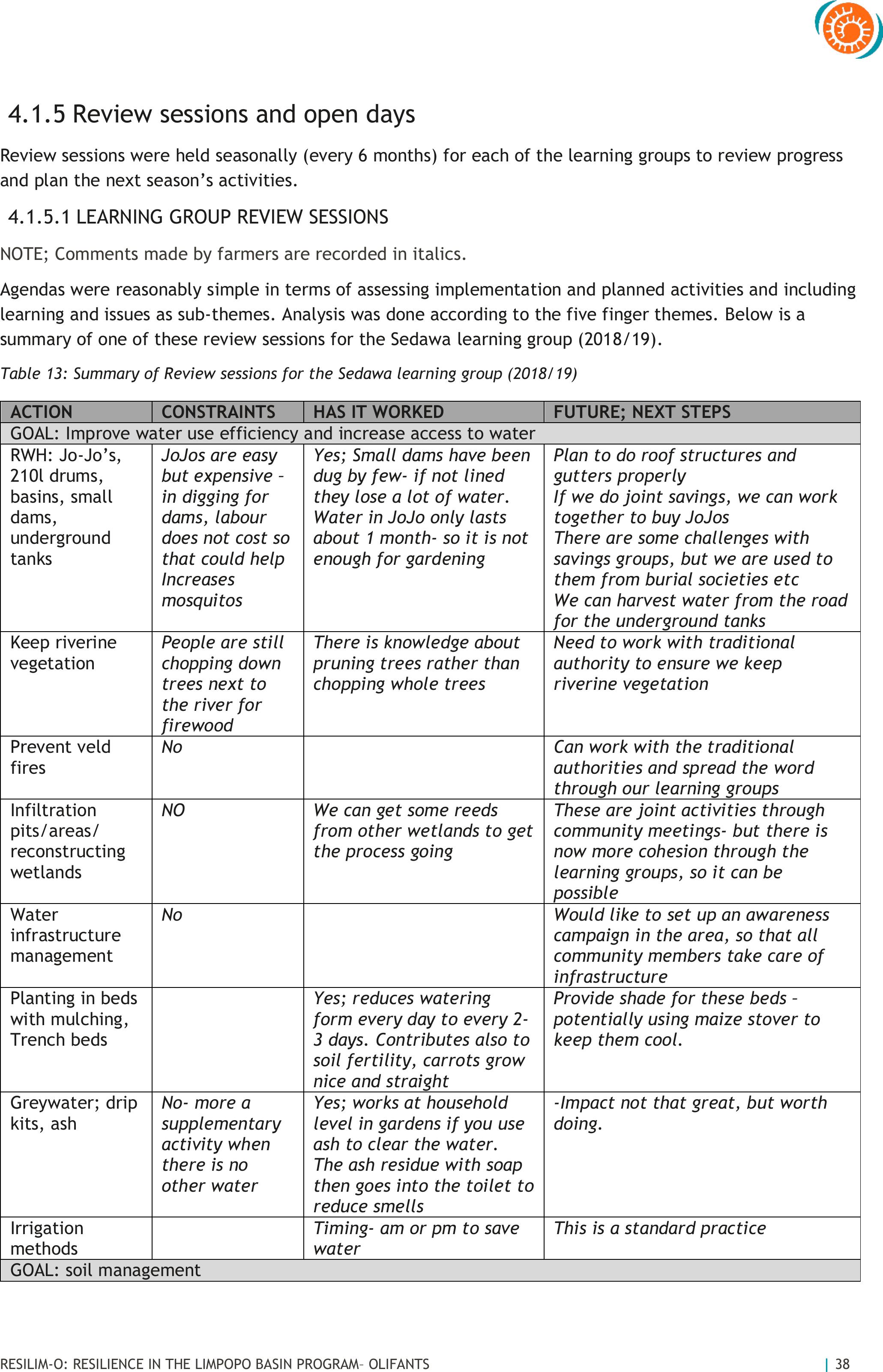
RESILIM-O: RESILIENCE IN THE LIMPOPO BASIN PROGRAM–OLIFANTS
| 38
4.1.5Review sessions and open days
Review sessions were held seasonally (every 6 months) for each of the learning groups to review progress
and plan the next season’s activities.
4.1.5.1LEARNING GROUP REVIEW SESSIONS
NOTE; Comments made by farmers are recorded in italics.
Agendas were reasonably simple in terms of assessing implementation and planned activities and including
learning and issues as sub-themes. Analysis was done according to the five finger themes. Below is a
summary of one of these review sessions for the Sedawa learning group (2018/19).
Table 13: Summary of Review sessions for the Sedawa learning group (2018/19)
ACTION
CONSTRAINTS
HAS IT WORKED
FUTURE; NEXT STEPS
GOAL: Improve water use efficiency and increase access to water
RWH: Jo-Jo’s,
210l drums,
basins, small
dams,
underground
tanks
JoJos are easy
but expensive –
in digging for
dams, labour
does not cost so
that could help
Increases
mosquitos
Yes; Small dams have been
dug by few- if not lined
they lose a lot of water.
Water in JoJo only lasts
about 1 month- so it is not
enough for gardening
Plan to do roof structures and
gutters properly
If we do joint savings, we can work
together to buy JoJos
There are some challenges with
savings groups, but we are used to
them from burial societies etc
We can harvest water from the road
for the underground tanks
Keep riverine
vegetation
People are still
chopping down
trees next to
the river for
firewood
There is knowledge about
pruning trees rather than
chopping whole trees
Need to work with traditional
authority to ensure we keep
riverine vegetation
Prevent veld
fires
No
Can work with the traditional
authorities and spread the word
through our learning groups
Infiltration
pits/areas/
reconstructing
wetlands
NO
We can get some reeds
from other wetlands to get
the process going
These are joint activities through
community meetings- but there is
now more cohesion through the
learning groups, so it can be
possible
Water
infrastructure
management
No
Would like to set up an awareness
campaign in the area, so that all
community members take care of
infrastructure
Planting in beds
with mulching,
Trench beds
Yes; reduces watering
form every day to every 2-
3 days. Contributes also to
soil fertility, carrots grow
nice and straight
Provide shade for these beds –
potentially using maize stover to
keep them cool.
Greywater; drip
kits, ash
No- more a
supplementary
activity when
there is no
other water
Yes; works at household
level in gardens if you use
ash to clear the water.
The ash residue with soap
then goes into the toilet to
reduce smells
-Impact not that great, but worth
doing.
Irrigation
methods
Timing- am or pm to save
water
This is a standard practice
GOAL: soil management
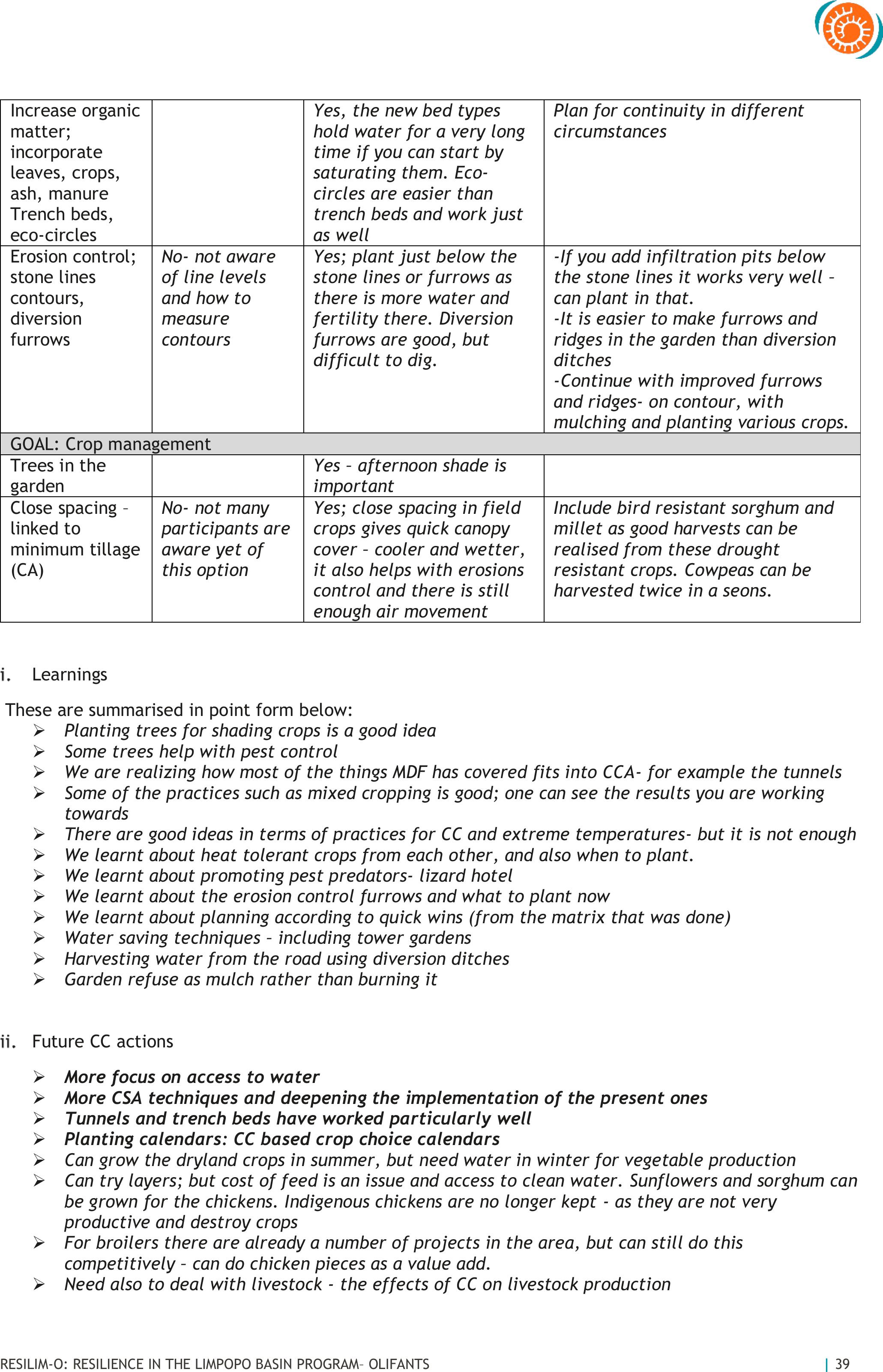
RESILIM-O: RESILIENCE IN THE LIMPOPO BASIN PROGRAM–OLIFANTS
| 39
Increase organic
matter;
incorporate
leaves, crops,
ash, manure
Trench beds,
eco-circles
Yes, the new bed types
hold water for a very long
time if you can start by
saturating them. Eco-
circles are easier than
trench beds and work just
as well
Plan for continuity in different
circumstances
Erosion control;
stone lines
contours,
diversion
furrows
No- not aware
of line levels
and how to
measure
contours
Yes; plant just below the
stone lines or furrows as
there is more water and
fertility there. Diversion
furrows are good, but
difficult to dig.
-If you add infiltration pits below
the stone lines it works very well–
can plant in that.
-It is easier to make furrows and
ridges in the garden than diversion
ditches
-Continue with improved furrows
and ridges-on contour, with
mulching and planting various crops.
GOAL: Crop management
Trees in the
garden
Yes –afternoon shade is
important
Close spacing –
linked to
minimum tillage
(CA)
No- not many
participants are
aware yet of
this option
Yes; close spacing in field
crops gives quick canopy
cover –cooler and wetter,
it also helps with erosions
control and there is still
enough air movement
Include bird resistant sorghum and
millet as good harvests can be
realised from these drought
resistant crops. Cowpeas can be
harvested twice in a seons.
Learnings
These are summarised in point form below:
➢Planting trees for shading cropsis a good idea
➢Some trees help with pest control
➢We are realizing how most of the things MDF has covered fits into CCA-for example the tunnels
➢Some of the practices such as mixed croppingis good; one can see the results you are working
towards
➢There are good ideas in terms of practices for CC and extreme temperatures-but it is not enough
➢We learnt about heat tolerant crops from each other, and also when to plant.
➢We learnt about promoting pest predators- lizard hotel
➢We learnt about the erosion control furrows and what to plant now
➢We learnt about planning according to quick wins (from the matrix that was done)
➢Water saving techniques –including tower gardens
➢Harvesting water from the road using diversion ditches
➢Garden refuse as mulch rather than burning it
Future CC actions
➢More focus on access to water
➢More CSA techniques and deepening the implementation of the present ones
➢Tunnels and trench beds have worked particularly well
➢Planting calendars: CC based crop choice calendars
➢Can grow the dryland crops in summer, but need water in winter for vegetable production
➢Can try layers; but cost of feed is an issue and access to clean water. Sunflowers and sorghum can
be grown for the chickens. Indigenous chickens are no longer kept - as they are not very
productive and destroy crops
➢For broilers there are already a number of projects in the area, but can still do this
competitively –can do chicken pieces as a value add.
➢Need also to deal with livestock - the effects of CC on livestock production

RESILIM-O: RESILIENCE IN THE LIMPOPO BASIN PROGRAM–OLIFANTS
| 40
➢We shouldn’t end here. We tried these ideas under the worst situations (drought) –they may do a
lot better now in a better year
➢One of the highlights has been the cost-benefit analysis in our learning sessions; where more
inputs could mean a much better yield- rather than low inputs and low yields.
➢Savings can be introduced
➢Make a committee to continue to explore options for spring protection and efficient management
of water from them.
➢Need now to implement the improved erosion control measures that have been introduced.
➢Once water is sorted there needs to be more focus on commercial production
➢Bulk buying for JoJo tanks- MDF to find potential discount options
➢Bring DRD representatives on board with the NGOs already working in these areas (Sedawa) to see
if more things can be brought.
➢Also work with the municipality –improve the relationship with the councillors and then set up a
joint strategy with community and NGOs working together
➢NGOs must make sure they keep their promises as community members cannot trust them
otherwise
➢NGOs need to take more care to help support local produce when catering and also local caterers.
4.1.5.2CLUSTER REVIEWS AND OPEN DAYS
Review sessions for the whole cluster (all villages) were held annually. These sessions also provided
opportunities for participants to show case their practices and teach others, to assess the impact of these
practices on their farming and livelihoods and undertake joint or collaborative activities, such as initiating
the water committees. These sessions were held as open days, including as many stakeholders as possible.
Participants from CSA, K2C, SOL, Lima RDF, Middle Olifants’AgriSI program and Limpopo Department of
Agriculture attended these events. Other stakeholders, such as those from Water Services, the
Municipalities and Environmental Affairs could not be persuaded to attend, despite repeated efforts.
Below is an example from a cluster review workshop held in October 2018, of the “traffic lights”
assessment of implementation of practices and progress in implementation.Although the traffic light
assessments were used with the groups throughout the implementation process; it became clear that the
implementation of practices did not show a linear relationship over time, as can be seen from Figure 5 in
the section above. Participants implemented practices seasonally and those that suited them best at any
point in time. Their main criteria were availability and access to water. So, for example, soil erosion
control practices have not been prioritised due to the general lack of rain during the implementation
period and intensive gardening practices were prioritized, as these were still possible within the
constraint of limited water access.
Table 14: Traffic lights assessment of implementation of CRA practices, October 2018.
Practice
Implementation
No of
people
(N=62)
Comments
WATER MANAGEMENT
Mulching
23
Saves water, suppresses weeds
Furrows and ridges
9
Make sure you allow the grass to grow before you turn the
soil. Helps control soil pests
Banana basins
13
Prevents water run-off, provides fertility and water for the
trees as you add leaves and compost before planting the trees
Roof water
harvesting
50
Tanks for storage not enough, so this does not last long and
does not work in the dry season. We use this water for
drinking
Underground tanks
2
Very expensive and have now been dry for a long time as
there has been no rain. Holds 24 000l, but even that was not
enough to use for gardening
Stone bunds
15
Reduces erosion and holds water
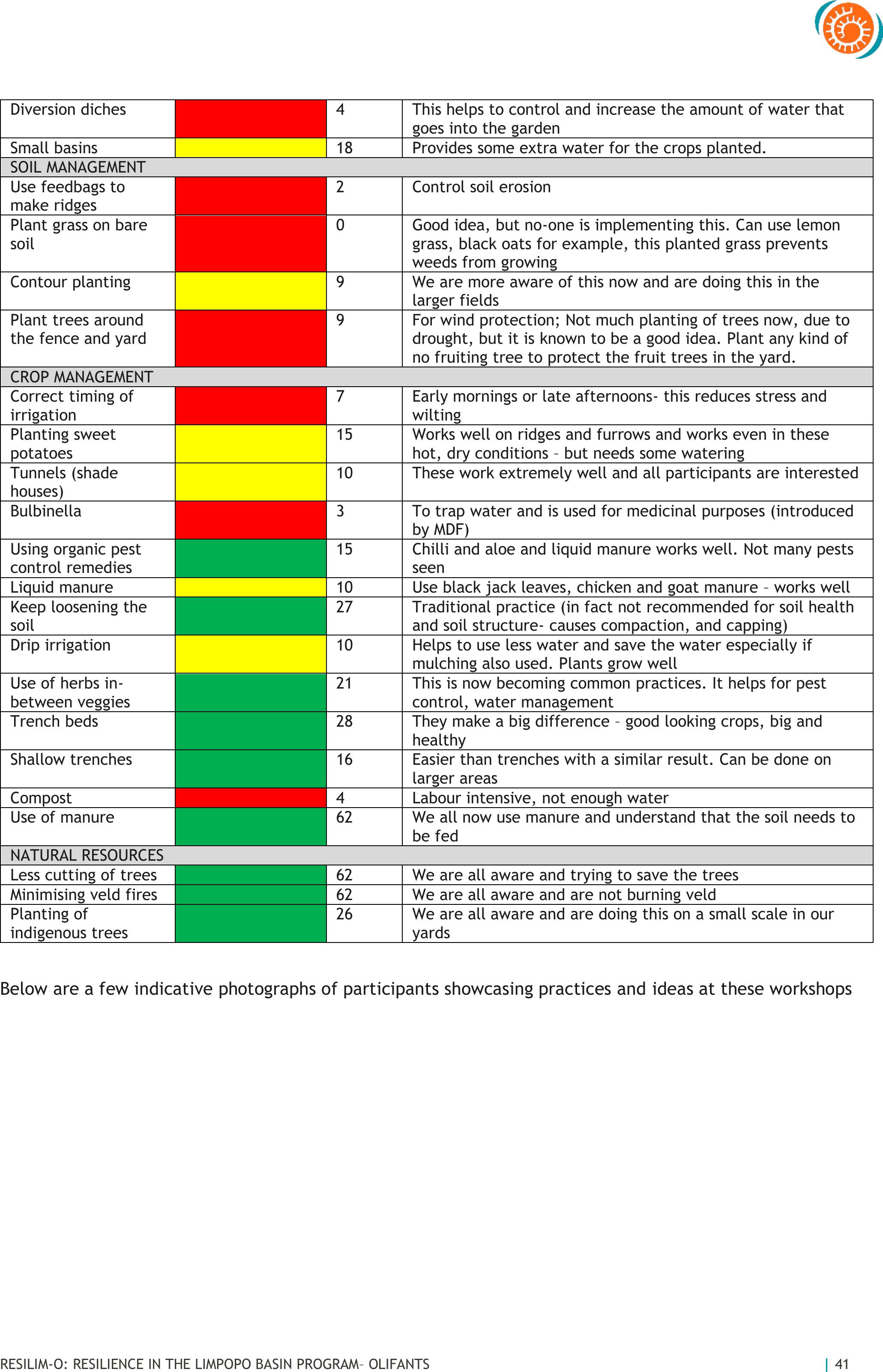
RESILIM-O: RESILIENCE IN THE LIMPOPO BASIN PROGRAM–OLIFANTS
| 41
Diversion diches
4
This helps to control and increase the amount of water that
goes into the garden
Small basins
18
Provides some extra water for the crops planted.
SOIL MANAGEMENT
Use feedbags to
make ridges
2
Control soil erosion
Plant grass on bare
soil
0
Good idea, but no-one is implementing this. Can use lemon
grass, black oats for example, this planted grass prevents
weeds from growing
Contour planting
9
We are more aware of this now and are doing this in the
larger fields
Plant trees around
the fence and yard
9
For wind protection; Not much planting of trees now, due to
drought, but it is known to be a good idea. Plant any kind of
no fruiting tree to protect the fruit trees in the yard.
CROP MANAGEMENT
Correct timing of
irrigation
7
Early mornings or late afternoons- this reduces stress and
wilting
Planting sweet
potatoes
15
Works well on ridges and furrows and works even in these
hot, dry conditions –but needs some watering
Tunnels (shade
houses)
10
These work extremely well and all participants are interested
Bulbinella
3
To trap water and is used for medicinal purposes (introduced
by MDF)
Using organic pest
control remedies
15
Chilli and aloe and liquid manure works well. Not many pests
seen
Liquid manure
10
Use black jack leaves, chicken and goat manure –works well
Keep loosening the
soil
27
Traditional practice (in fact not recommended for soil health
and soil structure- causes compaction, and capping)
Drip irrigation
10
Helps to use less water and save the water especially if
mulching also used. Plants grow well
Use of herbs in-
between veggies
21
This is now becoming common practices. It helps for pest
control, water management
Trench beds
28
They make a big difference –good looking crops, big and
healthy
Shallow trenches
16
Easier than trenches with a similar result. Can be done on
larger areas
Compost
4
Labour intensive, not enough water
Use of manure
62
We all now use manure and understand that the soil needs to
be fed
NATURAL RESOURCES
Less cutting of trees
62
We are all aware and trying to save the trees
Minimising veld fires
62
We are all aware and are not burning veld
Planting of
indigenous trees
26
We are all aware and are doing this on a small scale in our
yards
Below are a few indicative photographs of participants showcasing practices and ideas at these workshops
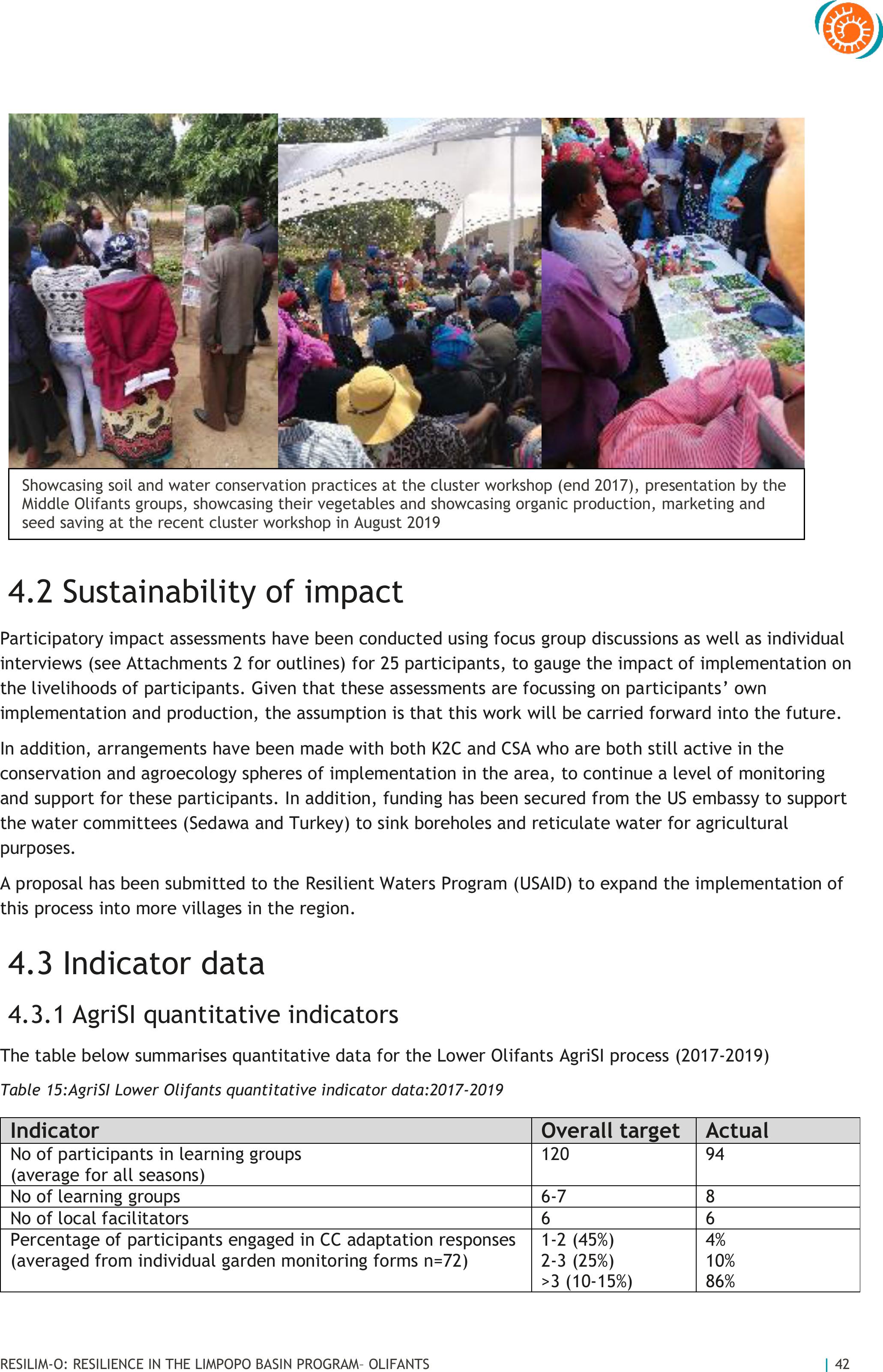
RESILIM-O: RESILIENCE IN THE LIMPOPO BASIN PROGRAM–OLIFANTS
| 42
4.2Sustainability of impact
Participatory impact assessments have been conducted using focus group discussions as well as individual
interviews (see Attachments 2 for outlines)for 25 participants, to gauge the impact of implementation on
the livelihoods of participants. Given that these assessments are focussing on participants’own
implementation and production, the assumption is that this workwill be carried forward into the future.
In addition, arrangements have been made with both K2C and CSA who are both still active in the
conservation and agroecology spheres of implementation in the area, to continue a level of monitoring
and support for these participants. In addition, funding has been secured from the US embassy to support
the water committees (Sedawa and Turkey) to sink boreholes and reticulate water for agricultural
purposes.
A proposal has been submitted to the Resilient Waters Program (USAID) to expand the implementation of
this process into more villages in the region.
4.3Indicator data
4.3.1 AgriSI quantitative indicators
The table below summarises quantitative data for the Lower Olifants AgriSI process (2017-2019)
Table 15:AgriSI Lower Olifants quantitative indicator data:2017-2019
Indicator
Overall target
Actual
No of participants in learning groups
(average for all seasons)
120
94
No of learning groups
6-7
8
No of local facilitators
6
6
Percentage of participants engaged in CC adaptation responses
(averaged from individual garden monitoring forms n=72)
1-2 (45%)
2-3 (25%)
>3 (10-15%)
4%
10%
86%
Showcasing soil and water conservation practices at the cluster workshop (end 2017), presentation by the
Middle Olifants groups, showcasing their vegetables and showcasing organic production, marketing and
seed saving at the recent cluster workshop in August 2019

RESILIM-O: RESILIENCE IN THE LIMPOPO BASIN PROGRAM–OLIFANTS
| 43
No of participants experimenting with new innovations
-local
-co-designed
(average of all practices categories)
15%
45%
55%
30%
No of participants showing increased knowledge
(farmer experimentation used as a proxy)
35%
44%
Percentage of participants engaged in collaborative activities
(tunnels, RWH, water committees)
35%
41%
Percentage of participants with improved livelihoods
-increased availability of food
-increased income
-increased diversity of activities and livelihoods options
40%
5%
5%
77%
56%
30%
4.3.2Participatory Impact Assessments (PIA)
The PIA process for Turkey (September 2019) is summarised below as an example
Introduction
Community impact indicators look at the end result of project activities on people’s lives and measure the
fundamentals assets, resources and feelings of people affected by the project. These indicators may be
quantitative, such as income earned from crops sales, or qualitative such as improved skills, knowledge or
social status.
Climate change Impacts
Below is a summary of the community’s understanding of climate change impacts on theirenvironment
Table 16: CC impacts for Turkey; re-cap for PIA, September 2019
Natural
(environment and
farming)
Physical
(environment and
farming)
Economic
Human (skills and
knowledge)
Social
(organisations)
Trees are dying;
including indigenous
trees and fruit trees
Soil erosion and
more dongas
Less income from
farming
Loss of old people’s
farming knowledge
to share with youth
Decrease in playing
stokvels
No grass and water
for livestock to
graze
Soil structure has
changed; soils are
very dry and hot
with increased
compaction
We buy water for
both consumption
and irrigation
Farming activities
have decreased
Working with only
one NGO to assist
with farming
activities
More diseases and
pests associated
with extreme heat
Livestock disease is
increasing
We buy seedlings
and seeds yet they
die with no single
harvest
Shortage of food
Fighting for water
sources in the
mountains
Less rain, increased
heat
Crops not surviving
the heat
Shortage of water
Growing seasons
have changed
Buying livestock
food to keep them
alive
Ground water level
dropping
Rivers are all dry
Springs and wells
are drying up
From the discussion the following points of interest were raised:
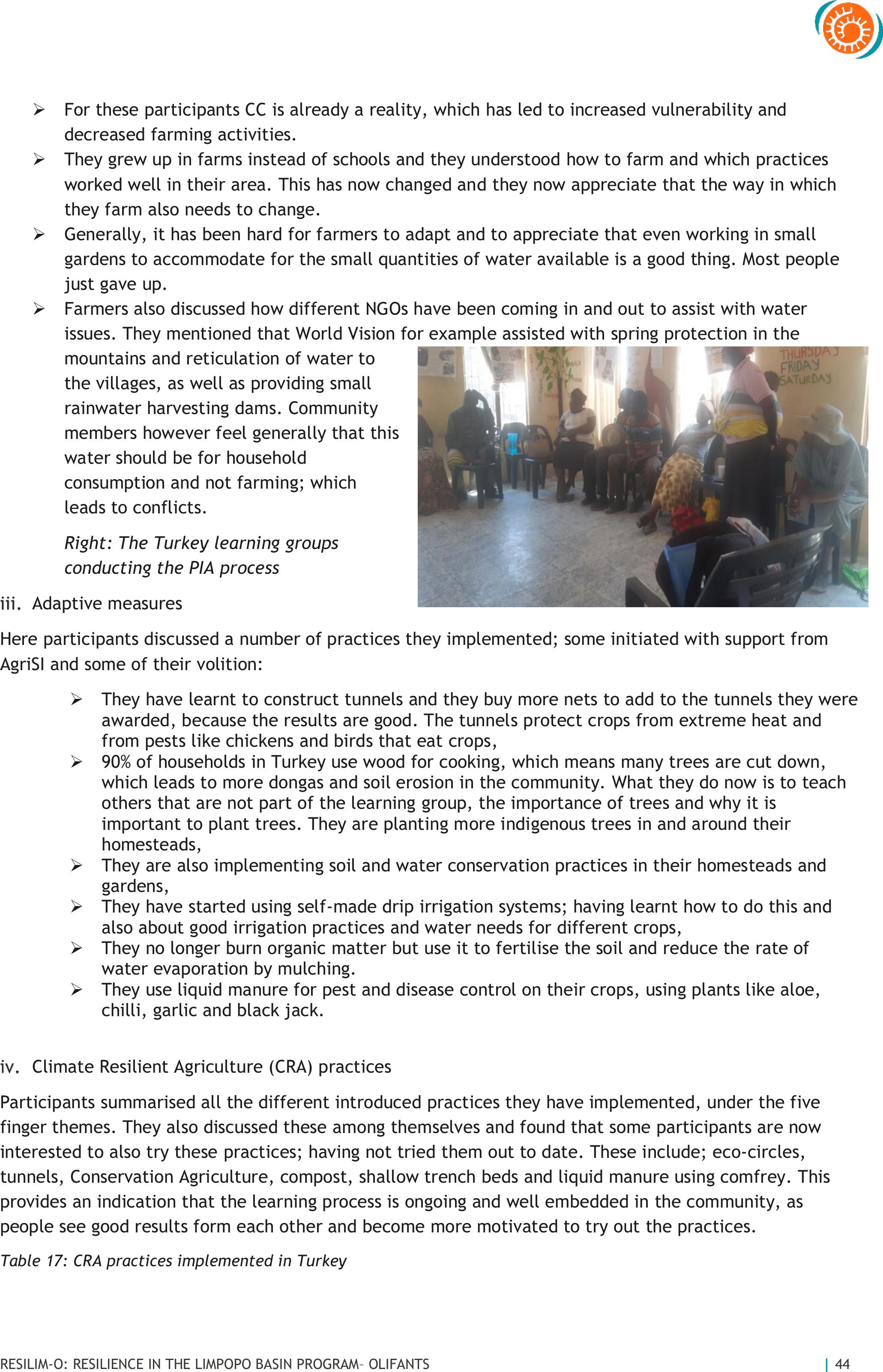
RESILIM-O: RESILIENCE IN THE LIMPOPO BASIN PROGRAM–OLIFANTS
| 44
➢For these participants CC is already a reality, which has led to increased vulnerability and
decreased farming activities.
➢They grew up in farms instead of schools and they understood how to farm and which practices
worked well in their area. This has now changed and they now appreciate that the way in which
they farm also needs to change.
➢Generally, it has been hard for farmers to adapt and to appreciate that even working in small
gardens to accommodate for the small quantities of water available is a good thing. Most people
just gave up.
➢Farmers also discussed how different NGOs have been coming in and out to assist with water
issues. They mentioned that World Vision for example assisted with spring protection in the
mountains and reticulation of water to
the villages, as well as providing small
rainwater harvesting dams. Community
members however feel generally that this
water should be for household
consumption and not farming; which
leads to conflicts.
Right: The Turkey learning groups
conducting the PIA process
Adaptive measures
Here participants discussed a number of practices they implemented; some initiated with support from
AgriSI and some of their volition:
➢They have learnt to constructtunnels and they buy more nets to add to the tunnels they were
awarded, because the results are good. The tunnels protect crops from extreme heat and
from pests like chickens and birds that eat crops,
➢90% of households in Turkey use wood for cooking, which means many trees are cut down,
which leads to more dongas and soil erosion in the community. What they do now is to teach
others that are not part of the learninggroup, the importance of trees and why it is
important to plant trees. They are planting more indigenous trees in and around their
homesteads,
➢They are also implementing soil and water conservation practices in their homesteads and
gardens,
➢They have started using self-made drip irrigation systems; having learnt how to do this and
also about good irrigation practices and water needs for different crops,
➢They no longer burn organic matterbut use it to fertilise the soil and reduce the rate of
water evaporation by mulching.
➢They use liquid manure for pest and disease control on their crops, using plants like aloe,
chilli, garlic and black jack.
Climate Resilient Agriculture (CRA) practices
Participants summarised all the different introduced practices they have implemented, under the five
finger themes. They also discussed these among themselves and found that some participants are now
interested to also try these practices; having not tried them out to date. These include; eco-circles,
tunnels, Conservation Agriculture, compost, shallow trench beds and liquid manure using comfrey. This
provides an indication that the learning process is ongoing and well embedded in the community, as
people see good results form each other and become more motivated to try out the practices.
Table 17: CRA practices implemented in Turkey
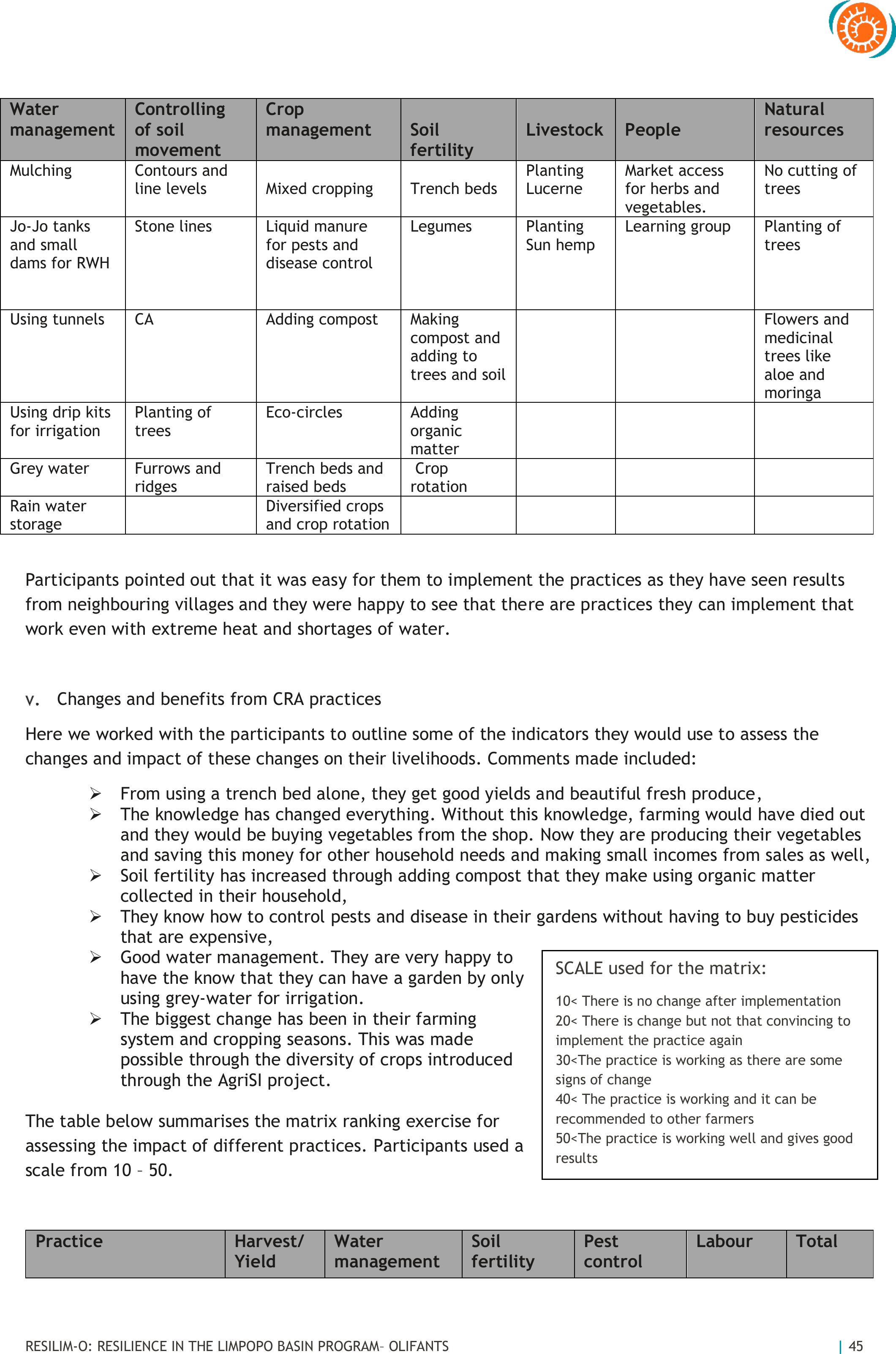
RESILIM-O: RESILIENCE IN THE LIMPOPO BASIN PROGRAM–OLIFANTS
| 45
Water
management
Controlling
of soil
movement
Crop
management
Soil
fertility
Livestock
People
Natural
resources
Mulching
Contours and
line levels
Mixed cropping
Trench beds
Planting
Lucerne
Market access
for herbs and
vegetables.
No cutting of
trees
Jo-Jo tanks
and small
dams for RWH
Stone lines
Liquid manure
for pests and
disease control
Legumes
Planting
Sun hemp
Learning group
Planting of
trees
Using tunnels
CA
Adding compost
Making
compost and
adding to
trees and soil
Flowers and
medicinal
trees like
aloe and
moringa
Using drip kits
for irrigation
Planting of
trees
Eco-circles
Adding
organic
matter
Grey water
Furrows and
ridges
Trench beds and
raised beds
Crop
rotation
Rain water
storage
Diversified crops
and crop rotation
Participants pointed out that it was easy for them to implement the practices as they have seen results
from neighbouring villages and they were happy to see that there are practices they can implement that
work even withextreme heat and shortagesof water.
Changes and benefits from CRA practices
Here we worked with the participants to outline some of the indicators they would use to assess the
changes and impact of these changes on their livelihoods. Comments made included:
➢From using a trench bed alone, they get good yields and beautiful fresh produce,
➢The knowledge has changed everything.Without this knowledge, farming would have died out
and they would be buying vegetables from the shop.Now they are producing their vegetables
and saving this money for other household needsand making small incomes from sales as well,
➢Soil fertilityhas increased through adding compost that they make using organic matter
collected in their household,
➢They know how to control pests and disease in their gardens without having to buy pesticides
that are expensive,
➢Good water management. They are very happy to
have the know that they can have a garden by only
using grey-water for irrigation.
➢The biggest change has been intheir farming
system and cropping seasons. This was made
possible through the diversity of crops introduced
through the AgriSI project.
The table below summarises the matrix ranking exercise for
assessing the impact of different practices.Participants used a
scale from 10 –50.
Practice
Harvest/
Yield
Water
management
Soil
fertility
Pest
control
Labour
Total
SCALE used for the matrix:
10< There is no change after implementation
20< There is change but not that convincing to
implement the practice again
30<The practice is working as there are some
signs of change
40< The practice is working and it can be
recommended to other farmers
50<The practice is working well and gives good
results
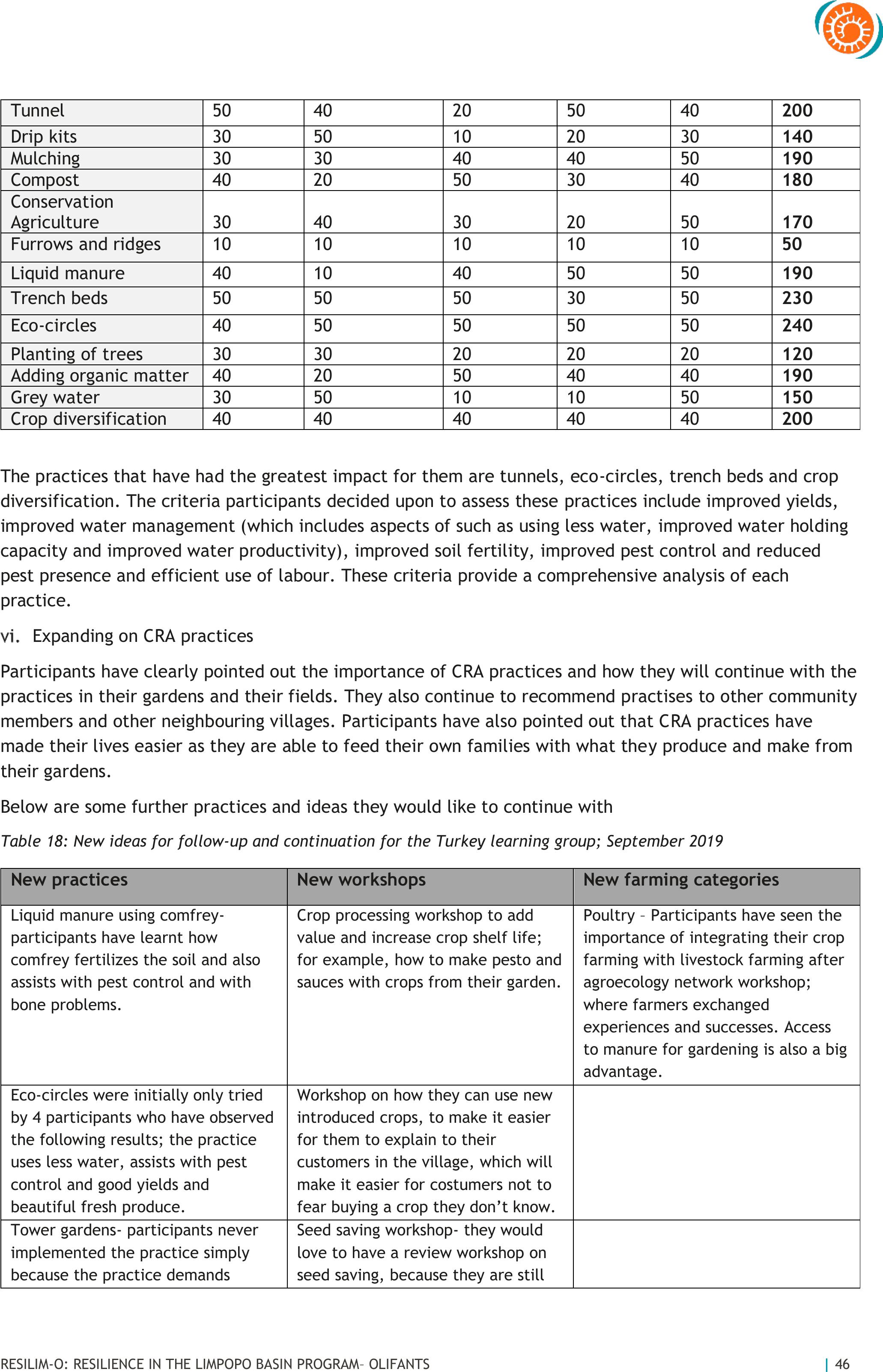
RESILIM-O: RESILIENCE IN THE LIMPOPO BASIN PROGRAM–OLIFANTS
| 46
Tunnel
50
40
20
50
40
200
Drip kits
30
50
10
20
30
140
Mulching
30
30
40
40
50
190
Compost
40
20
50
30
40
180
Conservation
Agriculture
30
40
30
20
50
170
Furrows and ridges
10
10
10
10
10
50
Liquid manure
40
10
40
50
50
190
Trench beds
50
50
50
30
50
230
Eco-circles
40
50
50
50
50
240
Planting of trees
30
30
20
20
20
120
Adding organic matter
40
20
50
40
40
190
Grey water
30
50
10
10
50
150
Crop diversification
40
40
40
40
40
200
The practices that have had the greatest impact for them are tunnels, eco-circles, trench beds and crop
diversification. The criteria participants decided upon to assess these practices include improved yields,
improved water management (which includes aspects of such as using less water, improved water holding
capacity and improved water productivity), improved soil fertility, improved pest control and reduced
pest presence andefficient use of labour. These criteria provide a comprehensive analysis of each
practice.
Expanding on CRA practices
Participants have clearly pointed out the importance of CRA practices and how they will continue with the
practices in their gardens and their fields. They also continue to recommend practises to other community
members and other neighbouring villages. Participants have also pointed out that CRA practices have
made their lives easier as they are able to feed their own families with what they produce andmake from
their gardens.
Below are some further practices and ideas they would like to continue with
Table 18: New ideas for follow-up and continuation for the Turkey learning group; September 2019
New practices
New workshops
New farming categories
Liquid manure using comfrey-
participants have learnt how
comfrey fertilizes the soil and also
assists with pest control and with
bone problems.
Crop processing workshop to add
value and increase crop shelf life;
for example, how to make pesto and
sauces with crops from their garden.
Poultry –Participants have seen the
importance of integrating their crop
farming with livestock farming after
agroecology network workshop;
where farmers exchanged
experiences and successes. Access
to manure for gardening is also a big
advantage.
Eco-circles were initially only tried
by 4 participants who have observed
the following results; the practice
uses less water, assists with pest
control and good yields and
beautiful fresh produce.
Workshop on how they can use new
introduced crops, to make it easier
for them to explain to their
customers in the village, which will
make it easier for costumers not to
fear buying a crop they don’t know.
Tower gardens- participants never
implemented the practice simply
because the practice demands
Seed saving workshop- they would
love to have a review workshop on
seed saving, because they are still

RESILIM-O: RESILIENCE IN THE LIMPOPO BASIN PROGRAM–OLIFANTS
| 47
bought materials and they felt that
trench beds provided equally good
results, but only required labour and
local materials.
experiencing storage problems for
saved seed.
Tunnels- Participants still want
tunnels in their gardens. Tunnels not
only protect their crops from
extreme heat, but combined with
trench beds and mixed cropping
there is good yield and water
management, not forgetting
beautiful fresh produce.
Workshop in business management;
to improve their ability to run their
farming as a sunniness and make a
reasonable income
In conclusion
Participants appreciated the knowledge gained from working with Mahlathini Development Foundation
through this project. They gave up on farmingbefore,because of the loss they made through
environmental and climatic changes with no knowledge of how to adapt to the changing environment and
climate. They also thanked MDF for the knowledge on crop diversity, using herbs and cover crops (fodder)
as examples. These new crops have made a big difference in continuity of production and ability to make
an income and they notedthat the project not only taught themnew things but alsogave them
opportunities to meet with other farmers to share experiences and challenges. This networking gave them
more courage to continue with their farming activities.
4.3.3Resilience snapshots
These individual interviews follow a similar process to the focus group discussions and add further
qualitative and quantitative information regarding impact.
26 of these snapshots were taken for participants from 5 of the 8 villages between April-September 2019.
Below is a summary of the responses.
4.3.3.1LEARNING AND CHANGE
What have you learnt about dealing with CC and climatic extremes?
➢I have learnt that practices such as trench beds and tunnels provide good growth and yields,
despite difficult weather conditions. Also, these practices are cheap. Although it is initially a lot
of work, the increased yields make a big difference. We get more food than we did before and
will now be able to continue farming
➢Tunnels also help in reducing heat and water stress in plants and this leads to much better
production
➢Tunnels help in this extreme heat by protecting our vegetables from heat and pests. Climate
smart practices enable us to continue with farming activities even in this difficult climate
change.
➢Having a tunnel and mulching inside the tunnel is the best in water management for irrigation.
➢Irrigation management, such as using drip kits help a lot as there is less evaporation and water is
saved. It also saves time.
➢Working with mixed cropping and crop rotation has decreased the incidence of pests and diseases,
although there are still problems.
➢Including more organic matter in the soil helps to hold water and to protect plants from heat
stress.

RESILIM-O: RESILIENCE IN THE LIMPOPO BASIN PROGRAM–OLIFANTS
| 48
➢Working with the five fingers principles [manage soil movement, manage soil fertility, manage
water, manage crops and manage natural resources) (tool) helps to keep in mind all different
aspects to include in changing practices
➢Using liquid manure and mixed cropping means that I now do not need any other means for pest
and disease control.
➢I have learnt about practices that will help me continue with farming activities even though
water is a struggle and the sun is too hot for any vegetable to survive in our environment, the
little we have been given is better than nothing.
➢Leaving the soil exposed to heat and rain and turning over the soil to plough and plant has
destroyed the soil making it infertile and very hard. Improving the soil takes time, but makes a
big difference in growth of crops.
➢I learnt to conserve water, by using grey water and mulching in my garden. I also learnt a lot on
the importance of soil health.
➢I have learned the importance of saving water and the conserving our soil.
➢I have experienced harsh weather with no rain and harvests using our traditional ways of
farming, which affected our livelihood as we had to buy all vegetables instead of growing them
myself. Now I know how to deal with changes of climate, since I met Mahlathini and AWARD, and
they taught us practices that changed my life. I don’t buy vegetables that I need every day, I pick
from my garden.
What is your experience regarding the impact of CC on your life?
➢Climate change has been hard on us, especially on our farming activities. Farming seems
impossible in this condition, especially with no rain. Being unemployed and relying on grants is
even worse, as the head of the household; farming makes it better because you farm for both
consumption and making an income
Do you share your knowledge and experiences with the learning group or community members?
➢Yes, I talk to my neighbours about the gardening practices, so that they can also try and
revive their gardens
➢Yes I share my experiences and knowledge with community members at the workshops and my
neighbours; by telling them what we do and how the knowledge is helping us in terms of
making things better
➢Yes I share my knowledge, especially with unemployed members of the community because I
am making a living and I don’t go hungry with my small garden
How do you share the knowledge gained with other members of your community?
➢Discussions at savings meetings, at the springs when we collect water
➢By inviting them to join us on our meetings and sharing experiences
➢Always have meetings where we invite community members to join and we share all knowledge
and experiences
➢I invite people community members to attend meeting with us and also allow community
members in my household
➢I share my experiences and knowledge learned from working with Mahlathini with the community
and I also recruit new members to join and learn like am learning.
➢I do visits community members selling them vegetables and share with them what I have learned
and how it is helping me, to encourage them to see what we are benefitingto better our finance
and was of farming
What helps you to learn more about new innovations and information?
No
(N=6)
Comments
Listening to other farmers
experiences and experiments
5
Bottom line is that farmers learn from farmers
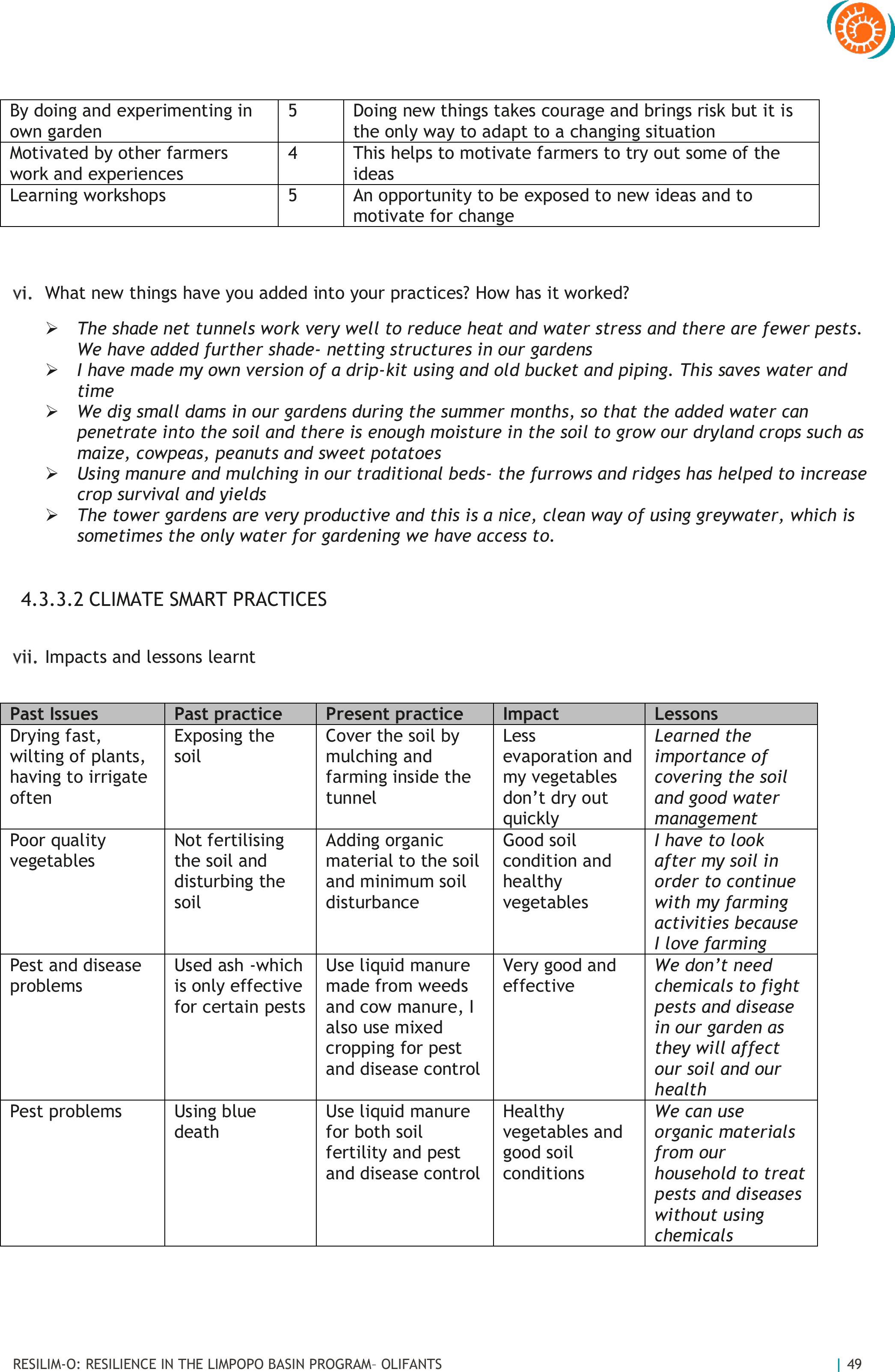
RESILIM-O: RESILIENCE IN THE LIMPOPO BASIN PROGRAM–OLIFANTS
| 49
By doing and experimenting in
own garden
5
Doing new things takes courage and brings risk but it is
the only way to adapt to a changing situation
Motivated by other farmers
work and experiences
4
This helps to motivate farmers to try out some of the
ideas
Learning workshops
5
An opportunity to be exposed to new ideas and to
motivate for change
What new things have you added into your practices? How has it worked?
➢The shade net tunnels work very well to reduce heat and water stress and there are fewer pests.
We have added further shade- netting structures in our gardens
➢I have made my own version of a drip-kit using and old bucket and piping. This saves water and
time
➢We dig small dams in our gardens during the summer months, so that the added water can
penetrate into the soil and there is enough moisture in the soil to grow our dryland crops such as
maize, cowpeas, peanuts and sweet potatoes
➢Using manure and mulching in our traditional beds- the furrows and ridges has helped to increase
crop survival and yields
➢The tower gardens are very productive and this is a nice, clean way of using greywater, which is
sometimes the only water for gardening we have access to.
4.3.3.2CLIMATE SMART PRACTICES
Impacts and lessons learnt
Past Issues
Past practice
Present practice
Impact
Lessons
Drying fast,
wilting of plants,
having to irrigate
often
Exposing the
soil
Cover the soil by
mulching and
farming inside the
tunnel
Less
evaporation and
my vegetables
don’t dry out
quickly
Learned the
importance of
covering the soil
and good water
management
Poor quality
vegetables
Not fertilising
the soil and
disturbing the
soil
Adding organic
material to the soil
and minimum soil
disturbance
Good soil
condition and
healthy
vegetables
I have to look
after my soil in
order to continue
with my farming
activities because
I love farming
Pest and disease
problems
Used ash -which
is only effective
for certain pests
Use liquid manure
made from weeds
and cow manure, I
also use mixed
cropping for pest
and disease control
Very good and
effective
We don’t need
chemicals to fight
pests and disease
in our garden as
they will affect
our soil and our
health
Pest problems
Using blue
death
Use liquid manure
for both soil
fertility and pest
and disease control
Healthy
vegetables and
good soil
conditions
We can use
organic materials
from our
household to treat
pests and diseases
without using
chemicals
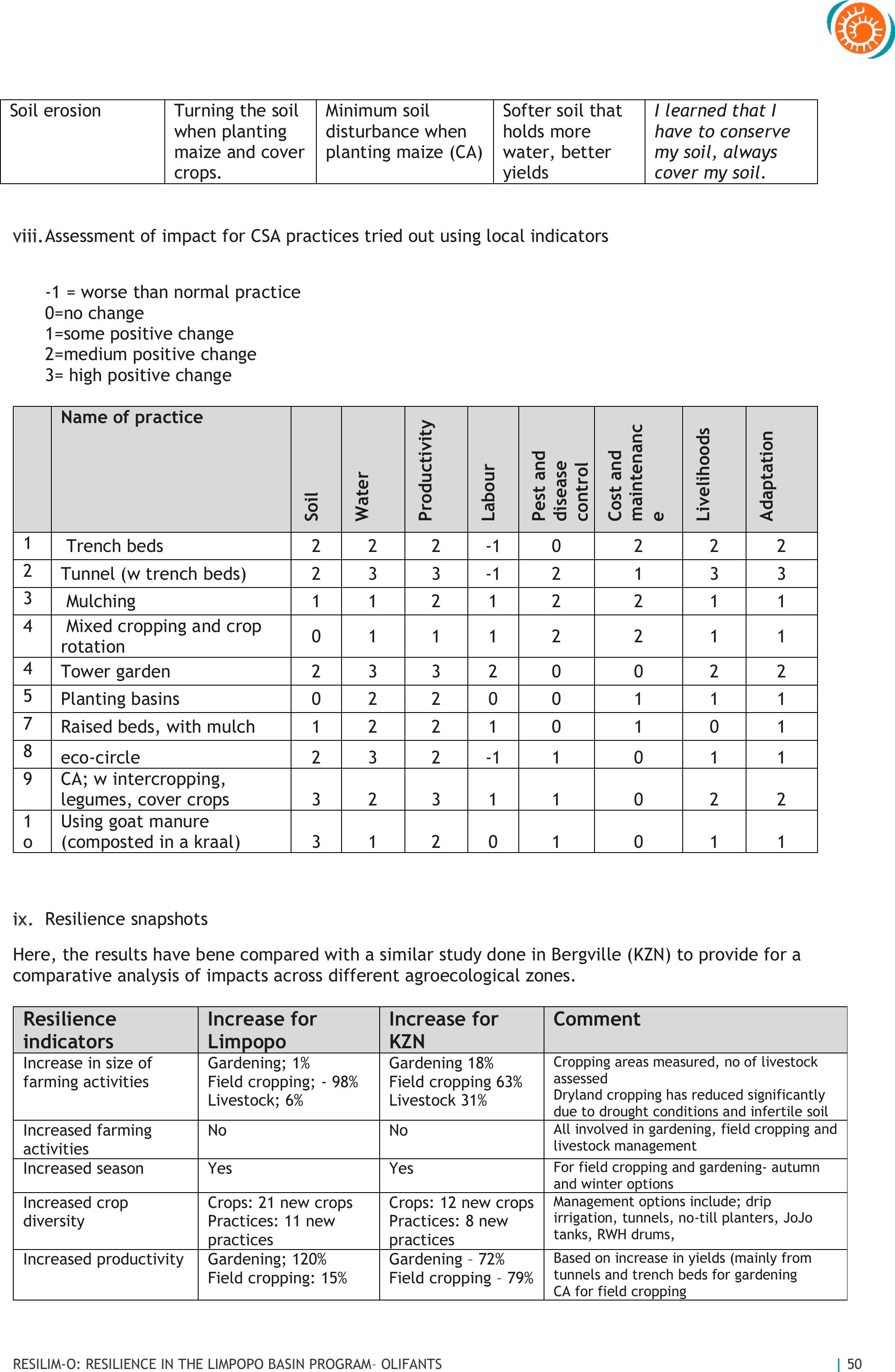
RESILIM-O: RESILIENCE IN THE LIMPOPO BASIN PROGRAM–OLIFANTS
| 50
Soil erosion
Turning the soil
when planting
maize and cover
crops.
Minimum soil
disturbance when
planting maize (CA)
Softer soil that
holds more
water, better
yields
I learned that I
have to conserve
my soil, always
cover my soil.
Assessment of impact for CSA practices tried out using local indicators
-1 = worse than normal practice
0=no change
1=some positive change
2=medium positive change
3= high positive change
Name of practice
Soil
Water
Productivity
Labour
Pest and
disease
control
Cost and
maintenanc
e
Livelihoods
Adaptation
1
Trench beds
2
2
2
-1
0
2
2
2
2
Tunnel (w trench beds)
2
3
3
-1
2
1
3
3
3
Mulching
1
1
2
1
2
2
1
1
4
Mixed cropping and crop
rotation
0
1
1
1
2
2
1
1
4
Tower garden
2
3
3
2
0
0
2
2
5
Planting basins
0
2
2
0
0
1
1
1
7
Raised beds, with mulch
1
2
2
1
0
1
0
1
8
eco-circle
2
3
2
-1
1
0
1
1
9
CA; w intercropping,
legumes, cover crops
3
2
3
1
1
0
2
2
1
o
Using goat manure
(composted in a kraal)
3
1
2
0
1
0
1
1
Resilience snapshots
Here, the results have bene compared with a similar study done in Bergville (KZN) to provide for a
comparative analysis of impacts across different agroecological zones.
Resilience
indicators
Increase for
Limpopo
Increase for
KZN
Comment
Increase in size of
farming activities
Gardening; 1%
Field cropping; - 98%
Livestock; 6%
Gardening 18%
Field cropping 63%
Livestock 31%
Cropping areas measured, no of livestock
assessed
Dryland cropping has reduced significantly
due to drought conditions and infertile soil
Increased farming
activities
No
No
All involved in gardening, field cropping and
livestock management
Increased season
Yes
Yes
For field cropping and gardening-autumn
and winter options
Increased crop
diversity
Crops: 21 new crops
Practices: 11 new
practices
Crops: 12 new crops
Practices: 8 new
practices
Management options include; drip
irrigation, tunnels, no-till planters, JoJo
tanks, RWH drums,
Increased productivity
Gardening; 120%
Field cropping: 15%
Gardening –72%
Field cropping –79%
Based on increase in yields (mainly from
tunnels and trench beds for gardening
CA for field cropping
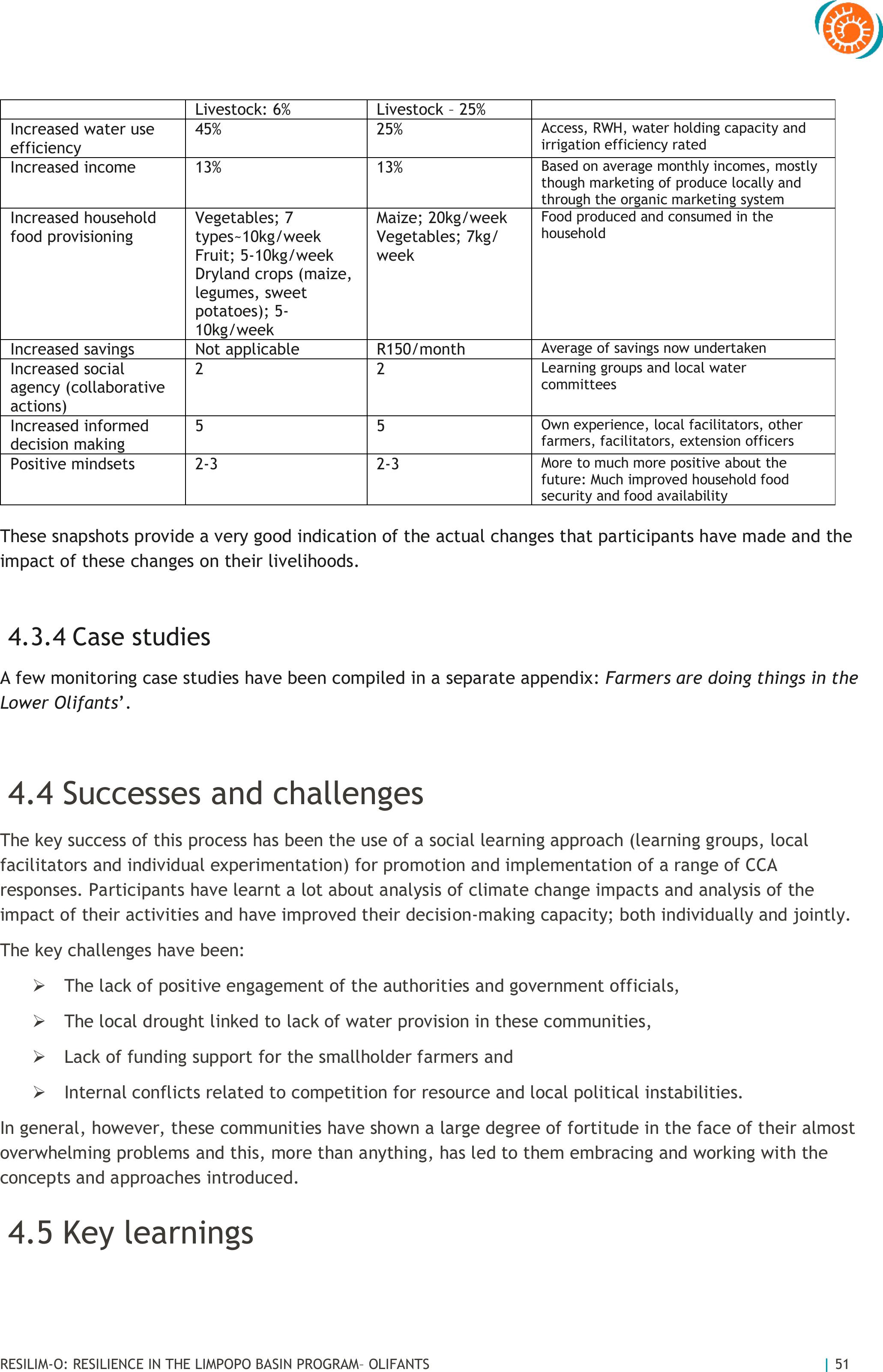
RESILIM-O: RESILIENCE IN THE LIMPOPO BASIN PROGRAM–OLIFANTS
| 51
Livestock: 6%
Livestock –25%
Increased water use
efficiency
45%
25%
Access, RWH, water holding capacity and
irrigation efficiency rated
Increased income
13%
13%
Based on average monthly incomes, mostly
though marketing of produce locally and
through the organic marketing system
Increased household
food provisioning
Vegetables; 7
types~10kg/week
Fruit; 5-10kg/week
Dryland crops (maize,
legumes, sweet
potatoes); 5-
10kg/week
Maize; 20kg/week
Vegetables; 7kg/
week
Food produced and consumed in the
household
Increased savings
Not applicable
R150/month
Average of savings now undertaken
Increased social
agency (collaborative
actions)
2
2
Learning groups and local water
committees
Increased informed
decision making
5
5
Own experience, local facilitators, other
farmers, facilitators, extension officers
Positive mindsets
2-3
2-3
More to much more positive about the
future: Much improved household food
security and food availability
These snapshots provide a very good indication of the actual changes that participants have made and the
impact of these changes on their livelihoods.
4.3.4Case studies
A few monitoring case studies have been compiled in a separate appendix: Farmers are doing things in the
Lower Olifants’.
4.4Successes and challenges
The key success of this process has been the use of a social learning approach (learning groups, local
facilitators and individual experimentation) for promotion and implementation of a range of CCA
responses. Participants have learnt a lot about analysis of climate change impacts and analysis of the
impact of their activities and have improved their decision-making capacity; both individually and jointly.
The key challenges have been:
➢The lack of positive engagement of the authorities and government officials,
➢The local drought linked to lack of water provision in these communities,
➢Lack of funding support for the smallholder farmers and
➢Internal conflicts related to competition for resource and local political instabilities.
In general,however, these communities have shown a large degree of fortitude in the face of their almost
overwhelming problemsand this, more than anything, has led to them embracing and working with the
concepts and approaches introduced.
4.5Key learnings
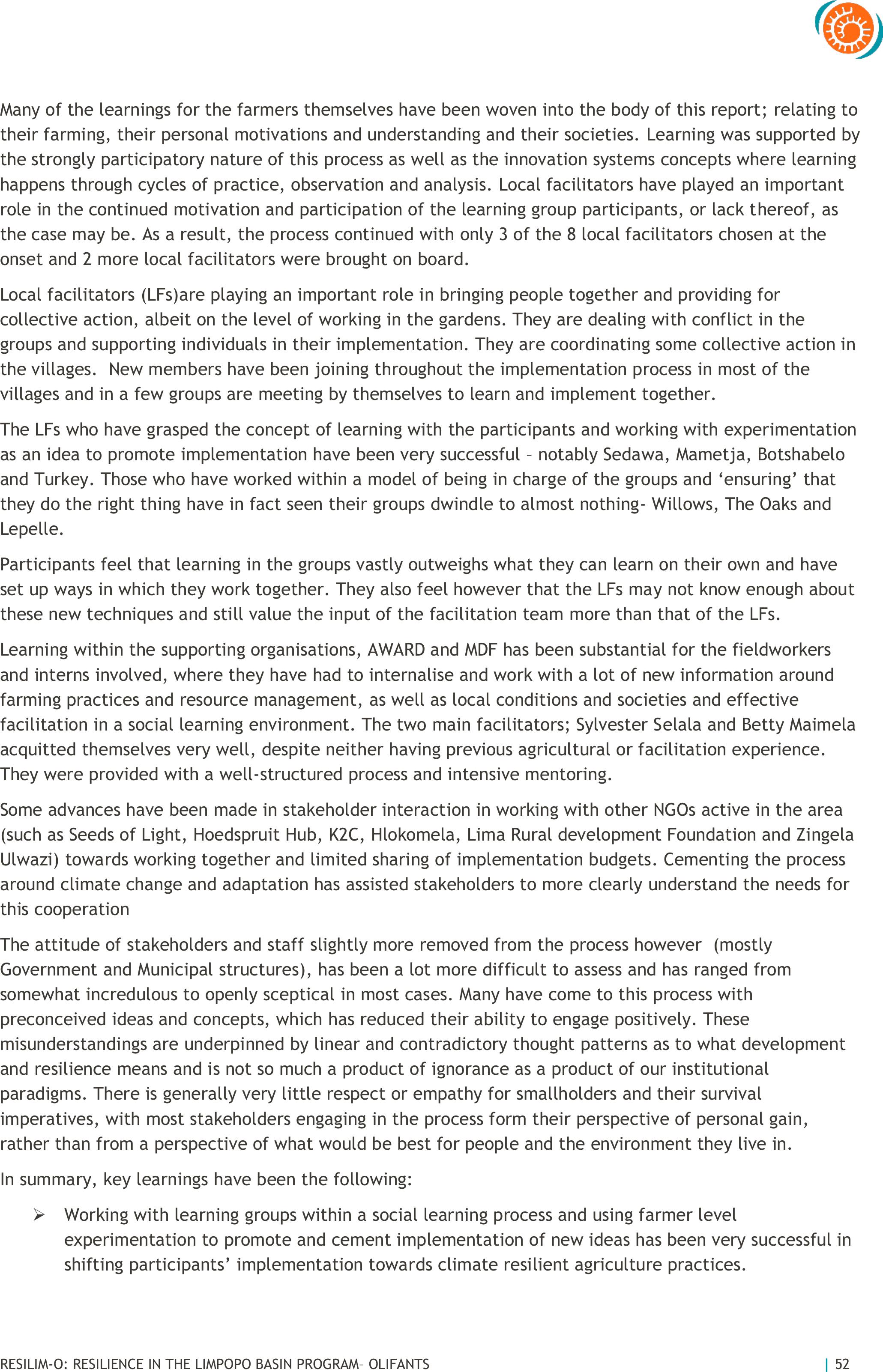
RESILIM-O: RESILIENCE IN THE LIMPOPO BASIN PROGRAM–OLIFANTS
| 52
Many of the learnings for the farmers themselves have been woven into the body of this report;relating to
their farming, their personal motivations and understanding and their societies.Learning was supported by
the strongly participatory nature of this process as well as the innovation systems concepts where learning
happens through cycles of practice, observation and analysis.Local facilitators have played an important
role in the continued motivation and participation of the learning group participants, or lack thereof, as
the case may be. As a result, the process continued with only 3 of the 8 local facilitators chosen at the
onset and 2 more local facilitators were brought on board.
Local facilitators (LFs)are playing an important role in bringing people together and providing for
collective action, albeit on the level of working in the gardens. They are dealing with conflict in the
groups and supporting individuals in their implementation. They are coordinating some collective action in
the villages. New members have been joining throughout the implementation processin most of the
villages and in a few groups are meeting by themselves to learn and implement together.
The LFs who have grasped the concept of learning with the participants and working with experimentation
as an idea to promote implementation have been very successful –notably Sedawa, Mametja, Botshabelo
and Turkey. Those who have worked within a model of being in charge of the groups and ‘ensuring’ that
they do the right thing have in fact seen their groups dwindle to almost nothing-Willows, The Oaks and
Lepelle.
Participants feel that learning in the groups vastly outweighs what they can learn on their own and have
set up ways in which they work together. They also feel however that the LFs may not know enough about
these new techniques and still value the input of the facilitation team more than that of the LFs.
Learning within the supporting organisations, AWARD and MDF has been substantial for the fieldworkers
and interns involved, where they have had to internalise and work with a lot of new information around
farming practices and resource management, as well as local conditions and societies and effective
facilitation in a social learning environment. The two main facilitators; Sylvester Selala and Betty Maimela
acquitted themselves very well, despite neither having previous agricultural or facilitation experience.
They were provided with a well-structured process and intensive mentoring.
Some advances have been made in stakeholder interaction in working with other NGOs active in the area
(such as Seeds of Light, Hoedspruit Hub, K2C, Hlokomela, Lima Rural development Foundation and Zingela
Ulwazi) towards working together and limited sharing of implementation budgets. Cementing the process
around climate change and adaptation has assisted stakeholders to more clearly understand the needs for
this cooperation
The attitude of stakeholders and staffslightly more removed from the process however(mostly
Government and Municipal structures), hasbeen a lot more difficult to assess and has ranged from
somewhat incredulous to openly scepticalin most cases. Many have come to this process with
preconceived ideas and concepts, which has reduced their ability to engage positively. These
misunderstandings are underpinned by linear and contradictory thought patterns as to what development
and resilience means and is not so much a product of ignorance as a product of our institutional
paradigms. There is generally very little respect or empathy for smallholders and their survival
imperatives, with most stakeholders engaging in the process form their perspective of personal gain,
rather than from a perspective of what would be best for people and the environment they live in.
In summary, key learnings have been the following:
➢Working with learning groups within a social learning process and using farmer level
experimentation to promote and cement implementation of new ideas has been very successful in
shifting participants’ implementation towards climate resilient agriculture practices.
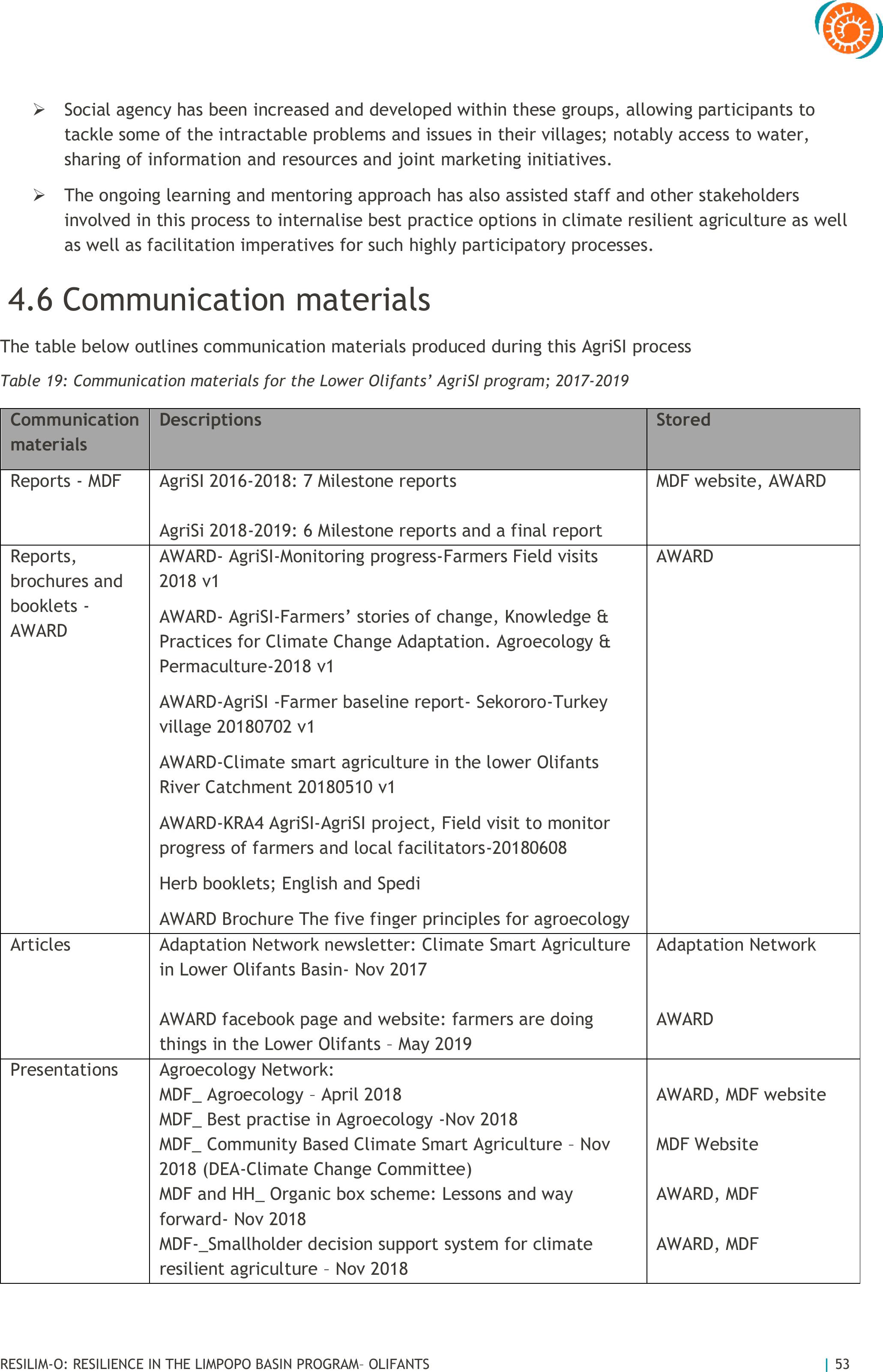
RESILIM-O: RESILIENCE IN THE LIMPOPO BASIN PROGRAM–OLIFANTS
| 53
➢Social agency has been increased and developed within these groups, allowing participants to
tackle some of the intractable problems and issues in their villages; notably access to water,
sharing of information and resources and joint marketing initiatives.
➢The ongoing learning and mentoring approach has also assisted staff and other stakeholders
involved in this process to internalise best practice options in climate resilient agriculture as well
as well as facilitation imperatives for such highly participatory processes.
4.6Communication materials
The table below outlines communication materials produced during this AgriSI process
Table 19: Communication materials for the Lower Olifants’ AgriSI program; 2017-2019
Communication
materials
Descriptions
Stored
Reports - MDF
AgriSI 2016-2018: 7 Milestone reports
AgriSi 2018-2019: 6 Milestone reports and a final report
MDF website, AWARD
Reports,
brochures and
booklets -
AWARD
AWARD- AgriSI-Monitoring progress-Farmers Field visits
2018 v1
AWARD- AgriSI-Farmers’ stories of change, Knowledge &
Practices for Climate Change Adaptation. Agroecology &
Permaculture-2018 v1
AWARD-AgriSI -Farmer baseline report- Sekororo-Turkey
village 20180702 v1
AWARD-Climate smart agriculture in the lower Olifants
River Catchment 20180510 v1
AWARD-KRA4 AgriSI-AgriSI project, Field visit to monitor
progress of farmers and local facilitators-20180608
Herb booklets; English and Spedi
AWARD Brochure The five finger principles for agroecology
AWARD
Articles
Adaptation Network newsletter: Climate Smart Agriculture
in Lower Olifants Basin- Nov 2017
AWARD facebook page and website: farmers are doing
things in the Lower Olifants –May 2019
Adaptation Network
AWARD
Presentations
Agroecology Network:
MDF_ Agroecology –April 2018
MDF_ Best practise in Agroecology -Nov 2018
MDF_ Community Based Climate Smart Agriculture –Nov
2018 (DEA-Climate Change Committee)
MDF and HH_ Organic box scheme: Lessons and way
forward- Nov 2018
MDF-_Smallholder decision support system for climate
resilient agriculture–Nov 2018
AWARD, MDF website
MDF Website
AWARD, MDF
AWARD, MDF
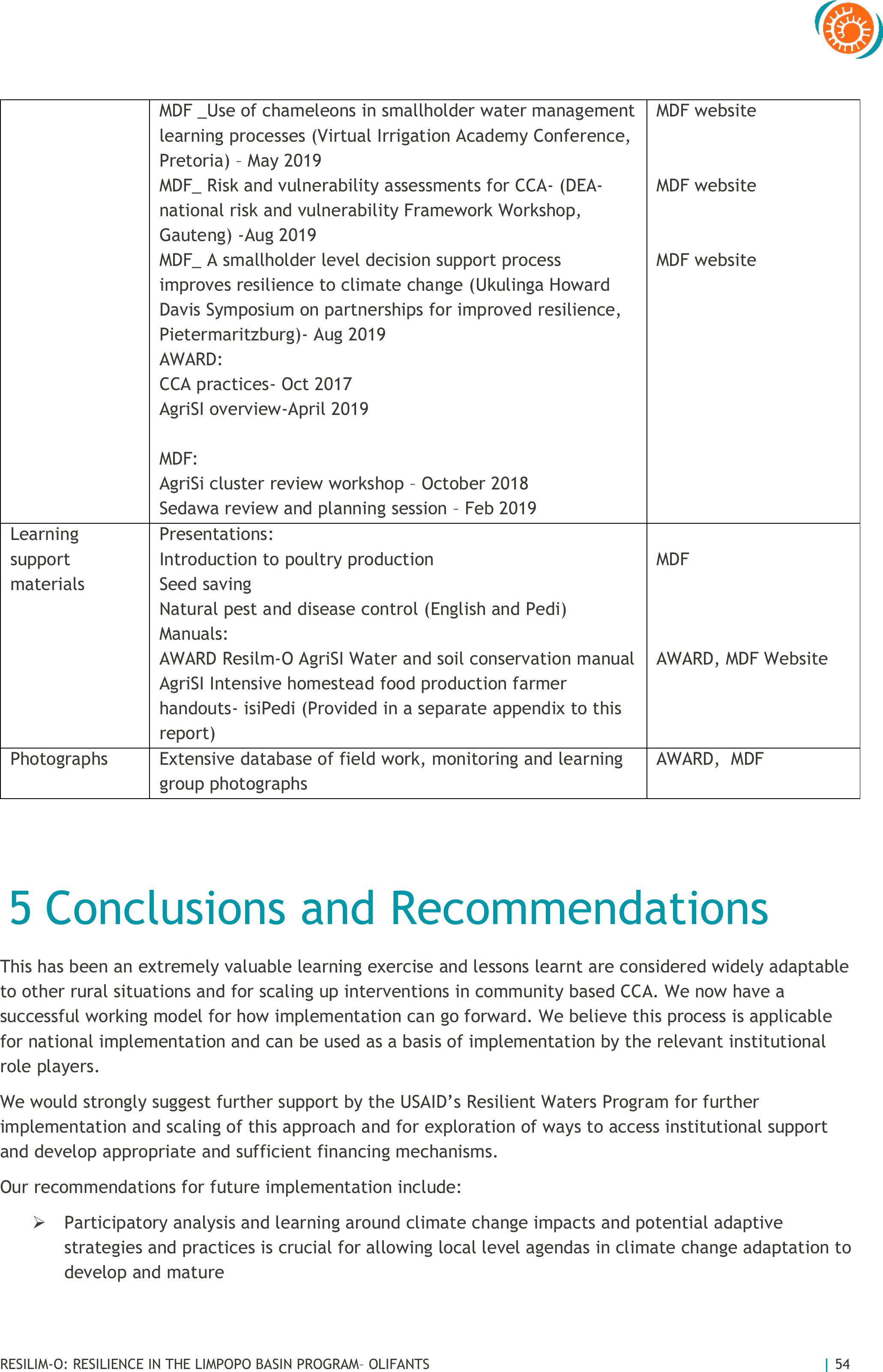
RESILIM-O: RESILIENCE IN THE LIMPOPO BASIN PROGRAM–OLIFANTS
| 54
MDF _Use of chameleons in smallholder water management
learning processes (Virtual Irrigation Academy Conference,
Pretoria) –May 2019
MDF_ Risk and vulnerability assessments for CCA- (DEA-
national risk and vulnerability Framework Workshop,
Gauteng) -Aug 2019
MDF_ A smallholder level decision support process
improves resilience to climate change (Ukulinga Howard
Davis Symposium on partnerships for improved resilience,
Pietermaritzburg)- Aug 2019
AWARD:
CCA practices- Oct 2017
AgriSI overview-April 2019
MDF:
AgriSi cluster review workshop –October 2018
Sedawa review and planning session –Feb 2019
MDF website
MDF website
MDF website
Learning
support
materials
Presentations:
Introduction to poultry production
Seed saving
Natural pest and disease control(English and Pedi)
Manuals:
AWARD Resilm-O AgriSI Water and soil conservation manual
AgriSI Intensivehomestead food production farmer
handouts- isiPedi (Provided in a separate appendix to this
report)
MDF
AWARD, MDF Website
Photographs
Extensive database of field work, monitoring and learning
group photographs
AWARD, MDF
5Conclusions and Recommendations
This has been an extremely valuable learning exercise and lessons learnt are considered widely adaptable
to other rural situations and for scaling up interventions in community based CCA. We now have a
successful working model for how implementation can go forward. We believe this process is applicable
for national implementation and can be used as a basis of implementation by the relevant institutional
role players.
We would strongly suggest further support by the USAID’s Resilient Waters Programfor further
implementation and scaling of this approach and for exploration of ways to access institutional support
and develop appropriate and sufficient financing mechanisms.
Our recommendations for future implementation include:
➢Participatory analysis and learning around climate change impacts and potential adaptive
strategies and practices is crucial for allowing local level agendas in climate change adaptation to
develop and mature
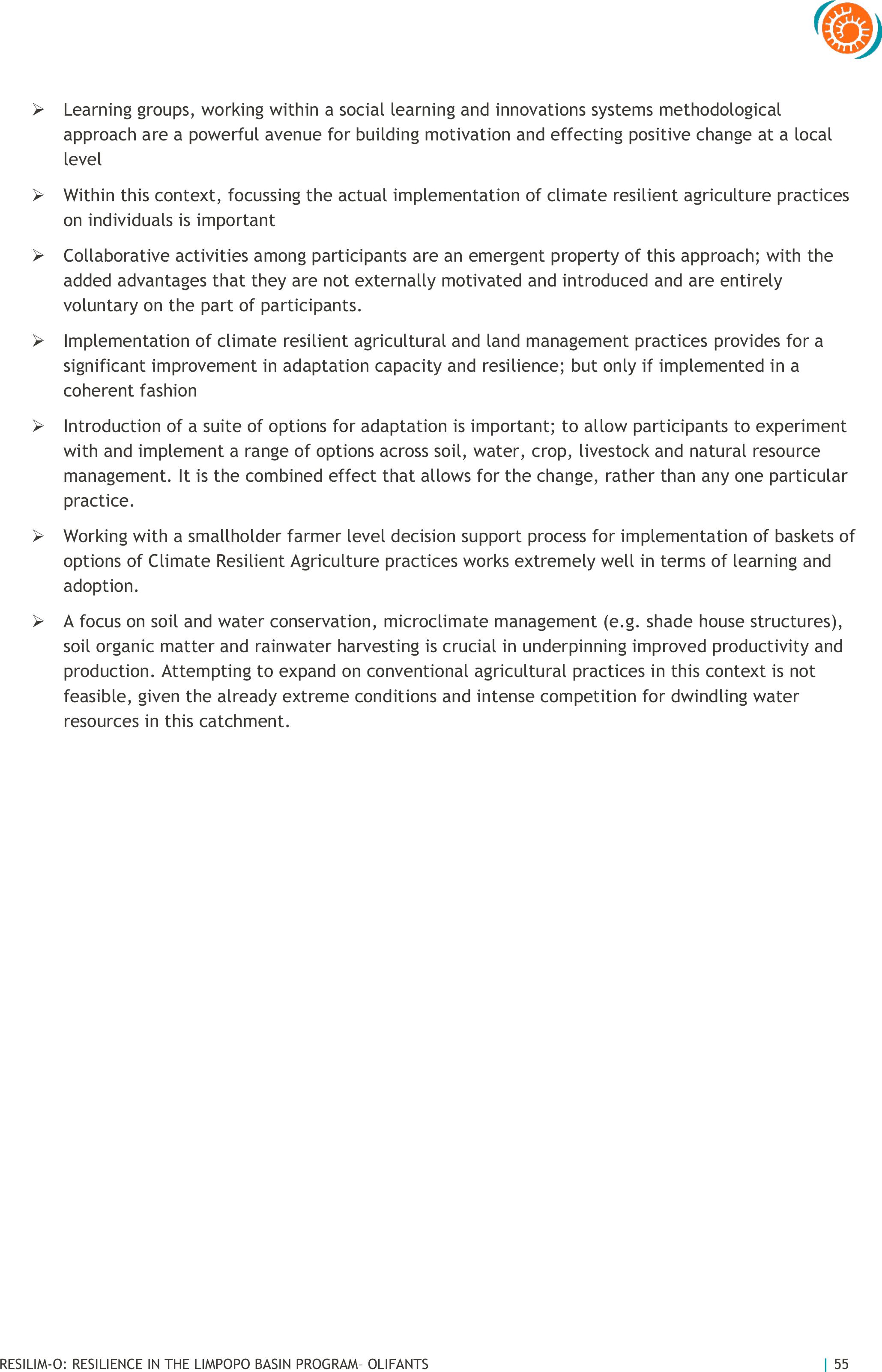
RESILIM-O: RESILIENCE IN THE LIMPOPO BASIN PROGRAM–OLIFANTS
| 55
➢Learning groups, working within a social learning and innovations systems methodological
approach are a powerful avenue for building motivation and effecting positive change at a local
level
➢Within this context, focussing the actual implementation of climate resilient agriculture practices
on individuals is important
➢Collaborative activities among participants are an emergent property of this approach; with the
added advantages that they are not externally motivated and introduced and are entirely
voluntary on the part of participants.
➢Implementation of climate resilient agricultural and land management practicesprovides for a
significant improvement in adaptation capacity and resilience; but only if implemented in a
coherent fashion
➢Introduction of a suite of options for adaptation is important; to allow participants to experiment
with and implement a range of options across soil, water, crop, livestock and natural resource
management. It is the combined effect that allows for the change, rather than any one particular
practice.
➢Working with a smallholder farmer level decision support process for implementation of baskets of
options of Climate Resilient Agriculture practices works extremely well in terms of learning and
adoption.
➢A focus on soil and water conservation, microclimate management (e.g. shade house structures),
soil organic matter and rainwater harvesting is crucial in underpinning improved productivity and
production. Attempting to expand on conventional agricultural practices in this context is not
feasible, given the already extreme conditions and intense competition for dwindling water
resources in this catchment.

RESILIM-O: RESILIENCE IN THE LIMPOPO BASIN PROGRAM–OLIFANTS
| 56
6 Attachments
Attachment 1
Community level climate change adaptation analysis
Below is an outline of the 2- day workshop process, which includes an example of the household
visits/walkabouts.
Community level climate change adaptation exploration workshop outline
DAY 1
Time
Activity
Process
Notes
Materials
Who
9:00am
INTRODUCTION
9:00-
9:45am
Community
and team
introductions
In pairs, take 5
minutes to talk to
each other. Then
introduce each other
to the group. Choose
a person you don’t
know well (both team
and community).
[include Name and
surname, farming
activities (garden,
field, livestock
natural resources),
income from farming]
Depending on
the size of the
group, this can
take a long time.
If time is short,
then just do a
quick round of
introductions.
Attendance register -
with columns for
farming enterprises (so
that each participant
can tick what they do)
- in English and
Zulu/Pedi. Name tags;
stickers, kokis
Materials
and
logistics:
Facilitation:
Recording:
Purpose of
the day
Introduction of the
organisation/sand
purpose of this
workshop- link to
already ongoing
activities if possible
and introduce visitors
and other
stakeholders involved
Talk to CC
necessitating
adaptation from
us - we may
need to change
how we do things
and what we do
to - This w/s is
to help us
explore options
for such changes
Flip stand, newsprint,
kokis, data projector,
screen, extension
cables, plugs - double
adaptors. Black refuse
bags and masking tape
(for blacking out
windows), camera- and
one person to
undertake to take
photos throughout the
day. Extra batteries for
camera and sim card
Materials
and
logistics:
Facilitation:
Recording:
9:50am
PRESENT SITUATION
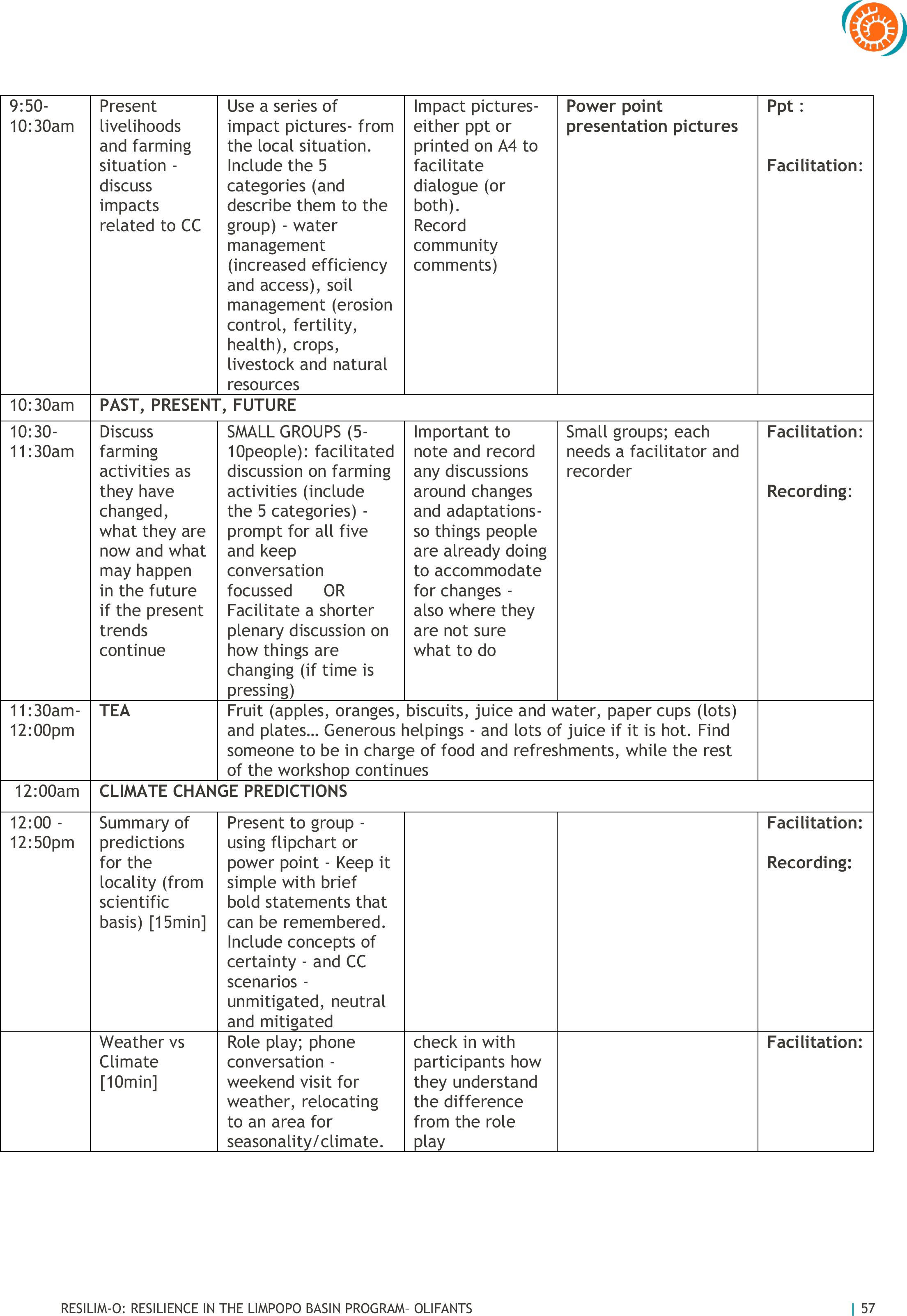
RESILIM-O: RESILIENCE IN THE LIMPOPO BASIN PROGRAM–OLIFANTS
| 57
9:50-
10:30am
Present
livelihoods
and farming
situation -
discuss
impacts
related to CC
Use a series of
impact pictures-from
the local situation.
Include the 5
categories (and
describe them to the
group) - water
management
(increased efficiency
and access), soil
management (erosion
control, fertility,
health), crops,
livestock and natural
resources
Impact pictures-
either ppt or
printed on A4 to
facilitate
dialogue (or
both).
Record
community
comments)
Power point
presentation pictures
Ppt :
Facilitation:
10:30am
PAST, PRESENT, FUTURE
10:30-
11:30am
Discuss
farming
activities as
they have
changed,
what they are
now and what
may happen
in the future
if the present
trends
continue
SMALL GROUPS (5-
10people): facilitated
discussion on farming
activities (include
the 5 categories) -
prompt for all five
and keep
conversation
focussed OR
Facilitate a shorter
plenary discussion on
how things are
changing (if time is
pressing)
Important to
note and record
any discussions
around changes
and adaptations-
so things people
are already doing
to accommodate
for changes -
also where they
are not sure
what to do
Small groups; each
needs a facilitator and
recorder
Facilitation:
Recording:
11:30am-
12:00pm
TEA
Fruit (apples, oranges, biscuits, juice and water, paper cups (lots)
and plates… Generous helpings - and lots of juice if it is hot. Find
someone to be in charge of food and refreshments, while the rest
of the workshop continues
12:00am
CLIMATE CHANGE PREDICTIONS
12:00 -
12:50pm
Summary of
predictions
for the
locality (from
scientific
basis) [15min]
Present to group -
using flipchart or
power point -Keep it
simple with brief
bold statements that
can be remembered.
Include concepts of
certainty - and CC
scenarios -
unmitigated, neutral
and mitigated
Facilitation:
Recording:
Weather vs
Climate
[10min]
Role play; phone
conversation -
weekend visit for
weather, relocating
to an area for
seasonality/climate.
check in with
participantshow
they understand
the difference
from the role
play
Facilitation:

RESILIM-O: RESILIENCE IN THE LIMPOPO BASIN PROGRAM–OLIFANTS
| 58
Seasonality
diagrams
[25min]
SMALL GROUPS (5-
10people): facilitated
discussion on
temperatures for
each month of the
year- in a normal
year and then discuss
how this is changing
and going to change.
Start with the hottest
month and then the
coldest month as
reference points
Do temperature
first or if the
group is small
and works
quickly include
rainfall then on
the same chart.
Easy to use kebab
sticks bought from
supermarket for this.
Small groups; each
needs a facilitator and
recorder
Facilitation:
Recording:
1:00pm
REALITY/IMPACT MAPS
1:00-
2:00pm
Impact of CC
mind map
SMALL GROUPS (5-
10people): facilitated
discussion -MIND
MAP of livelihood and
farming impacts
(using the 5
categories) using
Hotter (drier) as the
starting point -
LINKAGES between
cards on the mind
map - make arrows
(and include more
cards if needbe and
discuss (e.g. hotter
soils, lead to poor
germination lead to
poor yields lead to
hunger)
Prompt for
social,
economic,
environmental
impacts as well
if these don't
come up in the
group…
Small groups; each
needs a facilitator and
recorder
Facilitation:
Recording:
2:00-
2:30pm
Possible
adaptive
measures
POSSIBLE SOLUTIONS:
things that people
know, have changed,
have tried and or are
trying, to deal with
the changes. Use
different coloured
cards to attach these
solutions to the mind
map. If participants
are struggling then
rephrase the -ve
impact statements
into a +ve outcome
and ask what actions
are possible.
Also make a
separate list on
newsprint of
names of people
trying things plus
the innovation
they are trying
(this is to
facilitate h/h
visits on day 2)
The cards need to be
written in local
language with smaller
translations in English
written in on the cards
as well (to avoid the
need for alter
translations)
Facilitation:
Recording:
2:30-
2:45pm
CLOSURE
REPORT BACKS - of
possible solutions
PLANNING FOR DAY 2
- choose 3-4
participants for
household visits and
ask for a small group
of other interested
Households to be
within walking
distance
hopefully.
Otherwise drive
these 3-4
participants
around and meet
Rapporteurs need to be
chosen from the group
to summarise the
solutions in the report
backs [5min/group]
Facilitation:
Recording:
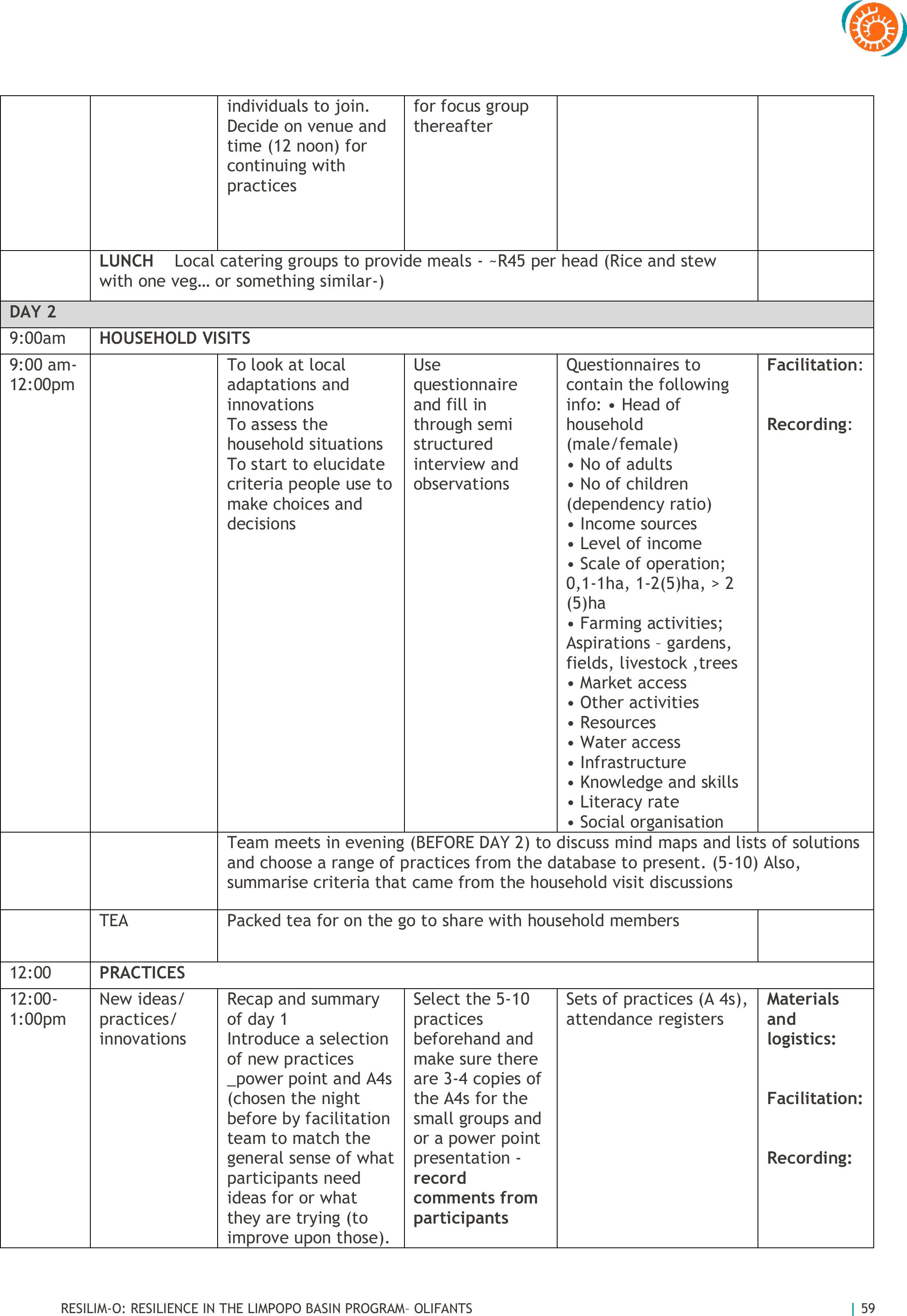
RESILIM-O: RESILIENCE IN THE LIMPOPO BASIN PROGRAM–OLIFANTS
| 59
individuals to join.
Decide on venue and
time (12 noon) for
continuing with
practices
for focus group
thereafter
LUNCH Local catering groups to provide meals - ~R45 per head (Rice and stew
with one veg… or something similar-)
DAY 2
9:00am
HOUSEHOLD VISITS
9:00 am-
12:00pm
To look at local
adaptations and
innovations
To assess the
household situations
To start to elucidate
criteria people use to
make choices and
decisions
Use
questionnaire
and fill in
through semi
structured
interview and
observations
Questionnaires to
contain the following
info: • Head of
household
(male/female)
•No of adults
• No of children
(dependency ratio)
• Income sources
• Level of income
• Scale of operation;
0,1-1ha, 1-2(5)ha, > 2
(5)ha
• Farming activities;
Aspirations –gardens,
fields, livestock ,trees
• Market access
• Other activities
• Resources
• Water access
• Infrastructure
• Knowledge and skills
• Literacy rate
• Social organisation
Facilitation:
Recording:
Team meets in evening (BEFORE DAY 2) to discuss mindmaps and lists of solutions
and choose a range of practices from the database to present. (5-10) Also,
summarise criteria that came from the household visit discussions
TEA
Packed tea for on the go to share with household members
12:00
PRACTICES
12:00-
1:00pm
New ideas/
practices/
innovations
Recap and summary
of day 1
Introduce a selection
of new practices
_power point and A4s
(chosen the night
before by facilitation
team to match the
general sense of what
participants need
ideas for or what
they are trying (to
improve upon those).
Select the 5-10
practices
beforehand and
make sure there
are 3-4 copies of
the A4s for the
small groups and
or a power point
presentation -
record
comments from
participants
Sets of practices (A 4s),
attendance registers
Materials
and
logistics:
Facilitation:
Recording:

RESILIM-O: RESILIENCE IN THE LIMPOPO BASIN PROGRAM–OLIFANTS
| 60
Provide descriptions
and get questions
and comments
1:00-
1:20pm
Criteria for
selection of
practices
In plenary present
criteria, discuss with
group and add more
(prompt for criteria
to relate to five
categories (e.g.,
saving and using
water well,
increasing access to
water, improving
organic matter,
increasing soil
health, increasing
natural resources....
etc) along with
criteria like cost,
labour, time....
Choose 5-7/8
criteria max.
Some criteria
can be made
from two into
one…
Flipchart, newsprint,
kokis
Facilitation:
Recording:
1:20 -
2:00pm
Prioritization
of practices
SMALL GROUPS:
Choose a selection of
practices from their
own suggestions and
new ideas presented
(5-10) and assess
them using the
criteria chosen in a
matrix.
Let the group
decide for each
square using a
scale of 0-2
where 0 = bad or
little, 1=ok to
medium and 2 =
a lot to good.
Newsprint, kokis.
Small group facilitator
and recorder
Facilitation:
Recording:
2:00pm
WAY FORWARD
2:00-
2:30pm
Each individual choses their practices
Set up sessions in January to refine
choices and start on demonstrations
and training in implementation of
practices and farmer experimentation
Choose 'volunteers' for the 4 proposed
tunnels for joint /group
experimentation per site
Learning sessions
Put together a list for
each small group for
each individualto
record their name,
surname, tel /cell
phone and practices
Facilitation:
Recording:
LUNCH Local catering groups to provide meals - (Rice and stew with one veg… or
something similar-)
CLIMATE CHANGE PREDICTIONS:
Hotter
1-4 degrees Celsius
For every month of
the year
HIGH probability/
Certainty
Less rain
Similar amount of rain but
over a shorter period of time
(fewer rainy days per season)
This will lead to an
overall drying effect
in the environment
MEDIUM certainty
Greater intensity of rainfall
More rain in spring and or
more rain in summer
Storms
LOW certainty
Longer term
Greater frequency of droughts under scenarios 1 and
2
Scenario 1 -Business as
usual; Scenario 2 -
Stabilise emissions;
Scenario- 3-Reduce
emissions
Greater frequency of extreme rainfall events under
scenarios 1 and 2
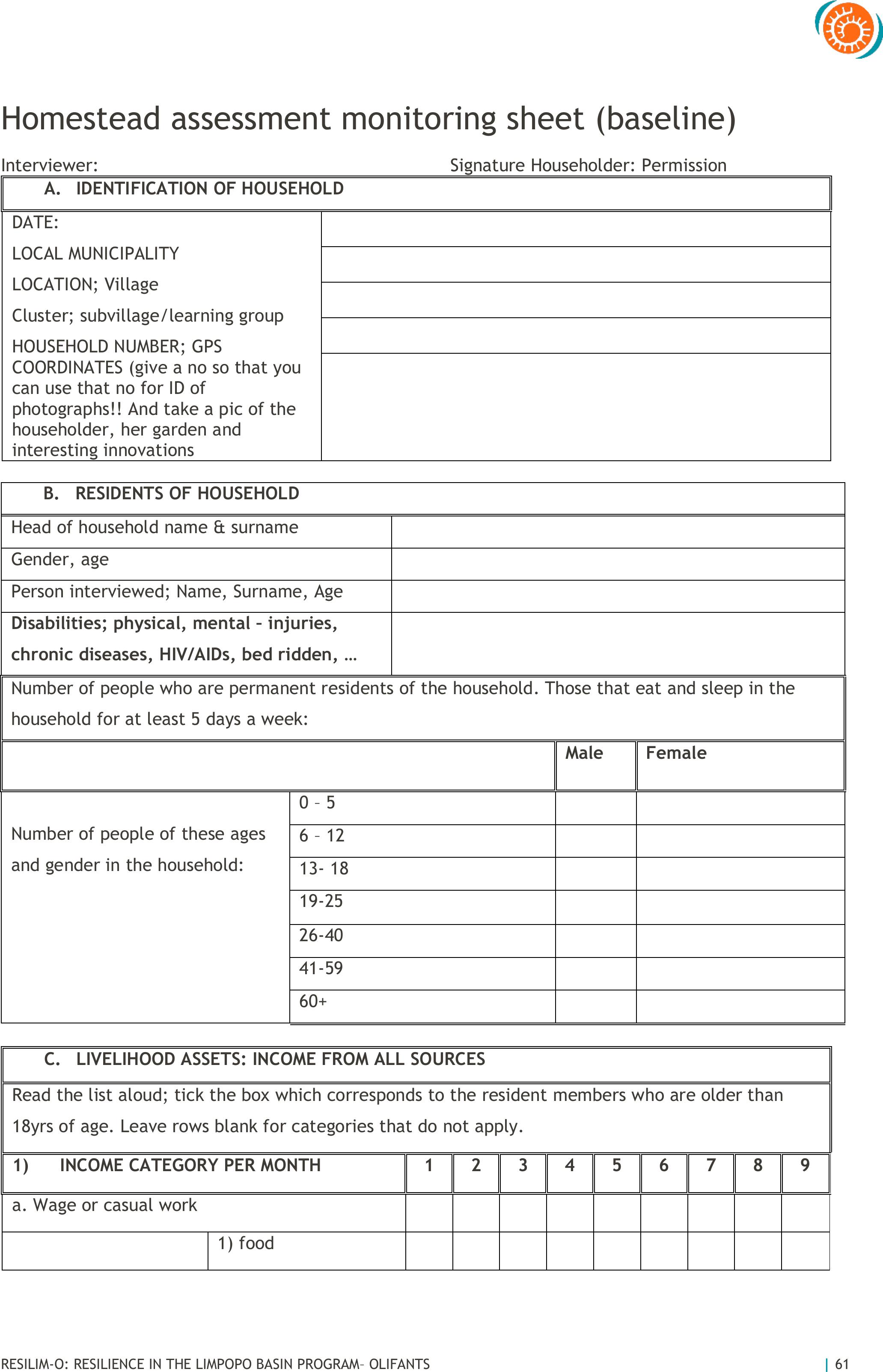
RESILIM-O: RESILIENCE IN THE LIMPOPO BASIN PROGRAM–OLIFANTS
| 61
Homestead assessment monitoring sheet (baseline)
Interviewer: Signature Householder: Permission
A. IDENTIFICATION OF HOUSEHOLD
DATE:
LOCAL MUNICIPALITY
LOCATION; Village
Cluster; subvillage/learning group
HOUSEHOLD NUMBER; GPS
COORDINATES (give a no so that you
can use that no for ID of
photographs!! And take a pic of the
householder, her garden and
interesting innovations
B. RESIDENTS OF HOUSEHOLD
Head of household name & surname
Gender, age
Person interviewed; Name, Surname, Age
Disabilities; physical, mental –injuries,
chronic diseases, HIV/AIDs, bed ridden, …
Number of people who are permanent residents of the household. Those that eat and sleep in the
household for at least 5 days a week:
Male
Female
Number of people of these ages
and gender in the household:
0 –5
6 –12
13-18
19-25
26-40
41-59
60+
C. LIVELIHOOD ASSETS: INCOME FROM ALL SOURCES
Read the list aloud; tick the box which corresponds to the resident members who are older than
18yrs of age. Leave rows blank for categories that do not apply.
1) INCOME CATEGORY PER MONTH
1
2
3
4
5
6
7
8
9
a. Wage or casual work
1) food
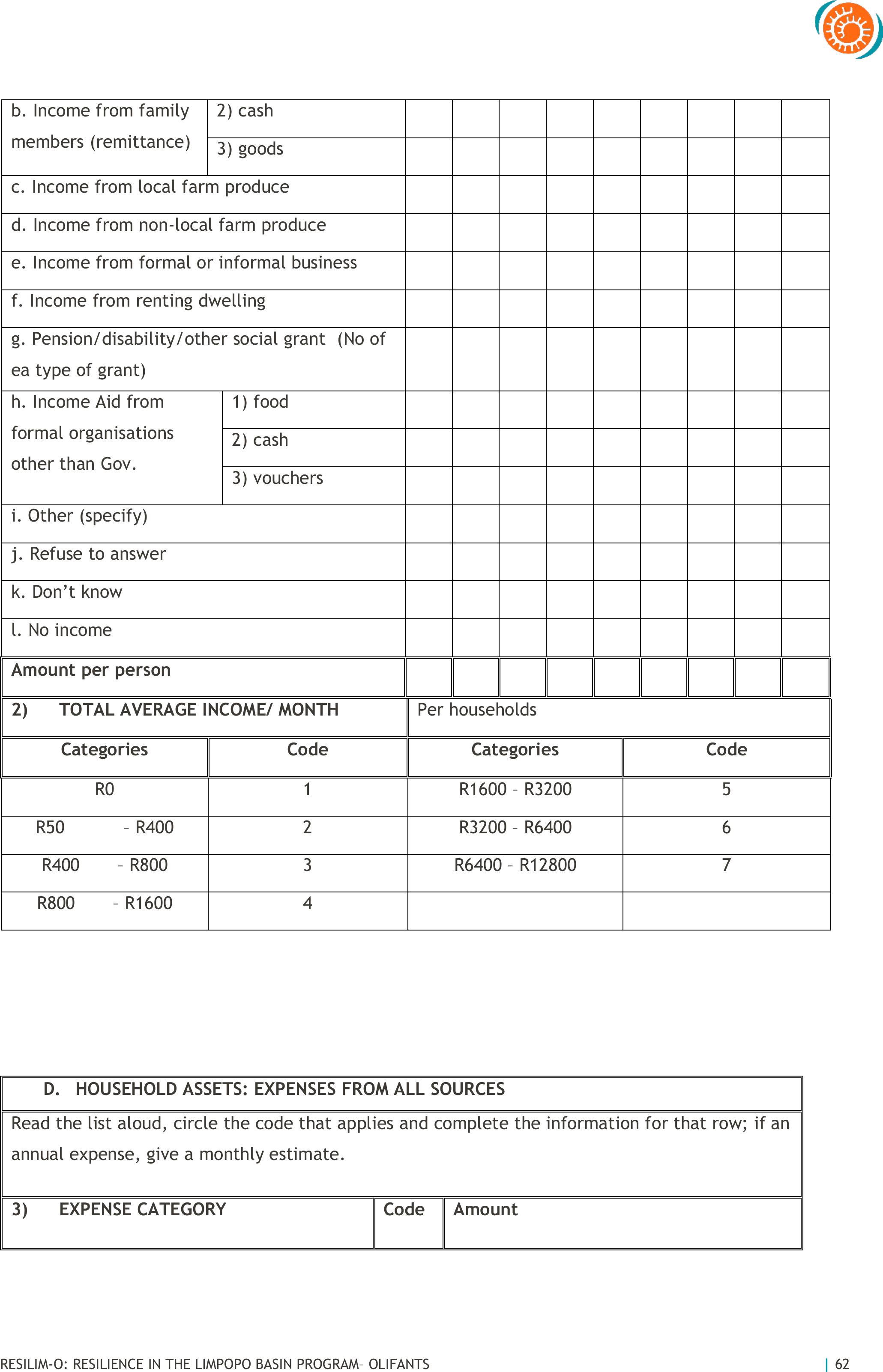
RESILIM-O: RESILIENCE IN THE LIMPOPO BASIN PROGRAM–OLIFANTS
| 62
D. HOUSEHOLD ASSETS: EXPENSES FROM ALL SOURCES
Read the list aloud, circle the code that applies and complete the information for that row; if an
annual expense, give a monthly estimate.
3) EXPENSE CATEGORY
Code
Amount
b. Income from family
members (remittance)
2) cash
3) goods
c. Income from local farm produce
d. Income from non-local farm produce
e. Income from formal or informal business
f. Income from renting dwelling
g. Pension/disability/other social grant(No of
ea type of grant)
h. Income Aid from
formal organisations
other than Gov.
1) food
2) cash
3) vouchers
i. Other (specify)
j. Refuse to answer
k. Don’t know
l. No income
Amount per person
2) TOTAL AVERAGE INCOME/ MONTH
Per households
Categories
Code
Categories
Code
R0
1
R1600 –R3200
5
R50 –R400
2
R3200 –R6400
6
R400 –R800
3
R6400 –R12800
7
R800 –R1600
4
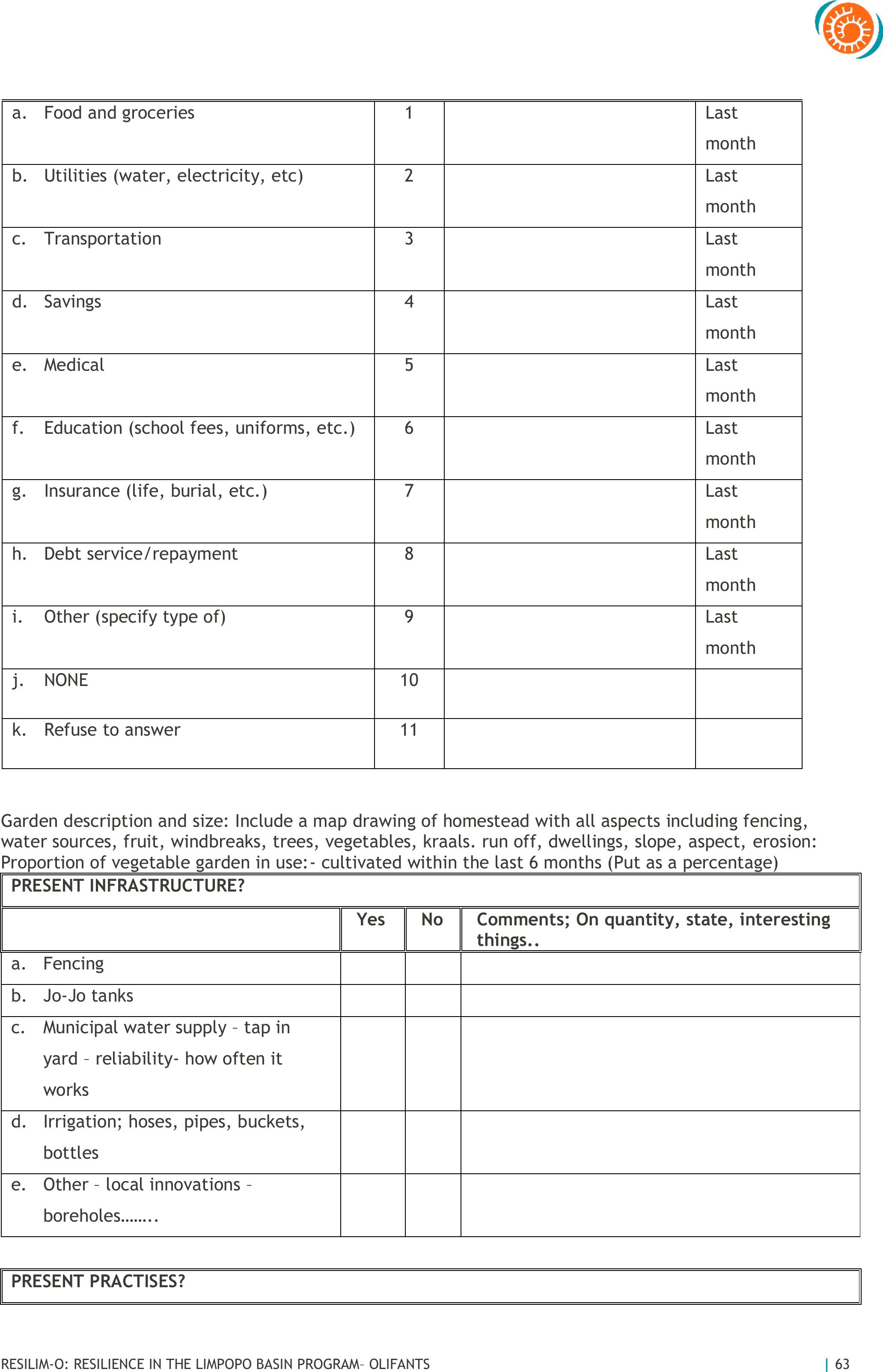
RESILIM-O: RESILIENCE IN THE LIMPOPO BASIN PROGRAM–OLIFANTS
| 63
a. Food and groceries
1
Last
month
b. Utilities (water, electricity, etc)
2
Last
month
c. Transportation
3
Last
month
d. Savings
4
Last
month
e. Medical
5
Last
month
f. Education (school fees, uniforms, etc.)
6
Last
month
g. Insurance (life, burial, etc.)
7
Last
month
h. Debt service/repayment
8
Last
month
i. Other (specify type of)
9
Last
month
j. NONE
10
k. Refuse to answer
11
Garden description and size: Include a map drawing of homestead with all aspects including fencing,
water sources, fruit, windbreaks, trees, vegetables, kraals. run off, dwellings, slope, aspect, erosion:
Proportion of vegetable garden in use:-cultivated within the last 6 months (Put as a percentage)
PRESENT INFRASTRUCTURE?
Yes
No
Comments; On quantity, state, interesting
things..
a. Fencing
b. Jo-Jo tanks
c. Municipal water supply –tap in
yard –reliability-how often it
works
d. Irrigation; hoses, pipes, buckets,
bottles
e. Other –local innovations –
boreholes……..
PRESENT PRACTISES?
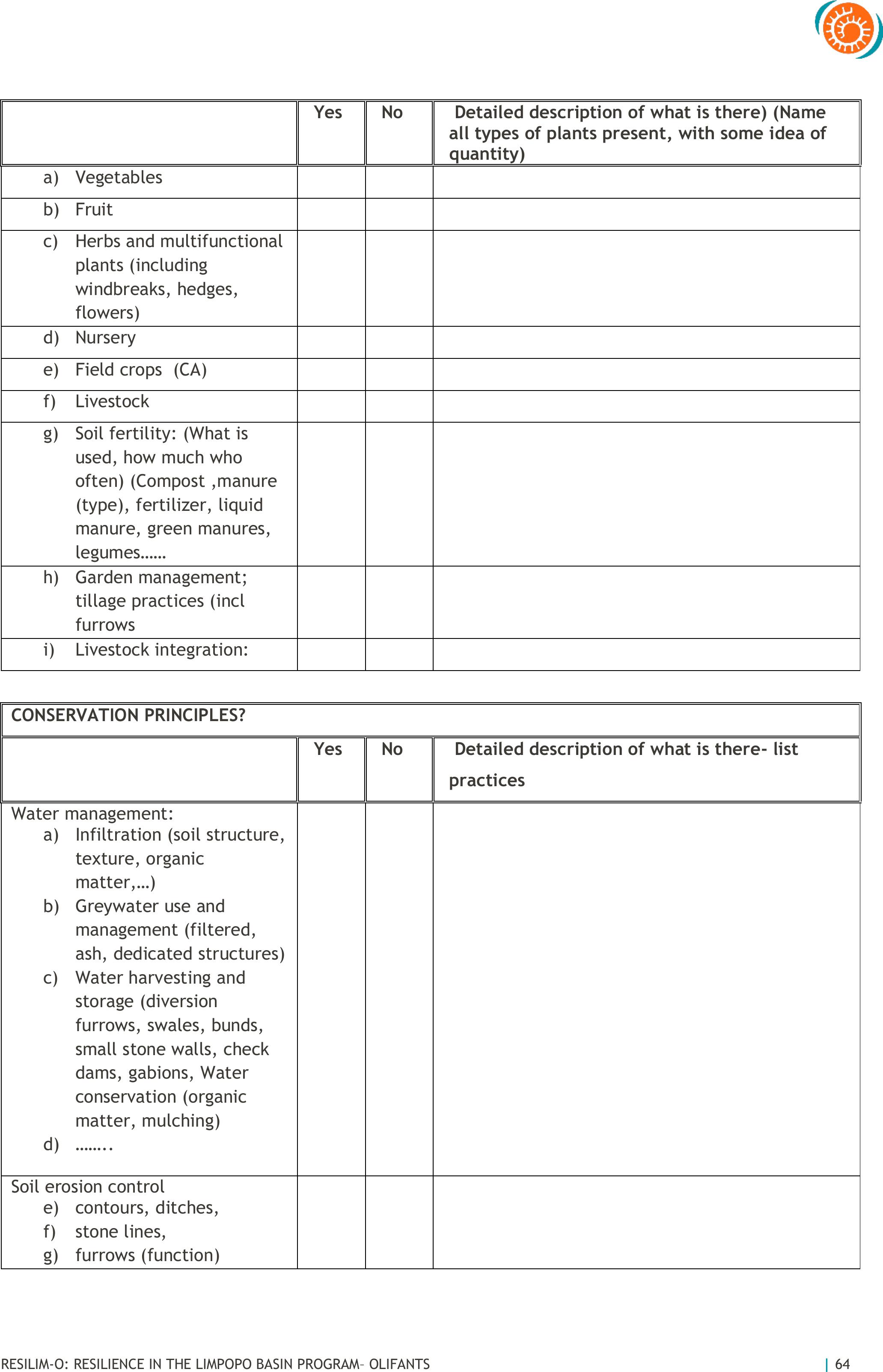
RESILIM-O: RESILIENCE IN THE LIMPOPO BASIN PROGRAM–OLIFANTS
| 64
Yes
No
Detailed description of what is there) (Name
all types of plants present, with some idea of
quantity)
a) Vegetables
b) Fruit
c) Herbs and multifunctional
plants (including
windbreaks, hedges,
flowers)
d) Nursery
e) Field crops (CA)
f) Livestock
g) Soil fertility: (What is
used, how much who
often) (Compost ,manure
(type), fertilizer, liquid
manure, green manures,
legumes……
h) Garden management;
tillage practices (incl
furrows
i) Livestock integration:
CONSERVATION PRINCIPLES?
Yes
No
Detailed description of what is there- list
practices
Water management:
a) Infiltration (soil structure,
texture, organic
matter,…)
b) Greywater use and
management (filtered,
ash, dedicated structures)
c) Water harvesting and
storage (diversion
furrows, swales, bunds,
small stone walls, check
dams, gabions, Water
conservation (organic
matter, mulching)
d) ……..
Soil erosion control
e) contours, ditches,
f) stone lines,
g) furrows (function)

RESILIM-O: RESILIENCE IN THE LIMPOPO BASIN PROGRAM–OLIFANTS
| 65
h) …………..
Soil health
i) State of soil; presence of
organic matter, presence
of erosion, presence of
compaction (is the soil
very hard just below the
surface,
j) Bed design (trench beds,
ridges, dedicated beds
and paths, terraces,
sunken/raised beds,
k) Compost, improved
manure, green manures,
legumes,
l) ………
Diversity/ crop management
m) Mixed cropping
n) Crop rotation
o) Seed saving
p) Nursery/ propagation
q) Continuity- seedling
production
r) Natural pest and disease
control practices
s) ……………………..
Wild/ diverse plants
t) Indigenous or medicinal
plants
u) Windbreaks/ hedges/ live
fencing
v) Herbs, bee fodder, pest
and disease control
species
HOUSEHOLD PROVISIONING (comments from interviewee)
Food provided for family; what, how much, how often (staples ,vegetables, fruit, small livestock):
Nutritional aspects of cropping:
Selling: what, how much, how often

RESILIM-O: RESILIENCE IN THE LIMPOPO BASIN PROGRAM–OLIFANTS
| 66
Household observation checklist (for the interviewer)
Extent and diversity of garden
(presence of resources,
manure, different trees, ….
Labour and general health
Overall situation in the
household (are there any
obvious social issues)
Any local innovations and
interesting things (different
plants, unusual crops –e.g.
white sorghum, millet, jugo
beans, herbs, wild plants,
medicinal plants, herbs,
fruit) ….
Social engagement –groups,
stokvels, church, farming,
selling,
Non agricultural livelihood
activities (e.g craft, use of
natural resources in the area,
selling water…?…
Environmental issues; soil
degradation, erosion,
Potential for SWC and RWH –
are there nice paved areas, no
of houses to collect water from,
willingness in household to
contribute labour
Suitability for technical
innovation (greenhouse, drip
kits, RWH)-
Potential as local facilitator
Interest and potential for field
cropping and being a CA
volunteer
Other
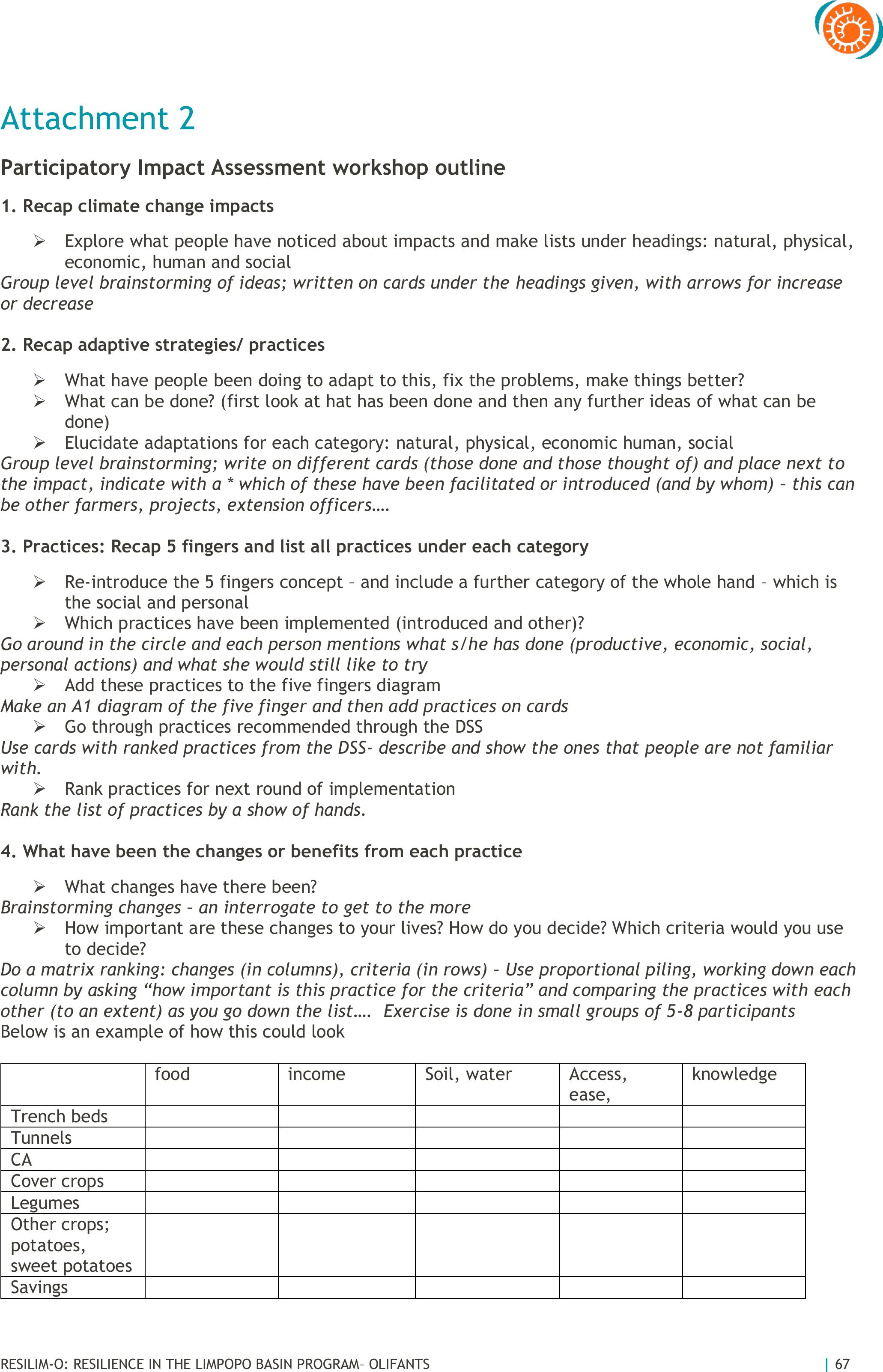
RESILIM-O: RESILIENCE IN THE LIMPOPO BASIN PROGRAM–OLIFANTS
| 67
Attachment 2
Participatory Impact Assessment workshop outline
1. Recap climate change impacts
➢Explore what people have noticed about impacts and make lists under headings: natural, physical,
economic, human and social
Group level brainstorming of ideas; written on cards under the headings given, with arrows for increase
or decrease
2. Recap adaptive strategies/ practices
➢What have people been doing to adapt to this, fix the problems, make things better?
➢What can be done? (first look at hat has been done and then any further ideas of what can be
done)
➢Elucidate adaptations for each category: natural, physical, economic human, social
Group level brainstorming; write on different cards (those done and those thought of) and place next to
the impact, indicate with a * which of these have been facilitated or introduced (and by whom) –this can
be other farmers, projects, extension officers….
3. Practices: Recap 5 fingers and list all practices under each category
➢Re-introduce the 5 fingersconcept –and include a further category of the whole hand –which is
the social and personal
➢Which practices have been implemented (introduced and other)?
Go around in the circle and each person mentions what s/he has done (productive, economic, social,
personal actions) and what she would still like to try
➢Add these practices to the five fingers diagram
Make an A1 diagram of the five finger and then add practices on cards
➢Go through practices recommended through the DSS
Use cards with ranked practices from the DSS- describe and show the ones that people are not familiar
with.
➢Rank practices for next round of implementation
Rank the list of practices by a show of hands.
4. What have been the changes or benefits from each practice
➢What changes have there been?
Brainstorming changes–an interrogate to get to the more
➢How important are these changes to your lives? How do you decide? Which criteria would you use
to decide?
Do a matrix ranking: changes (in columns), criteria (in rows) –Use proportional piling, working down each
column by asking “how important is this practice for the criteria” and comparing the practices with each
other (to an extent) as you go down the list…. Exercise is done in small groups of 5-8 participants
Below is an example of how this could look
food
income
Soil, water
Access,
ease,
knowledge
Trench beds
Tunnels
CA
Cover crops
Legumes
Other crops;
potatoes,
sweet potatoes
Savings
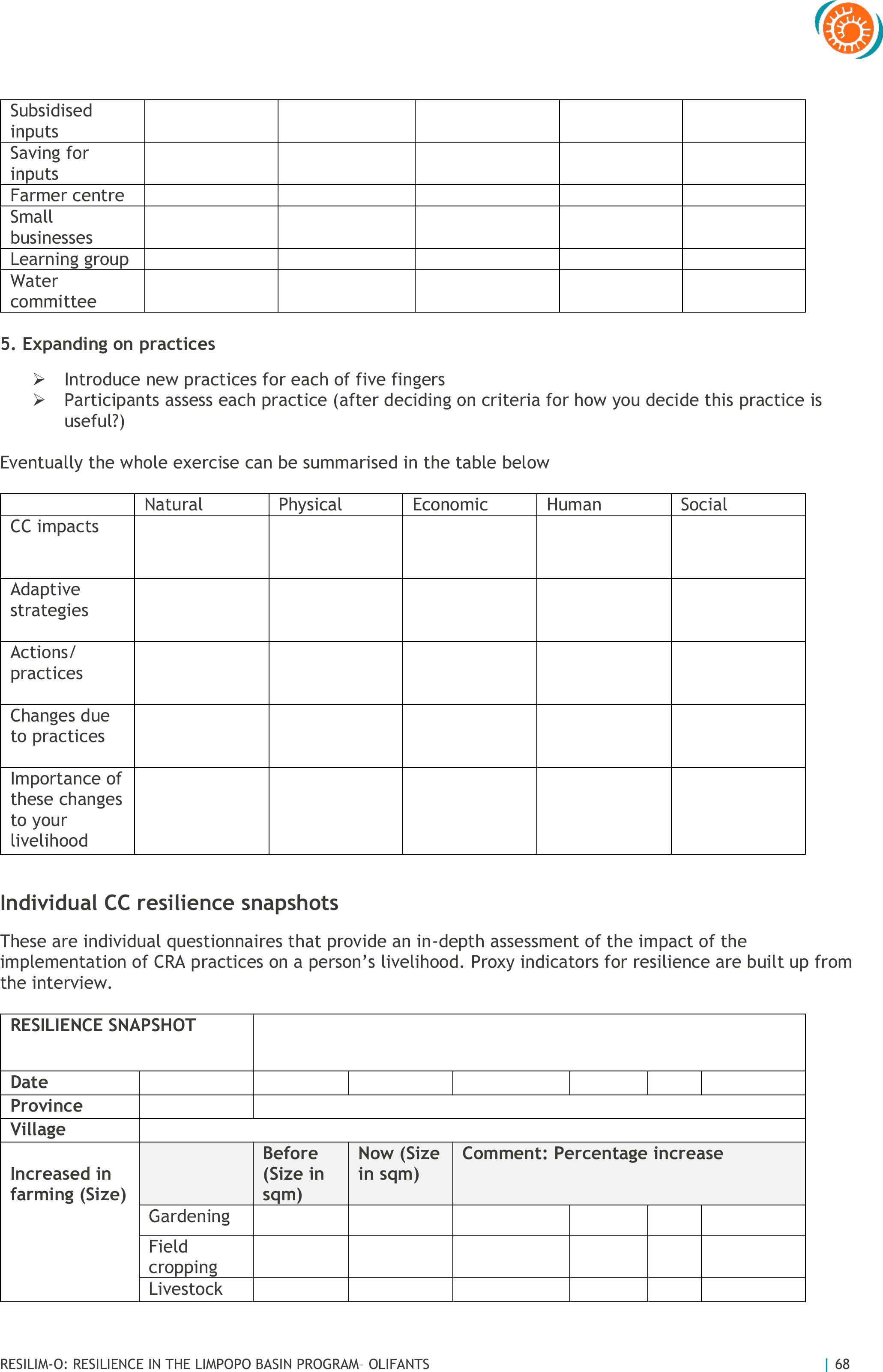
RESILIM-O: RESILIENCE IN THE LIMPOPO BASIN PROGRAM–OLIFANTS
| 68
Subsidised
inputs
Saving for
inputs
Farmer centre
Small
businesses
Learning group
Water
committee
5. Expanding on practices
➢Introduce new practices for each of five fingers
➢Participants assess each practice (after deciding on criteria for how you decide this practice is
useful?)
Eventually the whole exercise can be summarised in the table below
Natural
Physical
Economic
Human
Social
CC impacts
Adaptive
strategies
Actions/
practices
Changes due
to practices
Importance of
these changes
to your
livelihood
Individual CC resilience snapshots
These are individual questionnaires that provide an in-depth assessment of the impact of the
implementation of CRA practices on a person’s livelihood. Proxy indicators for resilience are built up from
the interview.
RESILIENCE SNAPSHOT
Date
Province
Village
Increased in
farming (Size)
Before
(Size in
sqm)
Now (Size
in sqm)
Comment: Percentage increase
Gardening
Field
cropping
Livestock

RESILIM-O: RESILIENCE IN THE LIMPOPO BASIN PROGRAM–OLIFANTS
| 69
Trees nat
resources
Increased
diversity in
farming
Y/N
before
Y/N now
Comment:
Gardening
Field
cropping
Livestock
Trees, nat
resources
Increased
diversity (1)
Manage
ment
and
practices
before
No
b4
No
now
What has
changed;
new crops
What has
changed;
new
practices
What has
changed;
, new
managem
ent
Gardening
Field
cropping
Livestock
Trees nat
resources
Types
BEFORE:
Quantity
(KG, No)
NOW:
Quantity
(KG,No)
Percen
tage
increa
se
Increased
productivity
Gardening
(Amount in
kgs/tonnes,
10,20,50kg
bags/containers,
no of meals (for
a family)
Field
cropping
Livestock
Trees nat
resources
Increase
Access
Inc RWH
Inc water
holding
inc water
productivit
y
(irrigation)
SCALE
0= same or worse than
before; 1= somewhat
better than before, 2=
much better than before
Income
before
(ave
Income
now
(Ave
monthly
Comment
s
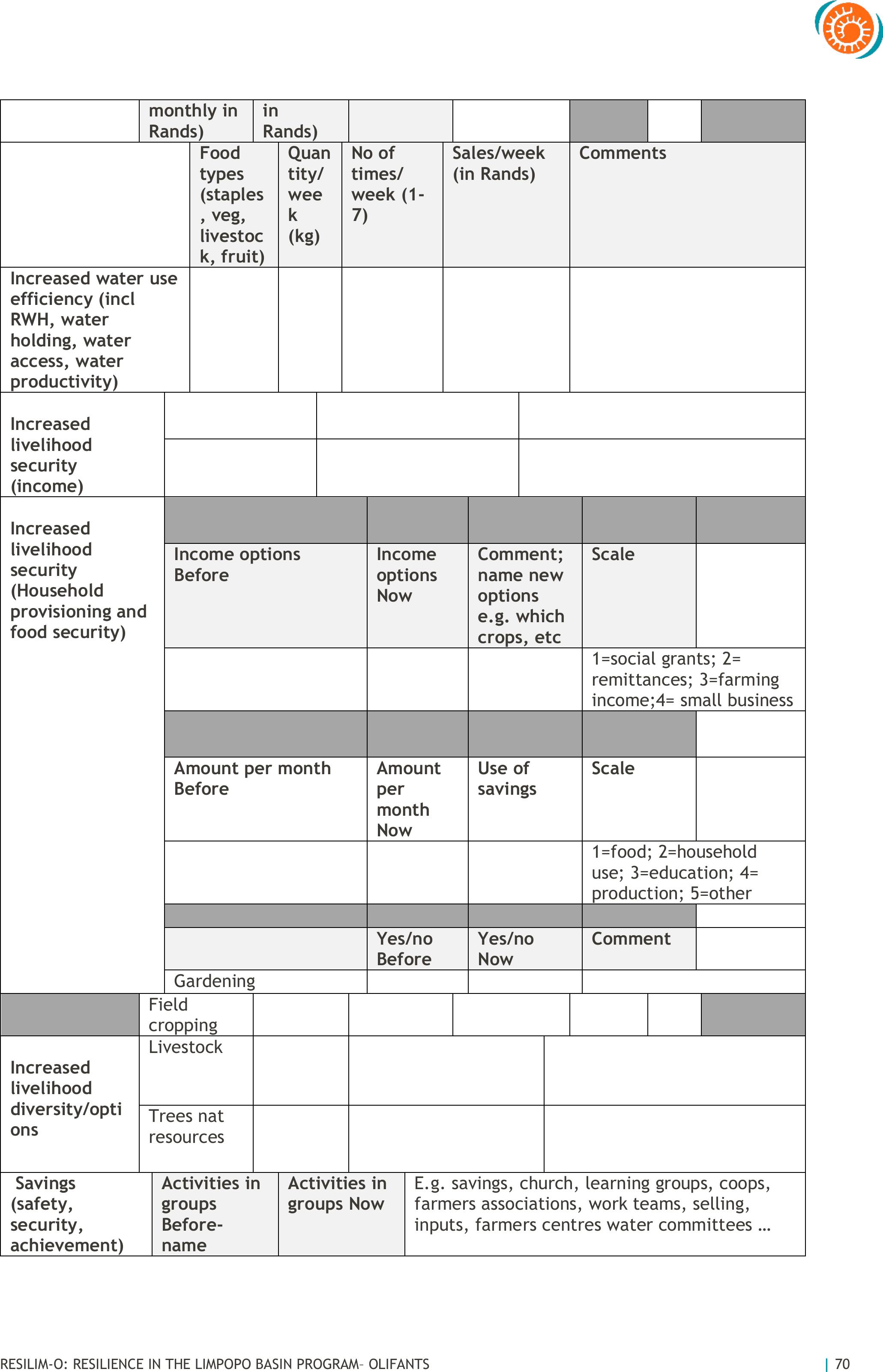
RESILIM-O: RESILIENCE IN THE LIMPOPO BASIN PROGRAM–OLIFANTS
| 70
monthly in
Rands)
in
Rands)
Food
types
(staples
, veg,
livestoc
k, fruit)
Quan
tity/
wee
k
(kg)
No of
times/
week (1-
7)
Sales/week
(in Rands)
Comments
Increased water use
efficiency (incl
RWH, water
holding, water
access, water
productivity)
Increased
livelihood
security
(income)
Increased
livelihood
security
(Household
provisioning and
food security)
Income options
Before
Income
options
Now
Comment;
name new
options
e.g. which
crops, etc
Scale
1=social grants; 2=
remittances; 3=farming
income;4= small business
Amount per month
Before
Amount
per
month
Now
Use of
savings
Scale
1=food; 2=household
use; 3=education; 4=
production; 5=other
Yes/no
Before
Yes/no
Now
Comment
Gardening
Field
cropping
Increased
livelihood
diversity/opti
ons
Livestock
Trees nat
resources
Savings
(safety,
security,
achievement)
Activities in
groups
Before-
name
Activities in
groups Now
E.g. savings, church, learning groups, coops,
farmers associations, work teams, selling,
inputs, farmers centres water committees …

RESILIM-O: RESILIENCE IN THE LIMPOPO BASIN PROGRAM–OLIFANTS
| 71
Increased
growing
season
Information
used to choose
activities
Before
Informatio
n used to
choose
activities
Now
E.g. Other community members, learning in
groups, written info, radio, facilitators,
extension officers, etc
E.g. savings, church, learning groups, coops,
farmers associations, work teams, selling,
inputs, farmers centres water committees …
E.g. Other community members, learning in
groups, written info, radio, facilitators,
extension officers, etc
Collaborative
actions/social
agency
SCALE:0=less positive about the future; 1=the
same; 2=more positive about the future; 3=much
more positive
Collaborative
actions/social
agency
SCALE:0=less positive about the
future; 1=the same; 2=more
positive about the future;
3=much more positive
Rate your mindset
Before
Rate your
mindset now
Informed
decision
making
SCALE:0=less positive about the future; 1=the
same; 2=more positive about the future; 3=much
more positive
Informed
decision
making
SCALE:0=less positive
about the future; 1=the
same; 2=more positive
about the future;
3=much more positive
Positive
mindsets